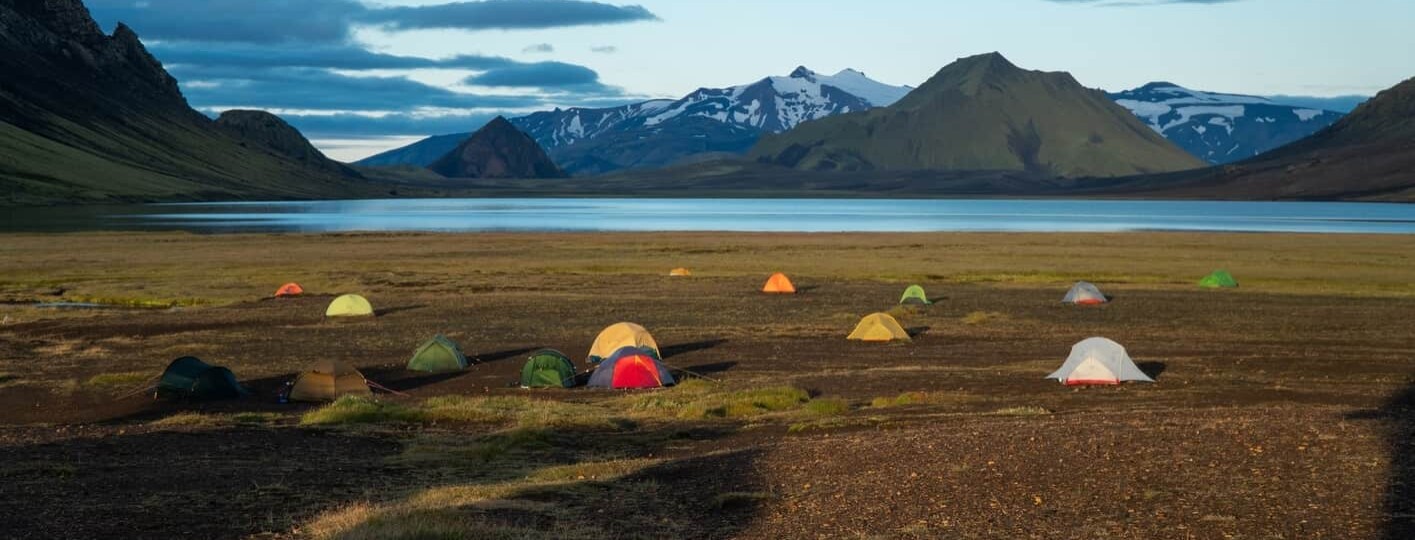

Ultimate Guide to Camping in Iceland + Campgrounds Map
Home | Travel | Europe | Iceland | Ultimate Guide to Camping in Iceland + Campgrounds Map
Going camping in Iceland is one of the best ways to immerse yourself in the country’s natural environment, and it’s the cheapest way to travel around the island. However, there are certain rules you must follow, so it’s a good idea to review some Iceland camping tips .
We run Iceland photo tours every year and always take a few days before or after the tour to camp on the island, so we’ve had the opportunity to visit many campsites in Iceland .
Besides, since there are so many things to do in Iceland , saving money on your accommodation allows you to do more guided tours and other paid activities, something I always recommend!
If you want to enjoy an Iceland camping trip , keep reading because in this guide you’ll find:
Iceland campgrounds map
- How the Iceland Camping Card works
Best camping sites in Iceland
- Is wild camping in Iceland legal?
Camping rentals in Iceland
Tips for camping in Iceland
- Camping in Iceland in winter
Things you need to know before camping in Iceland
Camping in Iceland is a unique experience, and you can find official campsites throughout the island. That said, wild camping in Iceland is prohibited in most cases.
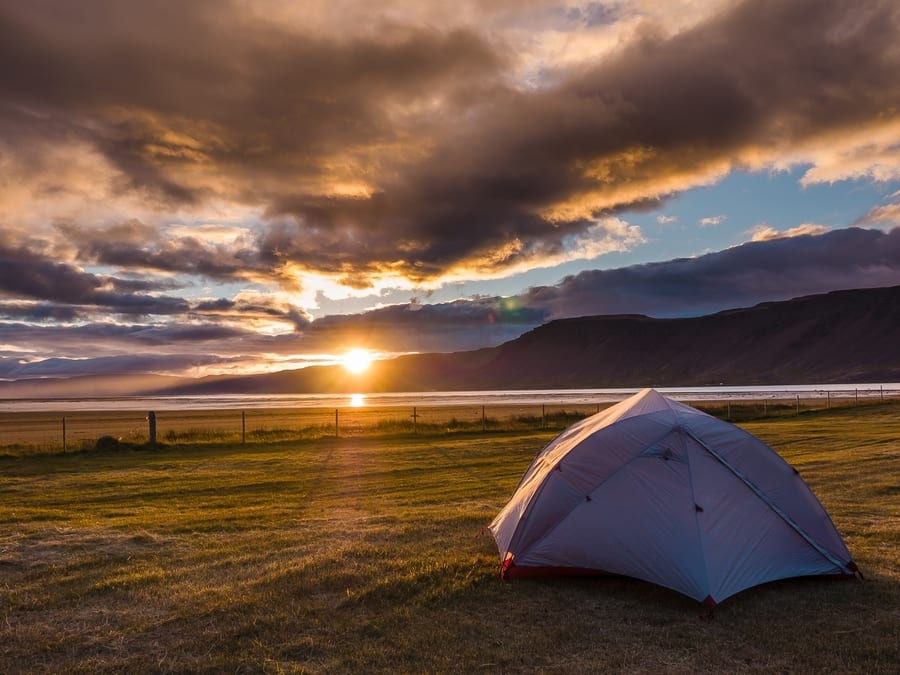
If you go during peak season, it’s best to reserve a campsite in advance, as they fill up quickly in the summer. Also, if you’re going to spend most of your time at Iceland’s campsites , it’s worth it to get a Camping Card , as it’ll save you a lot of money.
Another thing to keep in mind is that many campgrounds in Iceland are closed during the winter; most are only open from May to September. Fortunately, some are open year-round, so I suggest doing some research beforehand if you plan to travel around Iceland in a camping van or RV in the winter months. Overnight parking is illegal outside of the designated campsites .
If you are not quite sure where to camp in Iceland , I suggest keeping the following map close at hand.
This Iceland campgrounds map will show you all the sites that are open year-round, as well as the ones that are open only during the summer months. You’ll also be able to see all the Iceland campsites included in the Camping Card.
As you’ll see, there are places to camp in Iceland all around the island, so you’ll have no problem finding a spot to spend the night, whether it’s in a tent, campervan, or RV .
Iceland Camping Card
The Iceland Camping Card is designed for those who want to camp for the entirety (or most) of their trip. With this card, you’ll have access to dozens of campgrounds in Iceland for up to 28 days.
You can use this card if you’re camping in an RV, campervan, or tent. Moreover, each card covers 2 adults and up to 4 children under 16, so it’s ideal for couples and families.
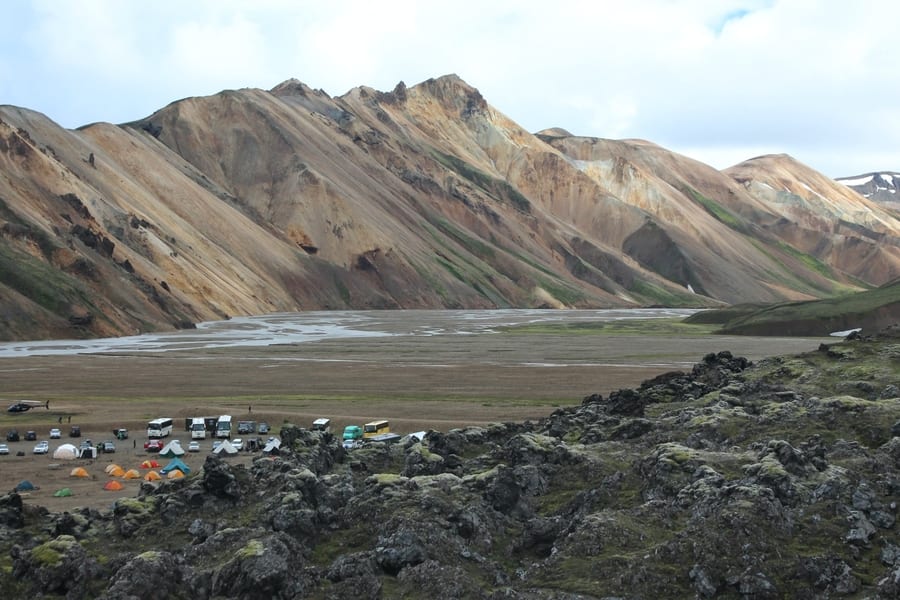
While there are tons of advantages to the Camping Card, be aware that it’s only valid from May to mid-September, when all of Iceland’s campsites are open.
The Camping Card costs about USD 195, and campgrounds in Iceland tend to charge about 1000-2000 ISK (USD 8 -16) per person/night. So, as long as two adults are camping for 5-10 days, (for families it’s even fewer days), the card is cheaper than booking individually at each campground .
Although there are many campsites in Iceland , we have a few favorites that we know you’ll love. These are the best camping sites in Iceland :
- Hellisandur Campsite : Located within the Sandahraun lava field on the Snaefellsnes Peninsula, this campground has toilets, showers, sinks, and electricity. The best thing about the Hellisandur campsite is its location; it’s close to the Snæfellsjökull glacier, which is surrounded by great hiking trails and beaches.
- Geysir Campsite : This campsite, located in the Golden Circle , is surrounded by nature. It’s also very close to a geothermal area, so it’s one of the best places to camp in Iceland . It has showers, toilets, electricity, and a children’s area, making it perfect for families.
- Brennisteinsalda Campsite : Another Icelandic campsite that we’ve been to and highly recommend is the main campsite at Landmannalaugar, in the Icelandic Highlands . It’s one of the best places to camp, as the spectacular landscape here encompasses beautiful rhyolite mountains, canyons, lava rock formations, volcanoes, and hot springs. However, it’s only open in the summer and you need a 4×4 to get there because it’s in the Highlands.
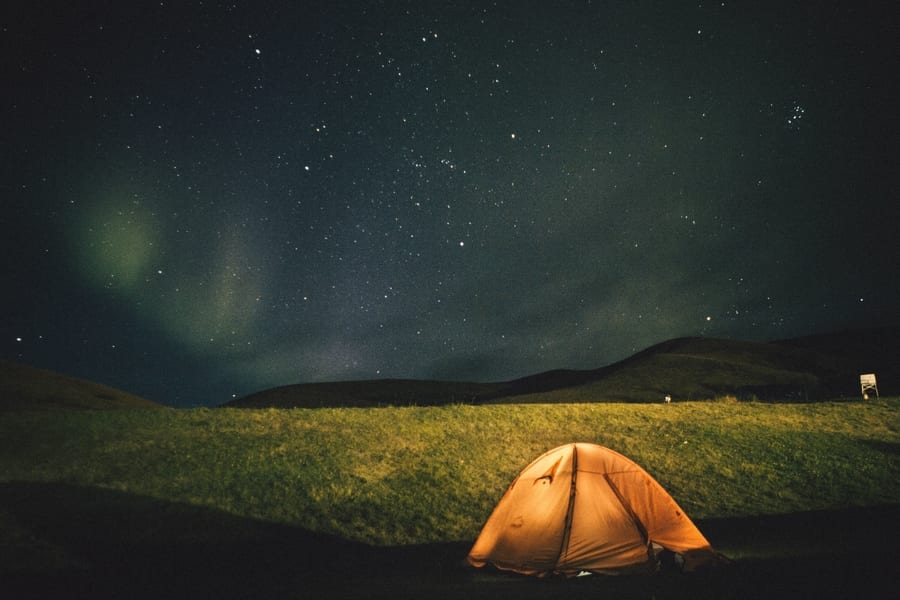
- Skógar Campsite : Situated right in front of the Skógafoss waterfall, it’s no surprise that this is one of Iceland’s most popular campgrounds. If you get a good spot, you can listen to the roar of the waterfall as you fall asleep. Whenever we have the chance, we always go to this campsite. Not only is Skógafoss one of the must-see attractions in Iceland , but the grounds also have toilets and electricity.
- Skaftafell Campsite : If you’re looking for a place to camp in Iceland with good facilities, I recommend this campsite in Skaftafell National Park. The campground has a restaurant, bathrooms, showers, electricity, and other amenities. The location is also great, as there are several nearby trails, like the one to Kristínartindar via the Svartifoss waterfall, which is considered one of the best hiking trails in Iceland .
- Höfn Campsite : Finally, you’ll find this campsite in Höfn, near Stokksnes Beach. It also has toilets, a shower, and electricity, and it’s located near the municipal swimming pool. Best of all, it has a common kitchen, so you can prepare your own food there. That said, if you’re in Höfn, you must try the lobster baguette at Hafnarbúðin, my favorite restaurant in all of Iceland .
Free camping in Iceland – Is wild camping in Iceland legal?
Keep in mind that in 2015 the Icelandic Department of the Environment announced that free camping in Iceland was prohibited outside of designated areas if traveling via RV, motorhome, or campervan.
Those who are camping in a tent may spend the night in non-designated areas if there aren’t any campsites nearby, as long as they’re not staying in a protected area or private property without the owner’s permission.
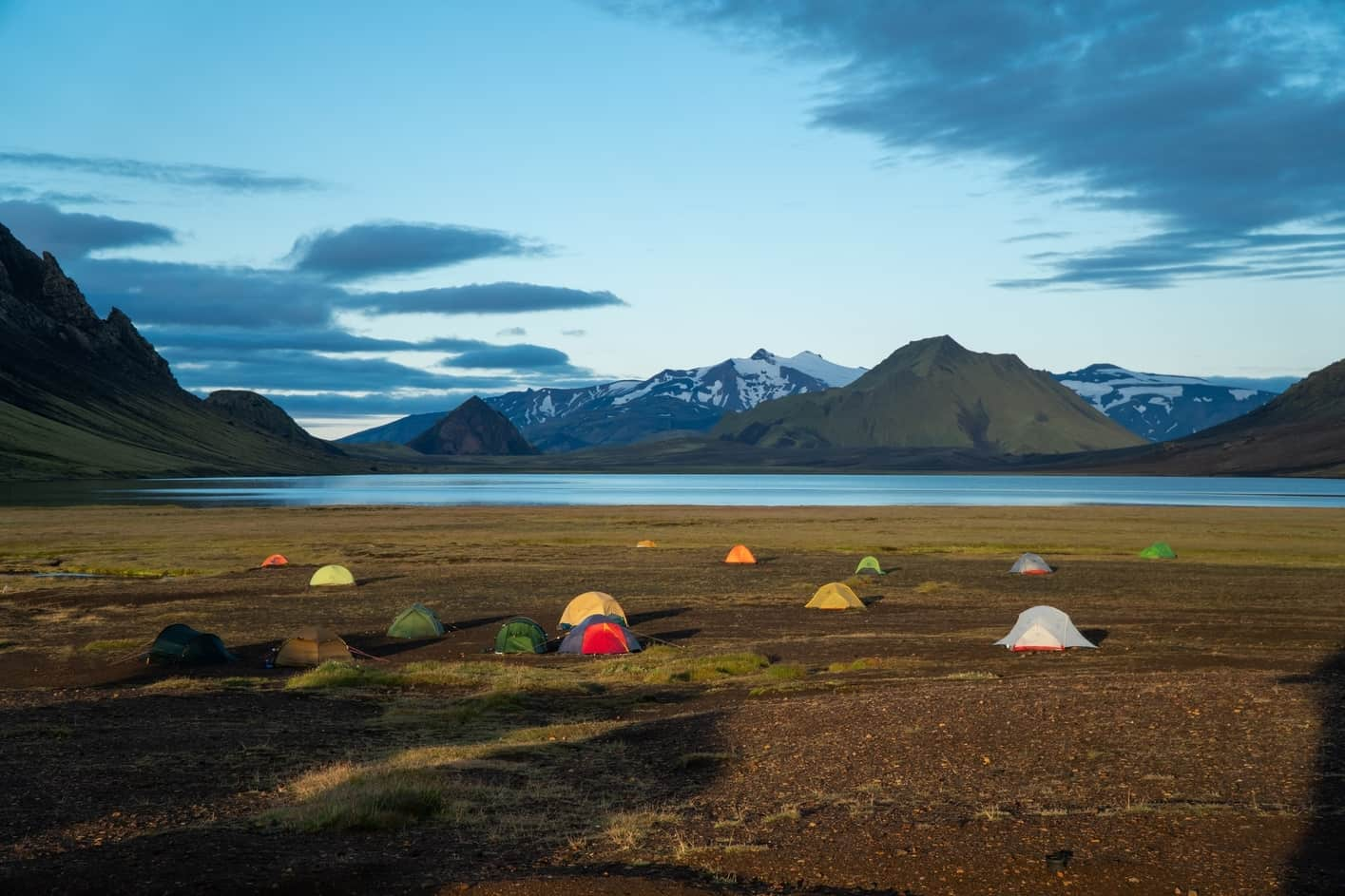
If you’re traveling in an RV or campervan and want to spend the night in it, you must be staying at an official Icelandic campsite . Besides, you can camp on privately-owned land if you have permission from the owner.
Despite these regulations, there are many campgrounds in Iceland spread throughout the island, as you have seen on our map. So don’t worry; you will have no problem finding a place to stay. Just be sure to do your research and reserve your spot in advance, especially if you’re camping in Iceland in summer , the peak season.
Protected areas where it is illegal to camp in Iceland
If you want to go wild camping in Iceland with a tent, make sure that you’re not spending the night in one of these protected areas since it’s illegal:
- Blábjörg á Berufjarðarströnd
- Bringur í Mosfellsdal
- Dimmuborgir
- Dyrhólaey: You can camp and stay overnight only with permission from the Icelandic Department of the Environment.
- Fjallabak: You can camp and stay overnight only in marked areas. Hikers can camp alongside marked trails. Elsewhere, you can camp or stay overnight only with specific permission from the Icelandic Department of the Environment.
- Grábrókargígar í Norðurárdal: Camping and overnight stays are only allowed with permission from the Icelandic Department of the Environment.
- Herðubreiðarfriðland: You can camp in marked areas. Elsewhere, permission from the Icelandic Department of the Environment is required.
- Hverfjall/Hverfell
- Ingólfshöfði: Camping and overnight stays are only allowed with permission from the Icelandic Department of the Environment and local supervisors.
- Mývatn: Camping and overnight stays are not permitted outside of designated camping areas.
- Seljahjallagil, Bláhvammur, Þrengslaborgir and its surroundings
- Skógafoss: Camping and overnight stays are not permitted outside of designated camping areas.
- Skútustaðagígar
- Snæfellsjökull National Park: Hikers must obtain permission from the National Park. Otherwise, camping and overnight stays are not permitted.
- Ströndin við Stapa og Hellna
- Vatnajökull National Park: Tents and campervans are permitted at the campsite. Outside of the camping area, you can camp with a traditional tent for one night. Groups of three or more tents, however, must ask the ranger for permission.
- Jökulsárgljúfur: Camping and overnight stays are not permitted outside of designated camping areas. However, camping is allowed in the Skaftafell Mountains above elevations of 1,300 feet and at the mouth of the Kjós River.
- Þingvellir National Park: Camping and overnight stays are not permitted outside of designated camping areas.
Iceland camping packing list
If you’re going to camp in Iceland , these are the essentials that you should bring:
- 4 seasons tent (we use this one )
- Special insulating canvas for the floor (we use this one )
- Winter sleeping bag (we use this or these for hikes)
- Inflatable mats (we use these )
- Light for the tent (we like this one )
- Campingaz stove (we travel with this one )
- Warmers (my must-haves are these ones for hands and feet )
- Winter clothes (in our guide on how to pack a backpack for a long camping trip, I share more tips on what kinds of clothes you need for Iceland )
We’re avid campers who love the outdoors, so we’ve got everything you need to camp in Iceland comfortably. Of course, when traveling to other countries, you can’t take everything along for the journey. In these cases, you might want to consider the option of Iceland camping rentals .
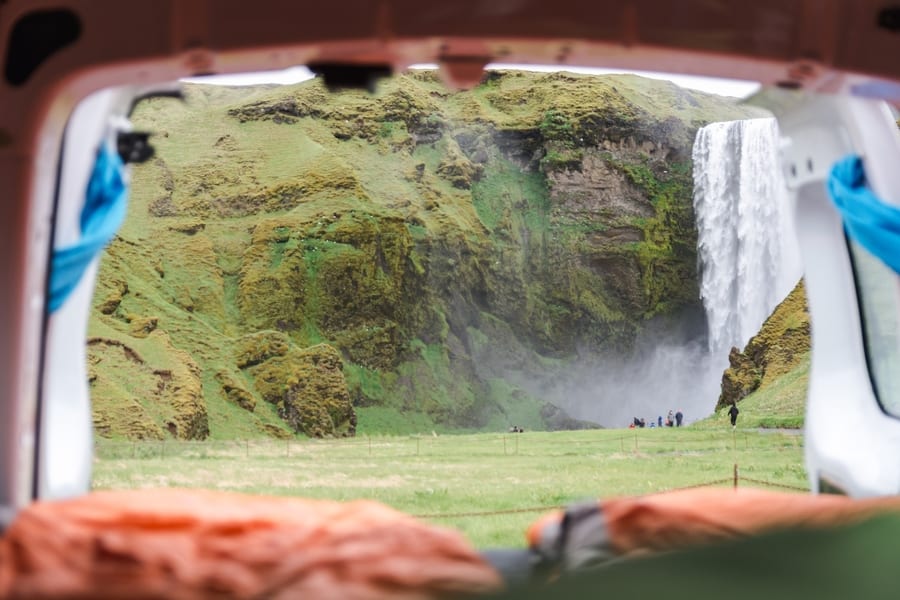
If you’re going to explore this country, I recommend visiting this website , where you can rent sleeping bags, gas stoves, tents, kitchen equipment, hiking apparel, GPS units, and more. I strongly encourage you to rent anything that you can’t carry with you or that would be too cumbersome on an airplane or in your luggage .
The experience of camping in Iceland can be incredible, but if you’re not used to sleeping outdoors and find yourself in unfavorable conditions, it can be a real nightmare. To avoid an uncomfortable situation like that, I have a few tips to help you fully enjoy your Iceland camping trip :
- If you’ve never camped before, I recommend looking for an Iceland campsite that’s near a hotel just in case you find that camping outside isn’t your thing. Also, be sure to check the weather forecast since excessive rain and wind can make the experience less enjoyable.
- One of the things worth taking with you is proper insulation for your tent . Iceland is a country with a variable climate that’s not always predictable, although it tends to be humid. If you don’t want to wake up soaked, you’d better get good insulation. In a pinch, you can use newspapers and put them under your tent.
- If you are going to camp in Iceland during the peak season, reserve a spot in advance , especially if you plan to stay at one of the more popular campgrounds.
- Most camping sites in Iceland require you to pay to use the shower, so keep some spare change on you .
- Remember to bring an adapter for the car so you can charge electronic devices, like your camera and phone.
- Even if you go camping in Iceland in summer , you should bring warm clothes and warmers for your hands and feet .
- Be very careful if you camp in an area where there are horses . A friend of ours came back from photographing the Northern Lights to find their tent had been trampled.
- If you can’t make it without your morning coffee or tea, or if you plan to bring camping freeze-dried food, rent or bring a Jetboil so you can heat some water .
- There are a few essential apps and websites that you should use while camping in Iceland . Use Vedur.is to see the weather forecast, Road.is to view current road conditions, Maps.me to download any maps of Iceland you need, and the My Aurora Forecast app ( Android and iOS ) to know if the KP rises and the Northern Lights are visible.
If you follow these tips, you should have no problem camping in Iceland . Of course, if you find that you’re uncomfortable and not enjoying yourself, there’s nothing wrong with heading to a hotel. I’ve even got a guide to the best places to stay in Iceland .
Campervan – Easy camping in Iceland in winter
Camping in Iceland in winter isn’t the best option, as the winter months are quite harsh. Besides, most campgrounds close for the winter, so you could find yourself without a place to pitch your tent.
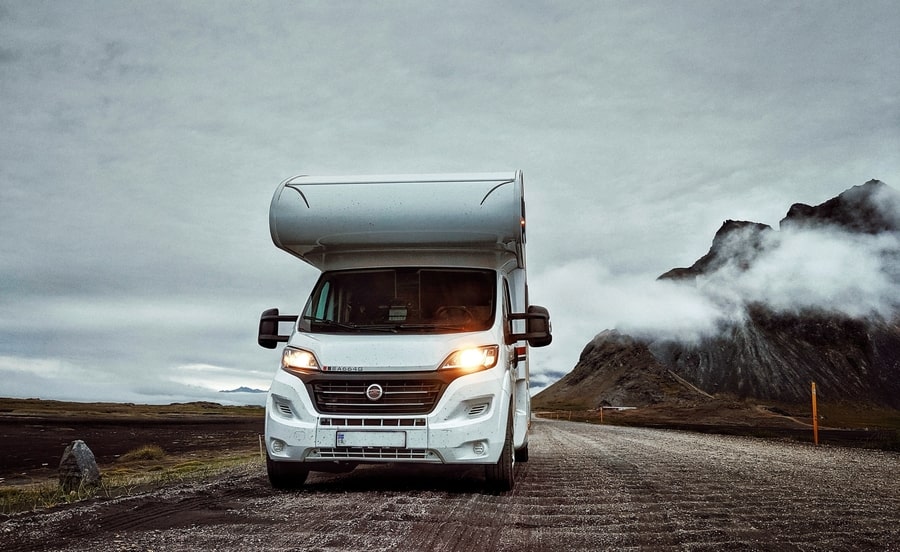
If you’re going to travel to Iceland in the winter and you’d like to go camping, it’s best to do so in an RV or campervan so you won’t have to sleep outside in harsh weather. Take a look at our guide on how to rent a car in Iceland , and use the website below to search for a rental that fits your travel dates:
I also recommend reading our guide on how to drive in Iceland since, in winter, you’ll have to take extreme precautions due to the state of the roads. There are even some areas, like the Highlands, that close down during this time of year.
As a quick tip, check that your vehicle has proper snow tires and 4-wheel drive. Also, remember to regularly check the weather forecast and road conditions. Lastly, make sure that the campsites you plan on visiting will be open during the winter months.
FAQ – Camping in Iceland
Here are the most frequently asked questions about how to camp in Iceland . Of course, if you have any other questions, you can leave me a comment at the end of this article.
Is camping in Iceland free?
No, camping in Iceland is not free. Since 2015, free camping has been prohibited in Iceland with a motor vehicle like an RV or campervan, and in most parts of the country, even if you camp in a tent. As a result, travelers are forced to stay at designated campsites in Iceland , and each campground charges a nightly price per person.
How much does it cost to stay at a camping site in Iceland?
Most camping sites in Iceland charge anywhere from 1000-2000 ISK (USD 8.30-16.60) per person per night.
Can you camp anywhere in Iceland?
You can camp outdoors in Iceland with a tent for one night only, but only if you’re nowhere near a campground and you’re not in a protected area or on private property.
Is wild camping in Iceland permitted?
No, wild camping in Iceland has been banned since 2015. As an exception, if you’re camping in a tent and there are no campgrounds nearby, you can spend the night, as long as it’s not a protected area or private property.
When is the best time to camp in Iceland?
The best time to go camping in Iceland is during the summer months when the temperatures are milder, and all the campgrounds are open.
Can you go camping in Iceland in winter?
If you want to camp in Iceland in the winter , you can only do so at designated campsites. That said, it’s not advisable to camp in a tent, and RVs and campervans are prohibited outside of official campgrounds.
What is the Camping Card?
The Camping Card is a card that lets you stay at dozens of campsites in Iceland for up to 28 days. It costs USD 195 and covers up to 2 adults and 4 children under 16.
That’s all from me! I hope this guide helps you make the most of your Iceland camping trip. If you have any questions, you can leave a comment below, and I’ll do my best to help. Enjoy exploring the campsites in Iceland !
Ascen Aynat
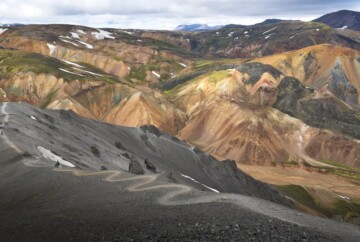
2 replies on “ Ultimate Guide to Camping in Iceland + Campgrounds Map ”
I could not find the guide for the map to know which campsites take the camping card. Can you please direct me as to the legend
You can find a map with all the campgrounds included in the Iceland Camping Card here .
Let me know if you have any other questions, Ascen
Leave a Reply Cancel reply
Your email address will not be published. Required fields are marked *
This site is protected by reCAPTCHA and the Google Privacy Policy and Terms of Service apply.

You are using an outdated browser. Please upgrade your browser or activate Google Chrome Frame to improve your experience.

- Trip Styles
- Destinations
- Iceland Hiking Trips

- Global Hiking Vacations
ICELAND HIKING TOURS
Whether you're interested in a lodge-based, hut-based, or camping-based trek, our Iceland hiking tours have something for everyone!
There’s nothing quite like an Iceland hiking vacation! We provide a variety of ways to discover the magic of Iceland on foot. Our offerings include hut to hut treks (vehicle assisted), hut to hut backpacking trips (self supported), and Best of Iceland Tours (lodge-based and camping-based). Our trips are all-inclusive packages (with the exception of a few select in-town meals) that take the worry and logistics out of your hands so you can thoroughly focus on enjoying all Iceland has to offer. From lodging in Reykjavik the first night through departure on the final day, we’ve got you covered!
Check out our list of offerings below, and feel free to call us at 800-715-HIKE (4453) to learn more or book your spot today!
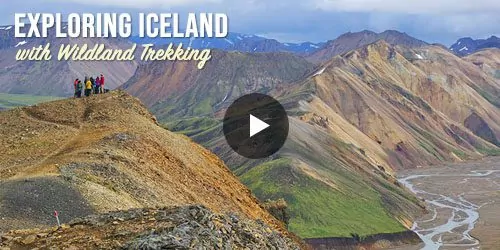
World-Class Hiking Destinations

Iceland Hut to Hut Hiking Tours
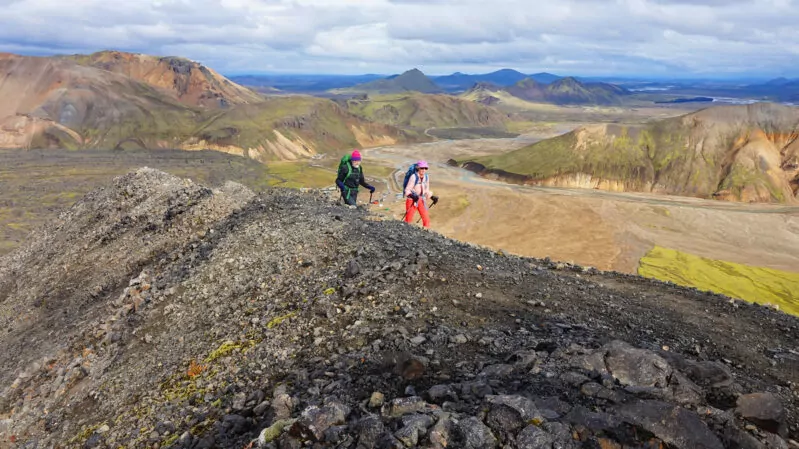
Iceland Inn-based Tours
All iceland hiking trips trips ( 4 results), filter trips.
Trip Length
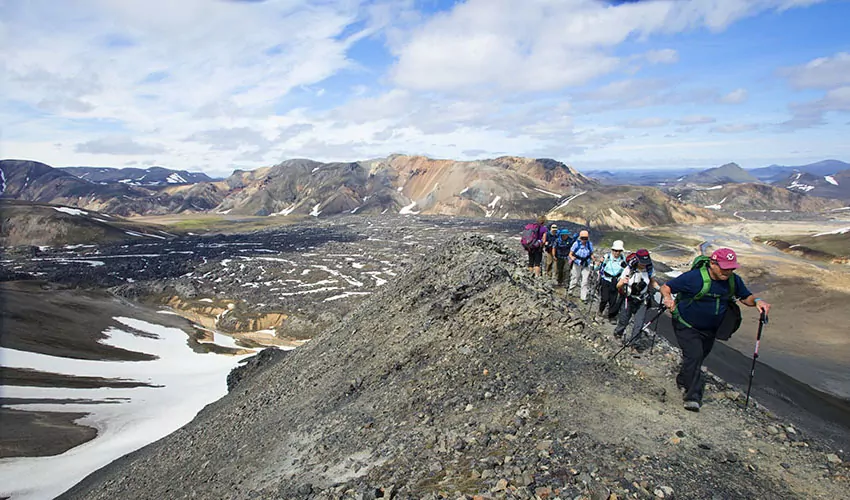
Iceland’s Laugavegur Trail
Best of Iceland Backpacking
Best of Iceland Lodge Based
Iceland Glaciers and Northern Lights

WHY HIKE ICELAND WITH WILDLAND?
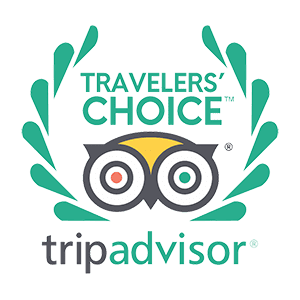
1. TOP RATED TREKKING COMPANY
Hike with a proven adventure travel company that knows how to provide a premier travel experience! Wildland has been leading hiking tours since 2005. Since that time our all-inclusive, expert-led adventures have earned more than 4,000 online reviews, over 99.5% of those being 5 stars.
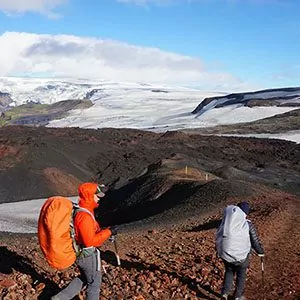
3. ALL-INCLUSIVE TRIPS
We want you to be able to put all your energy into enjoying Iceland! For this reason, our trips are all-inclusive. Our Iceland hiking packages include local transportation, pre-trek and post-trek lodging, most meals, mountain hut reservations, luggage transfers via 4×4 vehicles on some trips and more.
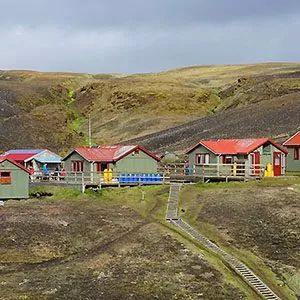
5. EXCEPTIONAL ACCOMMODATIONS & GEAR
Our Iceland hiking trips are based in lodges, mountain huts and/or campgrounds. We carefully select these accommodations to put you right in the action and provide a great lodging experience. The mountain huts are cozy, rustic and basic, but the settings of these backcountry structures are stunning. And the gear we provide is top-of-the-line from major, award-winning brands.
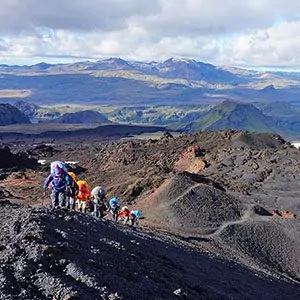
2. ALWAYS SMALL GROUP TRIPS
Iceland is a breathtaking destination that can be dramatically accentuated by the right group hiking experience. Or if visitors feel like they’re being herded around like cattle, it can be quite the opposite. Our trips prioritize quality over profit and are capped at 12 guests and 2-3 guides. Our small groups allow Wildland guests to enjoy a personalized journey where each person feels a deeper connection with their guides, the landscape and their overall experience.
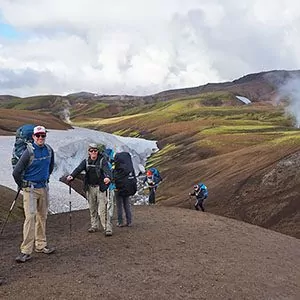
4. LOCAL, EXPERT WILDLAND GUIDES
Approaches to customer service, safety, risk management and professionalism vary wildly depending on the culture and place you’re visiting. Imagine being able to expect a consistently high quality experience all over the world, yet still enjoying the benefit of local guides who can help you experience and learn about the area’s history and culture. That is what we provide at Wildland – local, expert guides who are part of the Wildland Team trained to meet our very high quality and safety standards. Our guests experience a consistently great product across 11 countries, yet still get to benefit from the incredible privilege of having local guides.
Iceland Introduction Video
Check out a video introduction to our Iceland trekking and backpacking program. Iceland is home to profoundly dramatic landscapes, and one of the very best ways to make the most of your time in the "Land of Fire and Ice" is to join a hiking adventure.
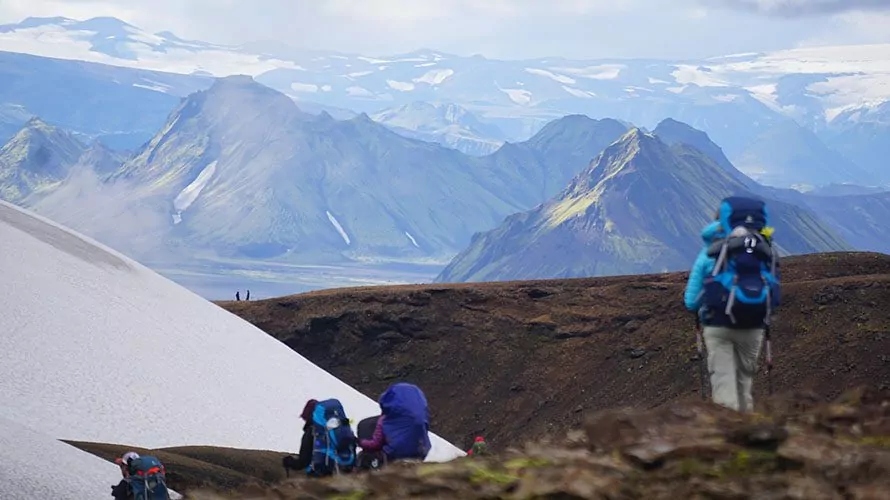
MORE ABOUT ICELAND HIKING VACATIONS
Why an iceland hiking vacation.
Iceland has become one of the world’s most popular trekking destinations, and for good reason. It is a charming island with wonderful, clean and safe cities; jaw-dropping mountain scenery; and backcountry huts that allow for cozy wilderness accommodations. What most astonishes our Iceland guests is the diversity of scenery they experience: towering peaks, volcanoes, black sand deserts, geysers, hot springs, waterfalls, glaciers, ocean views, raging rivers, mountain lakes and more!
SHOULD I GO WITH AN ICELAND HIKING COMPANY?
Joining an Iceland hiking tour is something many visitors choose to do, and many choose to hike Iceland on their own. The advantages of trekking with an Iceland hiking company, like Wildland Trekking, are many:
- We take care of all logistics, including permits, hut reservations, hotel accommodations in Reykjavík, local transportation, most meals, gear, and more. Iceland is a very expensive country with limited numbers of hotel rooms that fill up way in advance, so joining an all-inclusive tour, like Wildland Trekking’s trips, allows you focus 100% on hiking and trust everything is taken care of.
- Increased level of safety by hiking with an expert, local Iceland trekking guide
- Learn about the natural and cultural history of the landscapes you’re hiking through (Iceland has fascinating history!)
- Enjoy wonderful backcountry cuisine prepared by your guide
- Have supplies driven into certain huts to reduce pack weights (certain trips only)
THE WILDLAND ICELAND EXPERIENCE
At Wildland Trekking we provide a variety of Iceland hiking tours – hut to hut backpacking trips, hut to hut trekking tours, and our Best of Iceland Lodge-based and Camping tours. On all of these trips we provide nearly everything so you can focus entirely on enjoying all Iceland has to offer. Our guides are exceptional and award-winning professionals (see our Online Reviews page) who will show you the best trekking Iceland has to offer and help you learn a tremendous amount about the country on the way. Our gear is top-notch and our meals are amazing. We are the hiking experts, and there’s significant benefit in going with the experts.
wildland Wires
Sign up to receive our exclusive Wildland Wire emails and stay up to date with Wildland Trekking's promotions, discounts, contests, outdoor tips and tricks, trip reports and more!
Iceland Tour & Vacation Packages

Greenland’s the icy one; Iceland’s the green one. But remember this: they don’t call part of it the Golden Circle for nothing.
Calling all nature lovers, adventure seekers and fearless travelers. Iceland may be cold, but that’s the point—you’ll get to see all the glaciers, geysers and geothermal wonders you can handle. Discover a land of natural color: hues of azure at the Blue Lagoon and the icy Jokulsarlon, shades of green on the rolling hills framing Skogafoss and the striking black sand beaches that hug the coast. Not to mention the magical aurora borealis that dance across the sky! From uncovering Viking tales and bathing in steamy springs to cruising past icebergs and exploring quirky farm towns, Iceland is island life like no other.
Our Iceland trips
Let's create an exclusive trip for your group.
Iceland tour reviews
Filter by rating
Iceland Discovery
Iceland's Golden Circle in Depth
Articles of Iceland
Chill out: Beat the summer heat with these cool escapes
Why 2024 is the best year to see the northern lights
How the Icelandic hot dog became an international icon
Iceland’s Folklore: 4 mythical creatures that make the scenery come alive
Top 12 things to do in Iceland
6 of the best hikes in Iceland
10 ways to get closer to nature with Intrepid
In sickness and in health: How I ended up getting married on an Intrepid Iceland trip
We also travel to
Iceland at a glance, capital city.
Reykjavik (population approximately 123,000)
Approximately 372,520
(GMT) Monrovia, Reykjavik
CALLING CODE
Electricity.
Type C (European 2-pin) Type F (German 2-pin, side clip earth)
Learn more about Iceland
Culture and customs.
Similar to many other parts of Europe , Iceland has rules in place to help preserve its culture and geographic isolation is also a factor in developing and preserving the country’s cultural qualities. Independence, self-sufficiency and a strong work ethic – traits that allowed this northern island to flourish in challenging conditions – continue to be highly valued today.
Icelandic culture and customs are full of myths and legends, many with a connection to Christian and pagan values. Folk tales of elves, gnomes, fairies and trolls still circulate, and whether or not the locals continue telling these to unlock the secrets of the past, or simply in jest, they’re definitely worth listening to. But when news outlets report on road plans being changed to avoid disrupting an elfin church, it’s easy to believe that this unusual country and its magical landscapes are a product of what lies ‘hidden’ in its mysterious depths.
Today, Iceland is a highly modern and progressive society. It is consistently rated as having the smallest gender pay gap and strong LGBTQIA+ rights representation in the parliament and media. It’s also one of the greenest countries in the world, with almost all energy coming from renewable resources such as hydropower and geothermal.
Read more about Iceland's History and Folklore
History and government
Pre-modern history.
This island nation was settled by Vikings in the ninth century, with much of the early literature recognizing Norse sailor Ingolfur Arnason as the first settler of Iceland, founding Reykjavik in AD874 along with his wife and brother. Icelanders remain proud to this day of their Viking heritage. The Icelandic language, for example, is so similar to the Old Norse spoken during Viking times that Icelanders can still read and understand the original Icelandic sagas.
A book of settlements titled Landnamabok, compiled in the 12th century, documents the names and other details of nearly 400 original settlers of Iceland who arrived in the ninth and tenth centuries. The document tells of a Norse Viking called Floki who sailed to Iceland for fishing and farming, however, due to his livestock not surviving in the conditions, had to return to his home in Norway. After heading up a mountain and looking over a fjord full of sea ice, he named this land Iceland.
In AD930, an Icelandic General Assembly was established and was deemed a Christian settlement less than a century later. Settlers and slaves brought to Iceland by Scandinavians were of Irish and Norse descent, and although some still debate which communities influenced the identity we now know to be Icelandic, the first distinctive text documenting ‘Icelandic-ness’ is said to be a rule book of sorts – the First Grammatical Treatise.
20th century and today
After long periods under Norwegian and Danish rule, Iceland was recognized as a sovereign state in 1918. On 17 June 1944, Iceland became an independent republic. It has a multi-party parliamentary system and a written constitution. The parliament is still called Althingi after its medieval General Assembly.
Many of Iceland’s major industries stem from its location and surrounding natural resources. Tourism aside, fishing and seafood products make up much of the country’s exports and employ a majority of the workforce along with agriculture and farming. Recent investment in greenhouses and geothermal energy has seen Iceland become increasingly self-sufficient, growing products that usually do not fare well in icy climates, such as potatoes, tomatoes and potted plants. Other food is imported along with many consumer goods.
Eating and drinking
Flanked by the ocean and inhabited by almost twice the amount of sheep as humans, Iceland understandably boasts a cuisine dominated by seafood and local lamb.
The country’s diet relies on plenty of potatoes and lamb, but seafood trumps all – sourced fresh year-round from the waters of the North Atlantic and Arctic and prepared in a variety of ways. Be sure to try Hardfiskur – a salty fish jerky, best enjoyed buttered.
Sheep and cows are free-range and fed chemical-free diets, making lamb and dairy products exceptionally good here. One of the best ways to enjoy the produce on offer is to warm yourself up from the inside out with a hearty meat soup: a mixture of lamb, root vegetables, herbs, and rice.
Skyr, a popular yogurt that is technically a cheese, is also a must-try in all its variety of flavors. Eat it like the locals do at any time of the day – for breakfast, as a snack, as a dipping sauce, in drink form (called drykkur), or as a dessert topping.
Surprisingly, hot dogs are Iceland’s most iconic fast food. Widely available, a hot dog is probably the cheapest meal you’ll have in Iceland. Order one with all the toppings – sweet mustard, ketchup, raw onions, deep-fried onions, and aioli.
Rye bread (also known as rugbraud) and butter is a common side to most meals in Iceland, but the preferred way of cooking the loaves are quite unique. Traditionally, the bread is buried near a natural hot spring, sprinkled with sugar, and left to gently steam for up to 24 hours. The end result is dense, cake-like bread that has a slightly sweet taste. Enjoy it with a traditional Icelandic soup, smoked lamb, or, of course, fish.
Name a food and chances are Icelanders have tried to add licorice to it. Black licorice is beloved by locals and found in a wide range of desserts and candy bars. During your time here, head to Valdis in Reykjavik to test out a cone filled with salted black licorice ice cream. Even if the weather’s cold, the ice cream joints will be open!
The weird and wacky
Icelanders have a reputation for serving up some of the most unusual food in the world – boiled sheep’s head, fermented shark known as harkarl, ram testicles and smoked puffin to name a few. Although the country’s isolation and harsh winters once meant these foods were eaten out of necessity, today most of these ‘delicacies’ are only prepared to shock tourists. Try if you dare, but we suggest sticking to the common foods that locals eat.
Alcohol can be expensive in Iceland and is best bought at the duty-free shop. Although forms of prohibition existed until 1989, alcohol is now widely available all over the country in state-run liquor stores. If you’re feeling brave, try the local brew, Brennivin – a potent, traditional caraway-flavored schnapps nicknamed ‘black death’.
Read more about what to eat in Iceland
Read more about what to drink in Iceland
Iceland travel highlights
1. explore reykjavik.
Iceland's capital city is totally beguiling, surrounded by volcanic peaks and boasting a vibrant art and nightlife scene. Browse the city’s galleries, explore the colorful street art, dine on fresh lox (traditionally cured salmon), or cycle to the striking cathedral of Hallgrimskirkja – trying to say that after a tipple or two of Brennivin (Iceland's signature spirit) might be tricky! Get stuck into Icelandic culture on our 6 day Northern Lights Escape .
2. Discover the Golden Circle
The Golden Circle is the holy trinity of southern Iceland. This 186-mile (300 km) route is brimming with natural wonders that showcase why so many travelers fall under Iceland's spell. Marvel at the layered cascades of Gullfoss Waterfall, explore the dramatic rift valley in Thingvellir National Park and witness the unpredictable eruptions in Geysir Geothermal Area. Marvel at breathtaking natural landscapes on our 5 day Iceland Express tour.
3. Cruise along Jokulsarlon
It's impossible not to be amazed by the sheer size and beauty of Jokulsarlon, Iceland’s famous glacial lagoon. Enjoy a boat tour along the icy waters where you'll cruise past towering glaciers and witness icebergs of all shapes, sizes and shades of blue drifting into the Atlantic Ocean. Cool down on our 8 day Iceland Discovery tour.
4. Experience life in Akureyri
Soak up the charm of this northern port city – the second-largest city in Iceland. Better described as a big town with lots of character, you'll be won over by its quaint turf homes, rich history and folklore, and the imposing Mount Súlur that looms over the town. Akureyri is also an ideal Northern Lights viewing location between September and April. Explore the streets of Akureyri on our 9 day Premium Iceland tour.
5. Be wowed by Westfjords
Venture off course to the unspoiled, untamed reaches of the Westfjords – without the big crowds. This is a land where mountains meet the sea most dramatically, where waterfalls tumble down into the inky fjords and puffins live along the towering cliffs. If you’re lucky and conditions allow, we might cruise along Látrabjarg (Europe’s largest bird cliff) to see puffins, razorbills, guillemots and more. Adventure through the Westfjords on our 14 day East Greenland and Iceland Northern Lights tour.
6. Bathe in the Blue Lagoon
There's no need to worry about being cold all the time in Iceland when you can slip into the famous Blue Lagoon just out of Reykjavik. Surrounded by black volcanic rock, a soak in the mineral-rich, milk-blue waters of this geothermal spa is the perfect way to relax and unwind after a big day of walking.
Geography and environment
Iceland possesses some of the world’s most incredible natural wonders and unique landscapes. From active volcanoes to vast ice fields, bubbling hot springs and enormous glaciers, these dramatic contrasts have earned Iceland the nickname of the ‘Land of Fire and Ice’.
Many of these geological features are products of geographical location – on the Mid-Atlantic Ridge, where the North American and Eurasian tectonic plates intersect and their movements away from each other create volcanic activity. The country is covered by moss-carpeted lava fields, soaring fjords, incredible waterfalls and dramatic geysers, all of which add to Iceland’s otherworldly look.
The country is also the perfect spot to see the Northern Lights. From September to March, you’ll have the best chance to view this spectacular natural light show when the skies are clear and auroral activity is high. But don’t let that stop you from visiting in other seasons – Iceland’s natural wonders are truly year-round attractions.
Top 4 natural phenomena of Iceland
1. Northern Lights
The Northern Hemisphere's Aurora Borealis has captivated and intrigued travelers for years. Any winter tour of Iceland absolutely must include a chance to see the Northern Lights. This natural light display that runs along magnetic fields often brings hypnotic green, yellow and red shades to the night sky in Iceland from September to March. As one of nature's most magnificent triumphs, this is one unforgettable spectacle.
2. Gullfoss
Otherwise known as Golden Falls, this spectacular three-tiered waterfall drops suddenly into a deep cavern. The falls are surrounded by lush, green countryside, and the rainbows created by the mist and spray provide brilliant photo opportunities.
3. Lake Myvatn
This part of northern Iceland was born from volcanic eruptions millions of years ago and continues to be shaped by volcanic activity to this day. The combination of strange lava formations, thermal caves and a sprawling lake dotted with craters and rising rocks makes for an eerie yet beautiful landscape.
4. Jokulsarlon
Literally translating to ‘glacial river lagoon’, this monumental glacier lake is the largest in Iceland. Featuring a parade of large and small blue icebergs floating on and under the pure, icy water, this lagoon is so beautiful that it has been used as a backdrop for Hollywood films, a set for reality television shows and in a starring role on a postage stamp!
Iceland is notorious for being an expensive destination. Travelling on a budget here is difficult but can be done. Head to Bonus – Iceland’s discount grocery store – so you can cook rather than eat out for each meal. The duty-free store at Keflavik International Airport is the best place to pick up a bottle of Icelandic alcohol such as Brennivin liquor, Reyka vodka or Viking Gold beer for a fraction of the price you’d find elsewhere. It’s also a good idea to travel as a group, as operators can get better rates than a single traveler at hotels and restaurants, plus they know all the local hotspots.
If you’d like to take home Icelandic local specialties, Reykjavik is the best place to shop. Some of the country’s coolest retailers can be found on Laugavegur, one of the oldest shopping streets. Here you can browse clothing from quirky local designers alongside traditional lambswool sweaters, as well as tourist shops selling plastic Viking hats and puffin magnets. For smaller boutiques selling local art, head to Skolavordustigur.
Festival and events
Despite the long and dark winters, Icelanders are among the happiest people in the world. Why? One reason is that they understand the importance of getting together and having a good time, even if it’s pitch black outside. There are many celebrations to join in on throughout the year, but here are a few to look out for:
Winter Lights Festival
Every year, buildings around Reykjavik light up at night to celebrate both the winter world and the growing light after a long period of darkness. The Winter Lights Festival uses many public buildings, all major museums, and thermal pools to illuminate the city with lighting designs and art installations to thaw people out after a long winter.
This annual mid-winter feast in January or February is one of Iceland’s oldest festivals, dating back to Viking days. Fearless eaters can find restaurants in Reykjavik offering special Thorrablot dinners of boiled sheep’s heads, rotten shark’s meat, and cured ram testicles. If you can, try to snag an invitation to a local’s house, where celebrations tend to be more festive and involve lots of singing, dancing and drinking.
Viking Festival
Modern-day Vikings in traditional garb flock to Hafnarfjorour each June for a festival Leif Erikson would approve of. Swordfights, archery, axe throwing, a traditional market, concerts, and a proper Viking feast are all part of the festivities.
National Day
1944 marks the year that Iceland became a republic after an overwhelming majority of the citizens voted for independence. The deciding referendum took place between May 20 and 23 that year; however, Iceland’s National Day is celebrated on June 17th – the birthday of the man who originally led the movement in the late 19th century, Jon Sigurdsson. There are parades all around the country, usually with brass bands and marching horses. Music, food, fireworks, and street parties – you get it, they’re a patriotic bunch.
Dalvik Fiskidagurinn Mikli (The Great Fish Day)
Each August, the northern fishing village of Dalvik invites you to a free, all-you-can-eat fish and seafood buffet. The event is held for no reason other than to bring people together over a delicious meal. You might come for the free food, but you’ll stay for the company.
Read more about festivals in Iceland
Public holidays that may impact travel include:
Maundy Thursday, Good Friday, Easter Monday
Ascension Day
Whit Sunday and Whit Monday
Commerce Day
Please note that the dates of Iceland's public holidays may vary.
Further reading
For inspiring stories to prepare you for your Iceland adventure, check out these books:
- Independent People – Halldor Laxness
- Jar City – Arnaldur Indridason
- The Little Book of Tourists in Iceland – Alda Sigmundsdottir
- Waking Up in Iceland – Paul Sullivan
- The Tricking of Freya – Christina Sunley
- Viking Age Iceland – Jesse L Bycock
- The Far Traveler: Voyages of a Viking Woman – Nancy Marie Brown
- Burial Rites – Hannah Kent
- The Book of Settlements: Landnamabok – Herman Palsson (trans.)
Discover more about visiting Iceland from our travel experts in our Complete Guide to Iceland.
Similar destinations
We have a variety of similar destinations, trips and routes that you could consider! Tie another trip into your holiday, or, see how we can help you get from A to B. We have tours departing from a variety of locations around Iceland. The options below may be of interest:
Tours to Reykjavik
Northern Lights Tours
Iceland or Greenland
Iceland travel FAQs
Do i need a covid-19 vaccine to join an intrepid trip.
Trips from 1 January 2023 onwards
From 1 January 2023, Intrepid will no longer require travelers to provide proof of vaccination against COVID-19 (excluding all Polar trips and select adventure cruises).
However, we continue to strongly recommend that all Intrepid travelers and leaders get vaccinated to protect themselves and others.
Specific proof of testing or vaccination may still be required by your destination or airline. Please ensure you check travel and entry requirements carefully.
When is the best time to visit Iceland?
Deciding what you want to see in Iceland will give you a better idea of when is the best time to travel. Wanting to get active around the countryside and see waterfalls and wildlife? The warmer spring and summer months are probably ideal. Prefer to soak in the geothermal lagoons and get a chance to see the Northern Lights? Well, likely the cooler months – with their longer nights – are best for you.
Spring and summer are considered optimal times to visit Iceland if green landscapes and balmy days are your thing. The early spring months bring warmer days, while summer offers long daylight hours with only short nights. In the summer season, July and August are the warmest months and the busiest time for tourists.
In September, tourism tends to slow down as the weather becomes unpredictable and the countryside is usually less accessible. However, there are plenty of attractions for the off-peak traveler, including the beauty of fall colors and, of course, the awe-inspiring Northern Lights.
As you might expect, winters in Iceland can be challenging. During late December there are about four-and-a-half hours of daylight and it's often cloudy. In January, there are on average three sunny days in Reykjavík, with temperatures hovering around freezing point, often with chilling winds.
Do I need a visa to travel to Iceland?
Iceland is a member of the Schengen Convention, which means that if you travel to an EU member country or countries, like Iceland, for a total of less than 90 days, a visa is not required. Citizens of Australia, New Zealand, Canada, the US, the UK and other member countries of the EU and Schengen area are included under this arrangement. Other countries do require a visa to visit Iceland, including citizens of South Africa.
Visas are the responsibility of the individual traveler. Entry requirements can change at any time, so it's important that you check for the latest information. Please visit the relevant consular website of the country or countries you’re visiting for detailed and up-to-date visa information specific to your country of origin. Check the Essential Trip Information section of your tour itinerary for more information.
Is tipping customary in Iceland?
Tipping isn't expected in Iceland. Hotels, restaurants and cafes already include a service fee and consumption taxes (VAT) in the bill, so tipping extra isn't necessary. However, feel free to leave a small amount if your experience has been particularly good, especially for assistance provided by drivers, tour leaders or service workers.
What is the internet access like in Iceland?
Travelers will be able to access the internet in cybercafes and at wi-fi hotspots in Iceland's cities and large towns. Rural and remote areas may have less internet access, so be prepared when traveling away from the city.
Most accommodation and eateries in Iceland offer wi-fi access, which is usually free to use with a code. If you wish to stay connected for the majority of your trip, it may be wise to purchase a prepaid SIM card with a data package.
Many Icelandic libraries and tourist information offices have shared computers for public internet access if you are without a device to connect to wi-fi. Sometimes a small fee is charged for this service.
Can I use my cell phone while in Iceland?
Travelers can use their cell phones in Iceland's main cities and towns, though remote and isolated areas may have inferior cell reception.
If you wish to stay connected for the majority of your trip, it may be wise to purchase a prepaid SIM card for the duration of your journey. This will likely be the cheapest way to use your phone in Iceland.
For EU citizens, depending on who you have your phone plan with, you may be able to use your current SIM in Iceland – your service provider will be able to provide more details.
Global roaming can also be activated, but check with your service provider to find out about any fees you may incur, as sometimes this can be expensive.
What are the toilets like in Iceland?
Modern, flushable toilets are the standard in Iceland.
In terms of public toilets, Reykjavik and other major towns and cities have some, but along highways and at many tourist destinations – especially campgrounds and natural attractions – there is a lack of facilities. Expect to pay a small fee when visiting public toilets and, in busy months, expect queues in main tourist areas.
There have been recent occurrences of tourists resorting to other means in remote places and near tourist sites. We recommend being prepared and talking to your group leader if you have any concerns.
Can I drink the water in Iceland?
Tap water is considered safe to drink in Iceland unless marked otherwise. For environmental reasons, try to avoid buying bottled water. Fill a reusable water bottle or canteen with filtered water instead.
Are credit cards widely accepted in Iceland?
Credit cards are widely accepted in Iceland and are used frequently by locals to pay for just about anything. Paying with a credit card at shops, guesthouses, supermarkets, restaurants, cafes, and on taxi rides shouldn't present a problem. Iceland is almost a cashless society, so cards are the best option; however, a lot of payments will require your four-digit PIN, so be sure to know this before you leave home.
What is ATM access like in Iceland?
ATMs are usually easy to find in Iceland's cities and villages and generally accept most foreign cards.
What is the weather like in Iceland?
Iceland’s temperatures are cool and do vary throughout the year. In winter months, minimum temperatures plummet to below freezing. In Reykjavik, summer temperatures average at around 52°F, while winter maximums are approximately 32°F. Rainfall is quite consistent throughout the year; between 25–50 mm per month, with most days experiencing some rainfall.
Is it safe to travel to Iceland?
Iceland is a very safe country to travel to and is one of the safest countries in the world.
Is Iceland safe for LGBTQIA+ travellers?
The people of Iceland have an open and accepting attitude to LGBTQIA+ communities, and Iceland is considered one of the world’s most LGBTQIA+ friendly countries. Since 2006, same-sex couples have had equal access to adoption and IVF, and in 2010 the Icelandic Parliament made a unanimous decision to define marriage as between two individuals. As might be expected in a small country, however, the gay scene is quite low-key, even in Reykjavik.
In 2012, more legislation was passed to formalize the name and identity-changing process for the needs of trans and genderqueer individuals. There is still a way to go to achieve full equality, but Iceland is, in many regards, leading the way globally.
For more detailed and up-to-date advice, we recommend visiting Equaldex or ILGA before you travel and reading more about the LGBTQIA+ culture in Iceland .
If you are traveling solo on an Intrepid group tour, you will share accommodation with a passenger of the same gender as per your passport information. If you don’t identify with the gender assigned on your passport, please let us know at the time of booking and we’ll arrange the rooming configuration accordingly. A single supplement is available on some tours for travellers who do not wish to share a room.
Is Iceland accessible for travelers with disabilities?
Intrepid is committed to making travel widely accessible, regardless of ability or disability. That’s why we do our best to help as many people see the world as possible, regardless of any physical or mental limitations they might have. We’re always happy to talk to travelers with disabilities and see if we can help guide them towards the most suitable itinerary for their needs and, where possible, make reasonable adjustments to our itineraries.
Because of its remote location and size, Iceland can prove difficult when it comes to accessibility for individuals with mobility issues. Some of the main sights, such as the Blue Lagoon, are wheelchair accessible, but many of the natural attractions have unpaved paths and unsteady terrain. Iceland has a dedicated information center, Thekkingarmidstod Sjalfsbjorg , that provides up-to-date information on accessibility and accessible facilities in Iceland, as well as other related information.
If you do live with a visual, hearing, or other impairment, let your booking agent or group leader know early on so they’re aware and suitable arrangements can be made. As a general rule, knowing some common words in the local language, carrying a written itinerary with you, and taking to the streets in a group, rather than solo, can help make your travel experience the best it can be.
What to wear in Iceland
In summer, Iceland experiences cool but mild weather throughout the country, with maximum temperatures averaging around 55°F. It’s still important, however, to pack some warm clothing at this time, as temperatures at night can drop quite dramatically. In winter, some days barely reach over 32°F, so preparing for this is crucial. It can be wet and windy, and roads may be iced over, so thermal gear, a waterproof jacket and pants and sturdy walking boots are all highly recommended.
How do I stay safe and healthy while traveling?
From Australia?
Go to: Smart Traveller
From Canada?
Go to: Canada Travel Information
From the UK?
Go to: UK Foreign Travel Advice
From New Zealand?
Go to: Safe Travel
From the US?
Go to: US Department of State
The World Health Organisation also provides useful health information.
Do I need to purchase travel insurance before traveling?
Absolutely. All passengers traveling with Intrepid are required to purchase travel insurance before the start of their trip. Your travel insurance details will be recorded by your leader on the first day of the trip. Due to the varying nature, availability and cost of health care around the world, travel insurance is very much an essential and necessary part of every journey.
For more information on insurance, please go to: Travel Insurance
How will I be traveling around Iceland?
Intrepid believes half the fun of experiencing a new country is getting there, and getting around once there! Where possible, Intrepid uses local transport options and traditional modes of transport – which usually have less of an environmental impact, support small local operators and are much more fun.
Depending on what trip you're on in Iceland, you may find yourself traveling by:
All-terrain Unimog
To see all of Iceland, you’ll need some heavy-duty transport. This super-sized van will take you on glacier visits to admire these almighty ice caps up close.
Amphibian boat
Part truck, part boat, all adventure – cruise the Jokulsarlon glacial lagoon in a small group aboard one of these vessels, on land and lake.
What is it like traveling on a small group tour?
Whether you’re a seasoned traveler or you’re about to embark on your first trip, traveling can be as intimidating as it is exciting. That's the beauty of a small group tour. From handling the logistics and organizing amazing cultural activities to local leaders who know each destination like the back of their hand (like which street has the best markets and where to get the most authentic food), traveling on a small group tour with Intrepid will give you unforgettable travel experiences without the hassle that comes with exploring a new place. Plus, you'll have ready-made friends to share the journey with. All you have to do is turn up with a healthy sense of adventure and we’ll take care of the rest.
Does my Intrepid trip include airfare?
While our Intrepid trips include many modes of transport, from tuk-tuks to overland vehicles, bullet trains and feluccas, airfare to and from your home country is not included in your tour package.
Does my trip support The Intrepid Foundation?
Yes, all Intrepid trips support the Intrepid Foundation. Trips to this country directly support our global Intrepid Foundation partners, Eden Reforestation Projects and World Bicycle Relief. Intrepid will double the impact by dollar-matching all post-trip donations made to The Intrepid Foundation.
Eden Reforestation Projects
Eden Reforestation Projects are helping to mitigate climate change by restoring forests worldwide; they also hire locally and create job opportunities within vulnerable communities. Donations from our trips support restoration across planting sites in 10 countries around the globe. Find out more or make a donation World Bicycle Relief
World Bicycle Relief provides people in low-income communities with bicycles to mobilize school kids, health workers, and farmers in far-out areas – giving them access to vital education, healthcare, and income. Donations help provide Buffalo Bicycles – specifically designed to withstand the rugged terrain and harsh environment of rural regions – to those who need them most. Find out more or make a donation
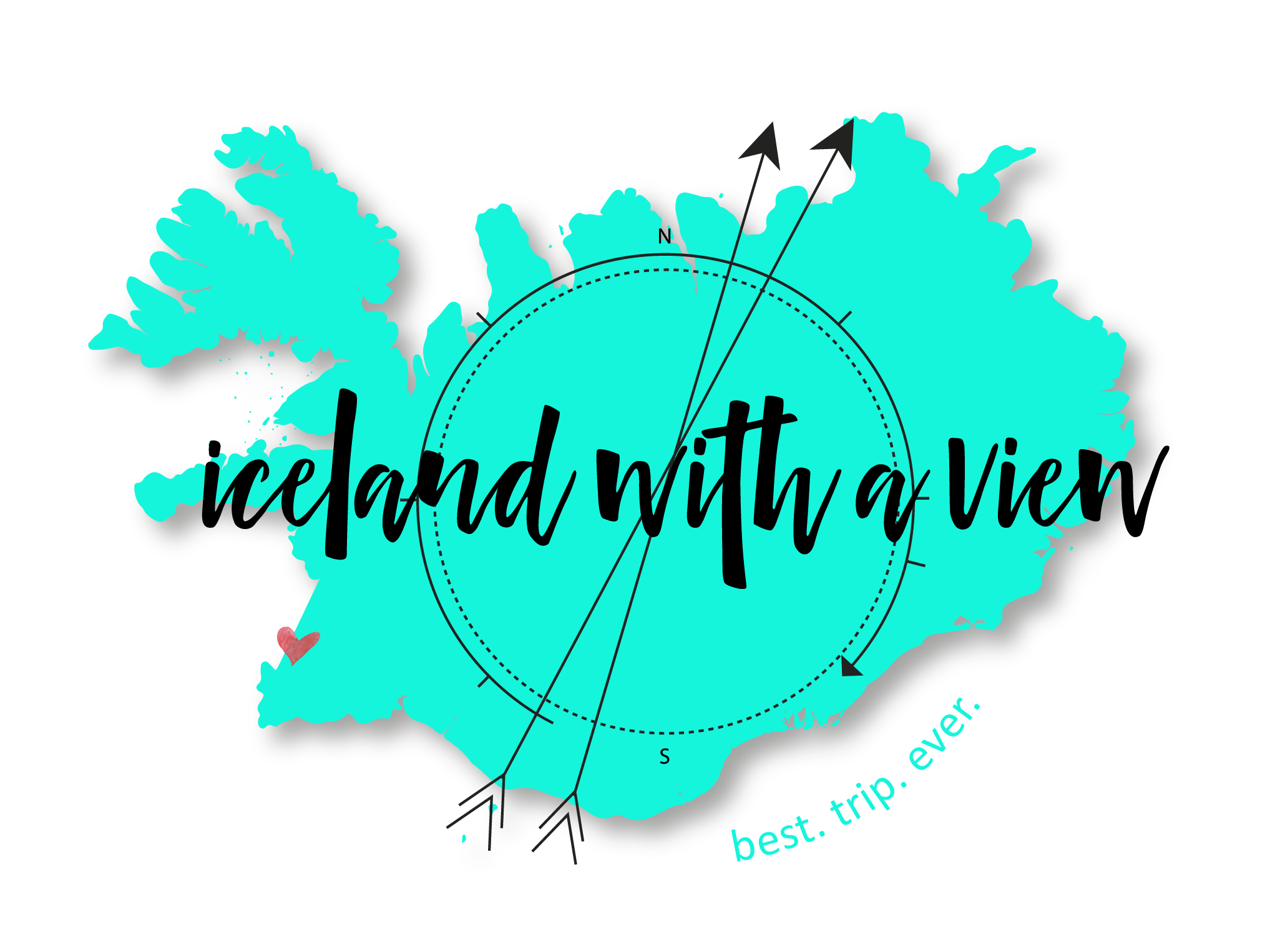
Happy Camper Van Tour
Hey, Team Iceland. We just got back from one amazing week in the Happy Camper van exploring all around the Ring Road. We had amazing weather. The camper van was awesome. It took us to some of the most beautiful places in Iceland. So I thought it would be fun to give you a tour around the van because a lot of you have been asking what it’s like inside and what they have and everything like that. So I just want to show you all around the van today so that you can know all about the Happy Campers and how they are really such a great way to travel through Iceland. I’m telling you, you’re going to love it. Let’s get into it.
Inside the Happy 3
Coming into the inside of the van, basically, the Happy 3 is so nice because it has this upper area here. So technically, this can sleep a family of five with maybe two or three on the bottom and then two or three on top, depending on the size of the kids. So you can see that there’s plenty of room here. This is actually a pretty good size bed. I know the Happy 1 bed is smaller because the kitchen is on the side. But here, tons and tons of room. So we ended up just leaving the bed folded down, and then kind of putting our stuff here throughout the drives. But this upper bed, if you’re using it, pulls down just like this, and now you can put the bedding in there and use that. And it’s easy. I mean, you just clip it in here. And this is really sturdy, so adults can sleep up there. I’ve definitely seen full-grown adults sleep up there or kids as well. I know it might not look like much, but trust me, I’m a little bit claustrophobic, and I would be okay sleeping up here. There’s plenty of room.
The vans come standard with these blankets, so there’s a mattress pad, and then it comes standard with pillows here and these blankets. There are also two fleece blankets that are included in the bedding set. With the heating system that’s inside the van, we were not cold, so we actually didn’t use all of this stuff. We just used these lightweight blankets, and we were perfectly fine. We did take the sleeping bags just in case, but actually we both never used that. With the heating system, I’m telling you, it’s really, really awesome to have in the van, so all we used was these blankets. All of the bedding comes in this handy bag, so basically all you have to do at the end of the sleeping night is just shove everything into this bag, which is really, really helpful for storage and just kind of getting everything in one place.
Room for the Whole Family
I’ve just cleaned up the bed. I’m going to set it back up to the seating. You can see it’s super easy. Everyone has seat belts, obviously, so it’s super safe back here, and so you can be riding in the van as you’re driving down the road with kids. You can just see that it’s super comfortable for riding back here. Oh, this is lovely. I’ve only sat in the front seat, but this is great.
One really nice thing about the Happy 3 is that I am literally just standing up in here. There’s so much room around me. This is really, really nice and convenient. So even my husband, who is 6’6″, is able to almost completely stand up inside. It’s really nice to have this for when you’re changing, when you’re cooking, when you’re trying to get around. Trust me, this is super, super nice. I’ve also used the Happy 2, and there’s quite a bit of space in there as well, so I really enjoyed that. Only seen inside the Happy 1, which is very cramped. I know it’s very common to use the Happy 1 for just two people, but if you can upgrade, the Happy 2 is really nice to have extra space. And then if you’re just wanting to be excessive, then go with the 3 for two people. But this for a family would be absolutely comfortable.
Camper Van Kitchen
All right. We’re going to do a tour of the kitchen, so you can see what’s exactly included in these drawers here and what you’ll have to cook, which is actually amazing. Happy Campers thought of so much. So let’s just start up here. Obviously, you have sink with running water. So there is a water tank here on the side that you can fill up throughout your trip. Holds a lot of water. We only had to fill up a couple of times within a week. So we were washing our dishes here, using the water for coffee, cooking, everything like that. It was really, really handy to have this right in the van. Happy Campers provides you with stuff for doing the dishes, so that’s really convenient.
And then you have the camp stove. This is a propane tank, sits right up here like this. They actually give you three extra canisters, so you don’t have to worry about running out of fuel for all of your cooking. This is really easy. Fuel canister is over here. This click it in, and then you have fire. And then you can, like I said, cook anything that you would need on the stove. So we were making definitely coffee, usually breakfast, and maybe 50/50 dinner. So we didn’t utilize this as much as you could, but it was so awesome. So awesome. I just loved that we didn’t have to think about which cafe would be open or when are we coming up to a restaurant. I love having this flexibility.
Also in here is a hot plate and a cutting board. In one of the drawers you’ll find things like plates, bowls, and cups. And like I said, this is for multiple people, so they have enough in here for everyone. In the other drawer is where you’ll find your cook gear, so there’s a nice big pot here, which you use to boil water for coffee, cook rice, cook pasta, cook all the things. Also, a skillet, so we were making eggs, bacon, toasting bread, all of that stuff on this guy.
And then the utensil drawer. So there’s knives, forks, spoons for everyone. And then some people were asking about what cookware, cutlery is included. There’s a can opener, spatula, tongs, a spoon, and a knife. So what else could you need?
With that, there are two drawers that are completely empty. We use this drawer for our dry storage, so things like peanut butter and jelly, chips and popcorn, rice, bread, coffee, tea. Any kind of that stuff. Our final drawer, we actually used for our electronic equipment since we have a lot.
And then also the cooler that’s in here as well. This was super awesome because there’s plenty of room in here, and it is temperature controlled, so you can set the temperature that you want. This was obviously super handy to have to keep all of our foods cold.
This is the heating system, so all you have to do at night is turn this button on, and the heat starts pumping out. It’s so nice to have this on at night. The heat starts coming out down here underneath the bed, so it definitely keeps you plenty warm.
Camper Van Menu
Also, I know a lot of people were asking us what we were making for meals, what we were cooking in the van during our trip, and we kept it a really basic because we just didn’t want to be messing with too many things with cutting up and cleaning or anything super fancy. We would do things like eggs and bacon for breakfast or sometimes maybe just some skyr and granola on top. Obviously, coffee. We had cream. And that was it for breakfast. Super easy. Another option would be to do hard boiled eggs. Those would be great for breakfast if you don’t want to cook. For lunches also we kept it super easy. We did things like peanut butter and jelly sandwiches, tuna roll-ups with a wrap, some sliced vegetables. Really, really easy stuff, you guys.
I’m a big snack person, so we always had things like protein bars, the best popcorn in the world, sparkling water, energy drinks. We just like to have that stuff to keep us going and keep yourselves full. For dinner, what I would maybe do is saute up some ground turkey or ground beef, maybe saute up some chicken, and then I would add to that. I would add rice or pasta, just something that is easy and we can all throw together. And we ended up doing this butter cream sauce on top of that, which was obviously delicious. You could also do a red sauce or just basic salt and pepper, olive oil. Just keep it really simple.
Most of the campgrounds had a kitchen area, but if not, there was usually some sort of sink or outdoor washing tub. We could do the dishes in the camper if we wanted to, but I found it very easy to just do that at the campground.
Well Designed With Storage
For the dash area, the nice thing, the windshield is so big. It’s really, really nice for all those road trip views. We had a GoPro set up in the middle, which was really good for road video or any video of us inside the van. Here you can see the inside in the dash. So lots of room up here. The front of the van is really, really spacious in the Happy 3. Lots of charging going on up here. So they have the USB, which is connected to the radio, which is nice to play your iPod or your phone music.
Wanted to point out here that the vans are manual at this time. However, I know that Happy Campers is upgrading those to some four-wheel drive vehicles for the 2019 season. One thing else I wanted to point out is this middle console here. So this does flip up to a seat where someone could sit up here, but we actually kept it laid down because it was just nice to have extra storage and just kind of set our cameras on there to grab really, really easy.
I also wanted to point out the extra storage that’s inside of the dash. Up here there’s a little ledge, here’s a little ledge, here is a little ledge, and then all these little pockets in here. So I was putting my cell phone and the GoPro. The water bottle storage. I mean, seriously. Also in here, in the cup storage in the front here. There’s so much storage, you guys. This area in the top pops up here. Let’s not forget about the storage up here because, obviously, Happy Campers thought about everything!
A couple of other things that I wanted to talk about that I thought would be really helpful for you guys to think about even before you come to Iceland. Think about bringing something like this, which is kind of like a chip clip. We use this for things like closing the coffee bag, chips, things like that that you just don’t want to spill all over. Another thing to consider is when you’re cooking in the vans, a lot of times you’re going to have some leftovers. And in that case, it’s really handy to have Tupperware containers. I would actually recommend bringing these directly from where you’re coming from because they’re actually a lot more expensive in Iceland than they should be.
One of my biggest tips that I’ve actually talked about before in my grocery store video is packing a soft sided cooler for your road trip. This is also something that came in handy on our Happy Camper road trip because we needed extra storage. So what I did was, other than the drawers and the refrigerator, I kept things in here that we would need to grab quick or anything else organizational-wise that we would need in here. As far as ice goes, if you’re wanting to keep this stuff cool, all you have to do is look at the grocery stores or the gas stations, and they’ll have small bags of ice for you to refill throughout your trip.
Paper towel is something also that I used a lot in the camper, whether it was to wipe off the counter or dry off our dishes. I did use the paper towel all lot. This usually comes in rolls of two at the grocery store. Pretty inexpensive. Really, really handy to have.
Recommended Extras
And then the last thing that I would highly recommend but actually we didn’t bring with us this time is having some sort of rope, bungee cord, something like that that you can easily tie in here or clip in here. You can see that there’s hooks along the ceiling, and this would be really, really nice to hang things like your wet towel after showering, your swimming suit after the hot springs. Or for those of you that want to do laundry, and then you don’t have time to sit at the campsite, you want to just keep going in the vans, then you’re going to want to bring some rope, bungee cords, or both.
A couple of other things that did not come standard in the van that I got extra were their coffee tumblers. The first time that I used the Happy Camper , they had French press, but this is a built-in French press and mug in one. So I thought this was amazing to have. You can see it has the plunger in here. So all you do is put your grounds in here, put on your top, push it after a few minutes, and then you have your coffee ready to drink right out of here. So these were really, really nice to have.
The other thing that I got that was extra was a table. This just folds up and stores on the side of the van. We used this when we were cooking just for some extra space. Or, obviously, when you’re eating, it’s nice to have a place to just set your plate and dishes and things like that. We also had two of these fold-up camp chairs. Also really nice to have when you’re just wanting to sit outside at the end of the night. We used these when we were watching the Northern Lights. Really nice also to have this. But what I found myself using a lot was this handy little stool. And I just loved using this when I was sitting to cook because the countertop is a little bit low, so I would sit and cook.
Another super handy thing to grab that I highly recommend is this inverter. Basically, there’s a plug in here with … You can see all of the different plug-in styles and two USB ports here. We were constantly using this to charge all of our devices. So between camera, drone, GoPro, phones, computers, all the time, we were plugged into this. Really, really handy to use, so I really suggest this.
Campsite Expectations
Now that we’ve done the van tour, I want to talk a little bit about the campgrounds and the campsites because a lot of you have questions about this, and I wanted to make it pretty clear. The thing is, with camping in Iceland, whether you’re trying to park and just sleep in your car or you have a tent or you have a camper van or motorhome or anything like that, the law in Iceland is to park at a designated parking campground area. You will see signs on some places where people try to camp that say, “No camping.” Please, you guys, as always, respect the rules of the country. It’s so important to park in a designated area so that you’re not ruining the nature by utilizing that area. Because just think if you have to go to the bathroom or if the water from your vehicle is draining out of the sink, you’re dumping out your food. I mean, that should not just be happening anywhere in the country. So please, please, please, you can’t park anywhere. Always find a campsite to park in.
Another thing that people ask me about is, what if a campsite is closed? Iceland does have summer and year-round campsites, so some of the campsites are only open during the summer months. However, this does not mean that they completely close the campsite. Right? So they wouldn’t lock you out, you’re not able to go into that area. You’re still able to park in that area of the campsite. It’s just that the amenities would not be open. So the toilets, the showers, the kitchen, all of those facilities would not be open for you to use if it’s not open year-round. However, that just means that you don’t have to pay to park, to camp. So win-win, I think.
So if you do come across a facility where the toilets are locked up, and you’re like, “Well, what in the world,” again, that is the best place to park and camp for the night because that’s a designated area. In that case, just use a restroom that’s in the gas station or something else that’s around that area.
Campsites in Iceland can be found everywhere, you guys. Almost all, if not all, of the villages in Iceland have a camping area. So just look out for the signs, or Happy Campers has a really amazing Google map that they can share with you that shows you all of the campsites in Iceland. So you will not have trouble finding a campsite.
In terms of campsite quality and what’s available at each place, every campsite is different. Some of them have the kitchen facilities, some of them don’t. Some of them have really nice, clean bathrooms, some of them don’t. Every place is different. You just kind of have to roll with the punches and do the best you can.
All right, my friends, I hope you loved the Happy Camper van tour. I’m not kidding when I say that I think that a camper van is the best way to travel through Iceland. I’ve done a lot of traveling in Iceland. I’ve done hotels, guesthouses, hostels, tent camping, camper van camping, and I just love, love, love the flexibility of using the camper van.
If you haven’t already watched my video on why I think that camper van is the best way to travel through Iceland, make sure to watch that as well. And if you have any questions at all about the vans or camping in Iceland, feel free to let me know in the comments below. Thanks again to Happy Campers for another amazing trip around Iceland. We loved our time around the Ring Road.
That’s it for today, friends. Thanks so much for hanging out with me, and I will see you next time for another helpful Iceland planning video. Until then, happy planning.
P.S. Happy Campers is the original camper van company in Iceland and is owned and operated by a local family. Their vans are in HIGH demand, so if you are considering this for your trip to Iceland, make sure to reserve in advance!
** Book your camper van today ! Also watch: 5 reasons to rent a camper van in Iceland

SUBSCRIBE for new Iceland tips every week!
Pin it for later!

Similar Posts
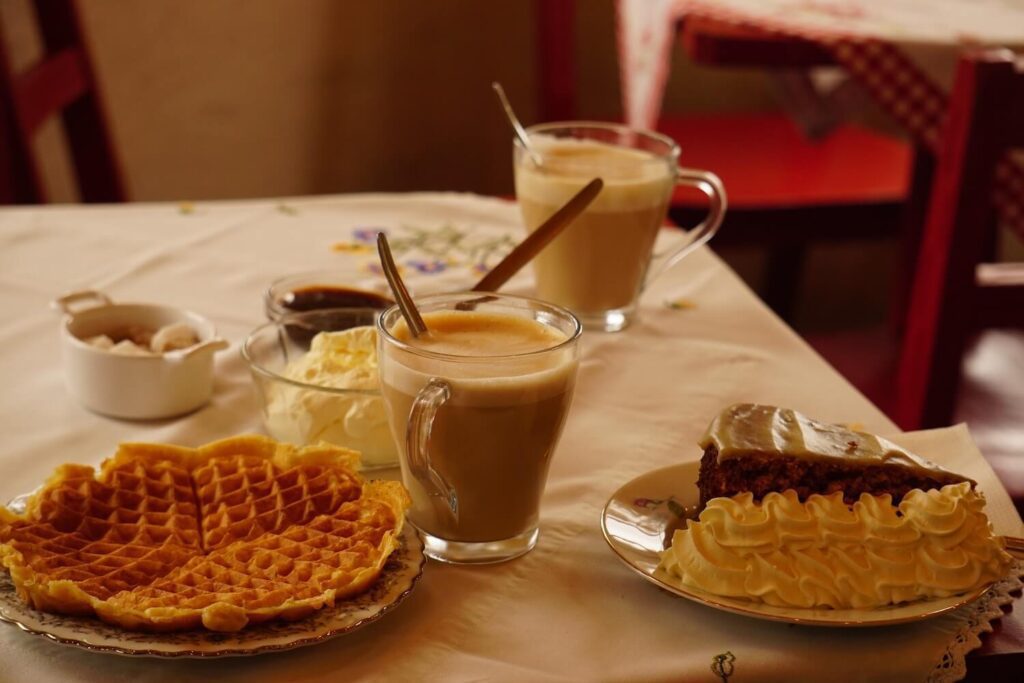
5 Places for the Best Coffee in Reykjavik
One thing is for certain: I LOVE coffee. Another thing that is for certain: Iceland makes DELICIOUS coffee. I think the secret is in the the brewing method. The preferred brewing method is usually with an espresso machine, rather than…
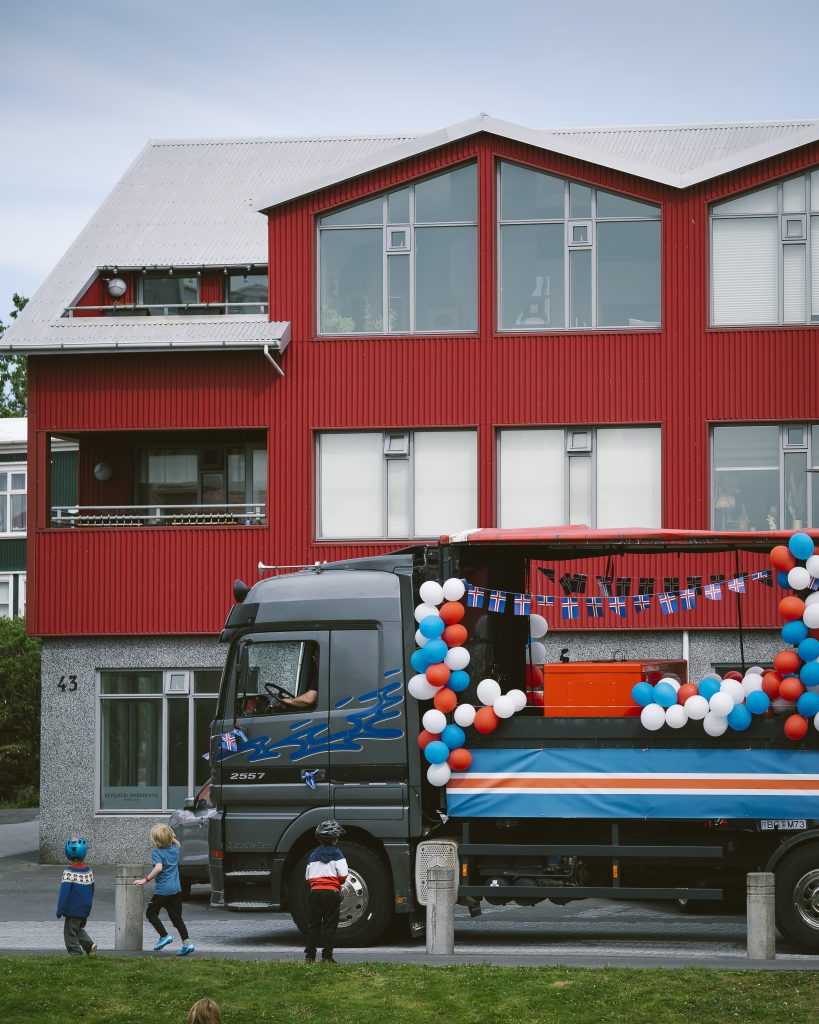
What Icelandic Holidays Should I Know About When Planning a Trip to Iceland?
You bought your itinerary, used the guidebook to fine tune your trip, and even bought your tickets, but have you considered Icelandic holidays and their impact on your dream vacation? Iceland has some of the most interesting traditions and celebrations…

Ring Road Itinerary – Happy Camper Trip
A 7-day itinerary around the Ring Road of Iceland in a Happy Camper Van with my little sister! We visited the best stops and hidden gems that are off the beaten path! All locations and detailed information about each stop…
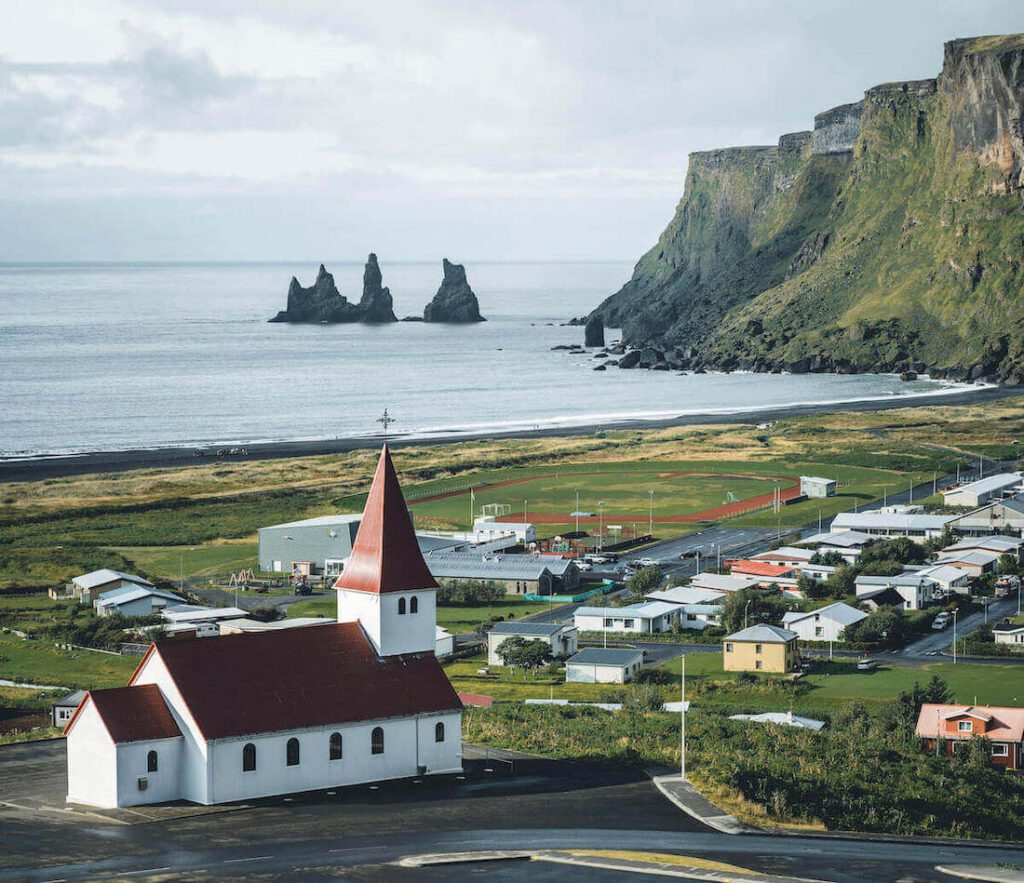
Vík, Iceland: Your Ultimate Guide to Iceland’s Most Charming Town
Are you ready to discover the small-town charm of Vík, Iceland? Explore iconic landmarks, black sand beaches, and the cozy atmosphere of this quaint little town, where the scenery looks like something out of a storybook! However, you might not…

3 Ways to Get Medical Care in Iceland
Come down with a cold? Need medicine? Get a bad cut or break a bone? Unfortunately there’s a lot of ways you could hurt yourself in Iceland but the good news is that the Icelandic health system is built out…
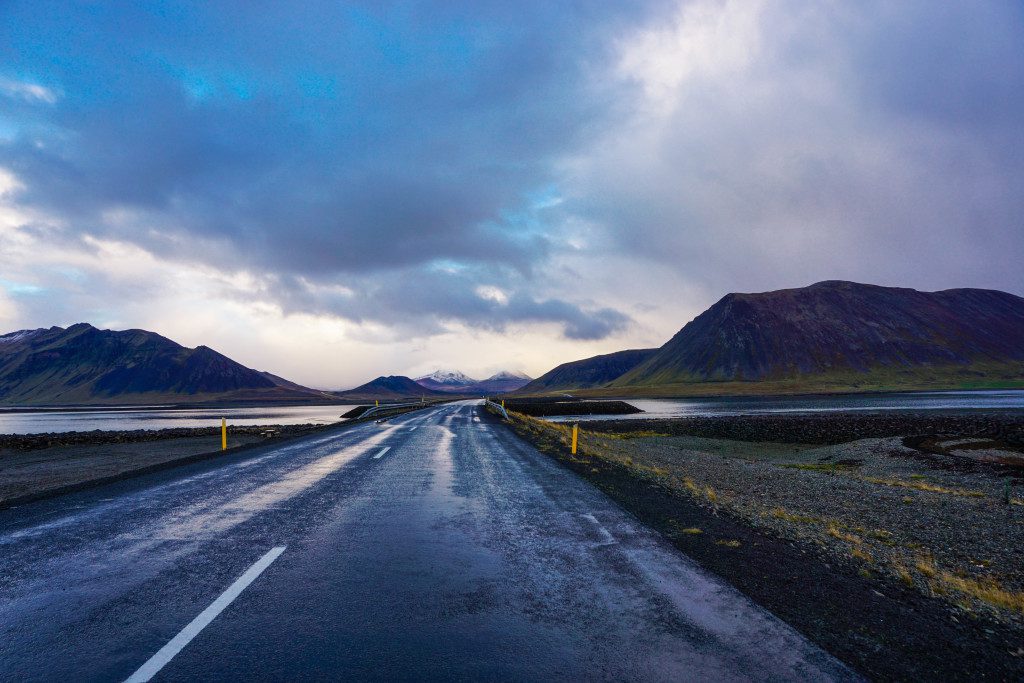
19 Easy Ways to Save Money on Your Trip to Iceland
It’s no secret that Iceland is one of the most expensive countries in the world to visit. If you’re not careful, you can blow your budget pretty quickly. And who doesn’t want to save some money?! I’m here to tell…
Privacy Overview
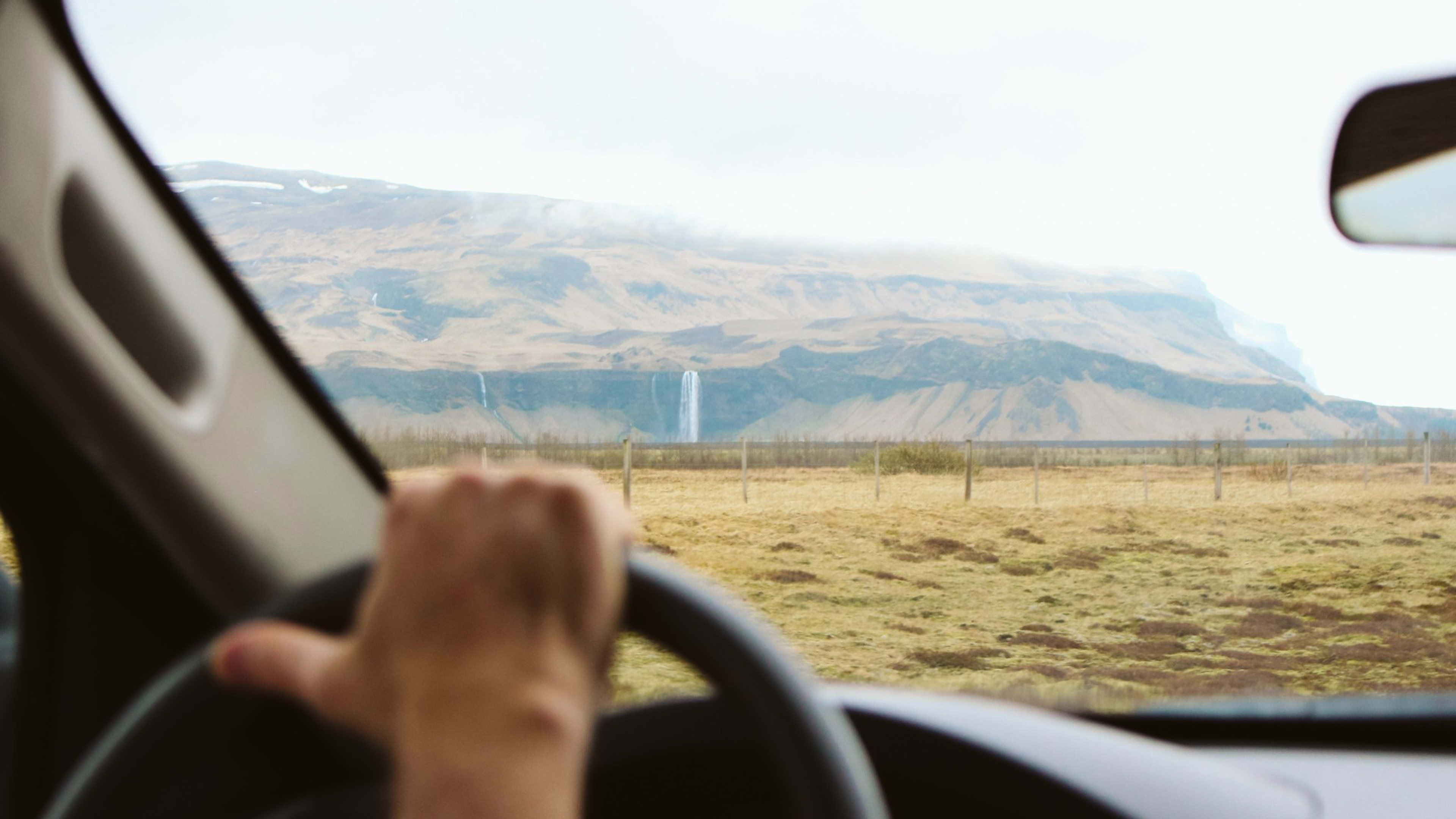
Self-drive tours of Iceland
- Great choice of itineraries around Iceland
- Stop as often as you like, wherever you like
- Second driver included as standard
- Never get lost with unlimited in-car Wi-Fi
31 trips found
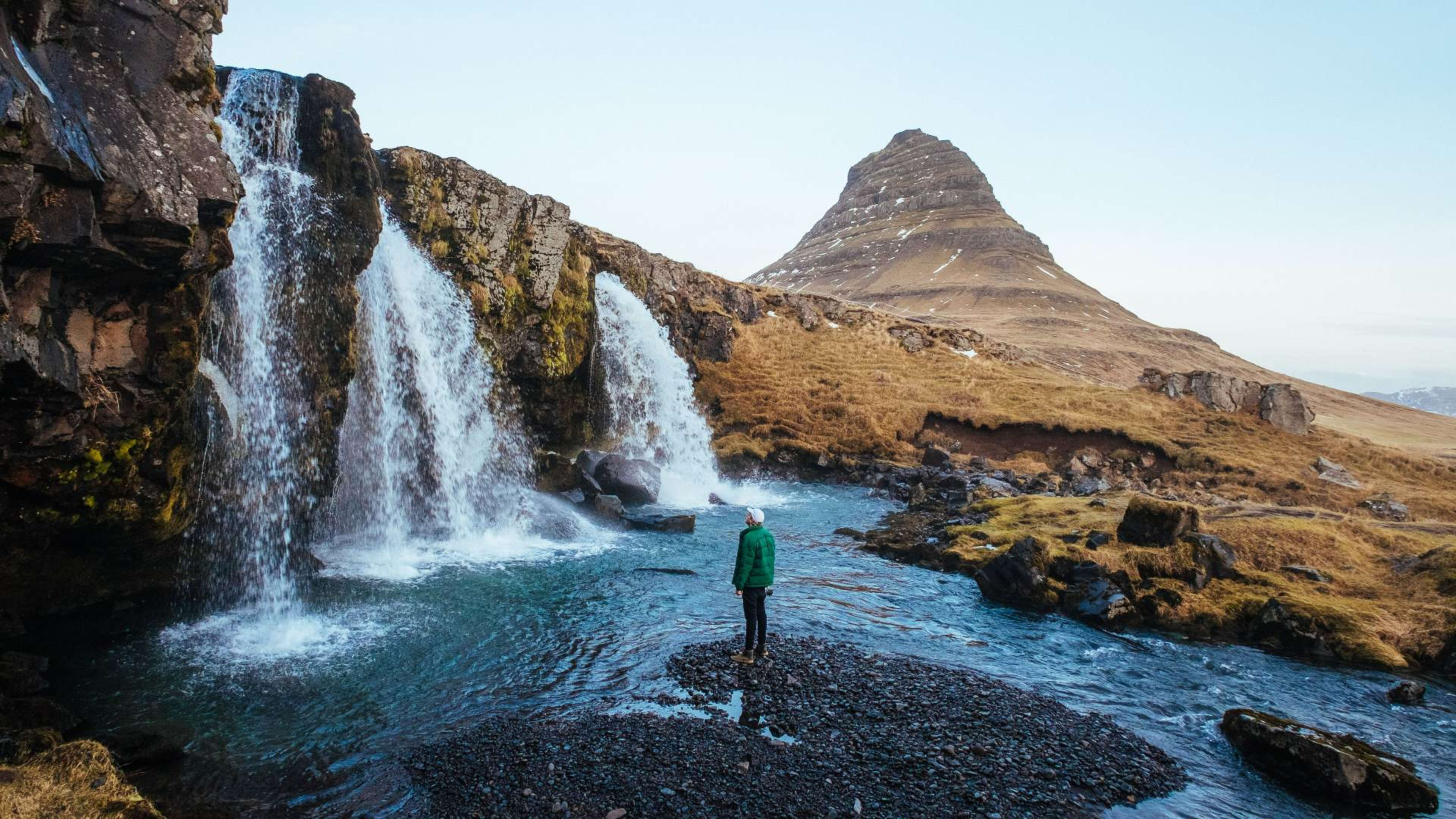
Iceland Ring Road Adventure with Snæfellsnes
The ultimate road trip with ‘Iceland in Miniature’.
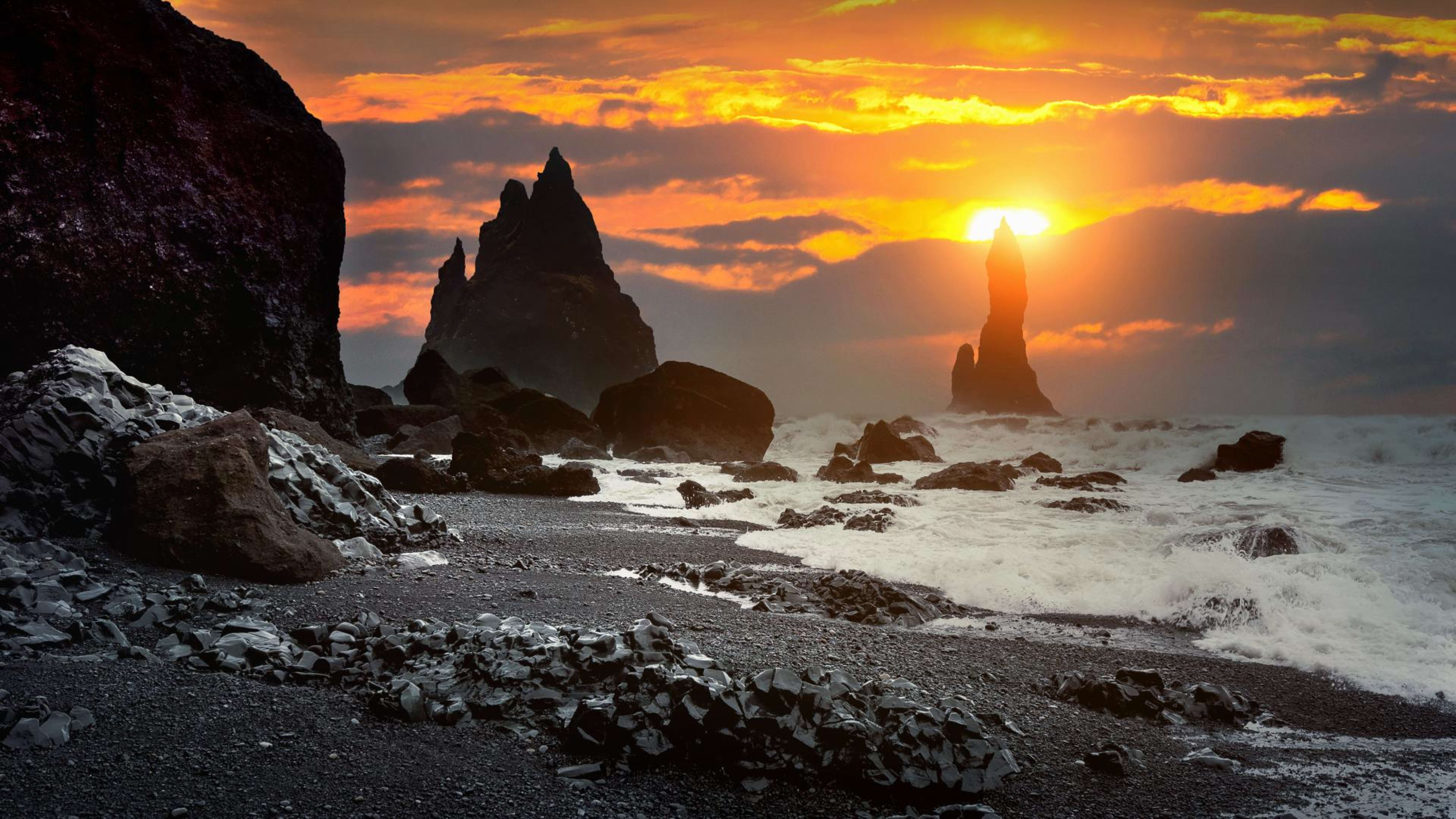
Iceland Ring Road: Best of the Best
Take the Iceland road trip of a lifetime.
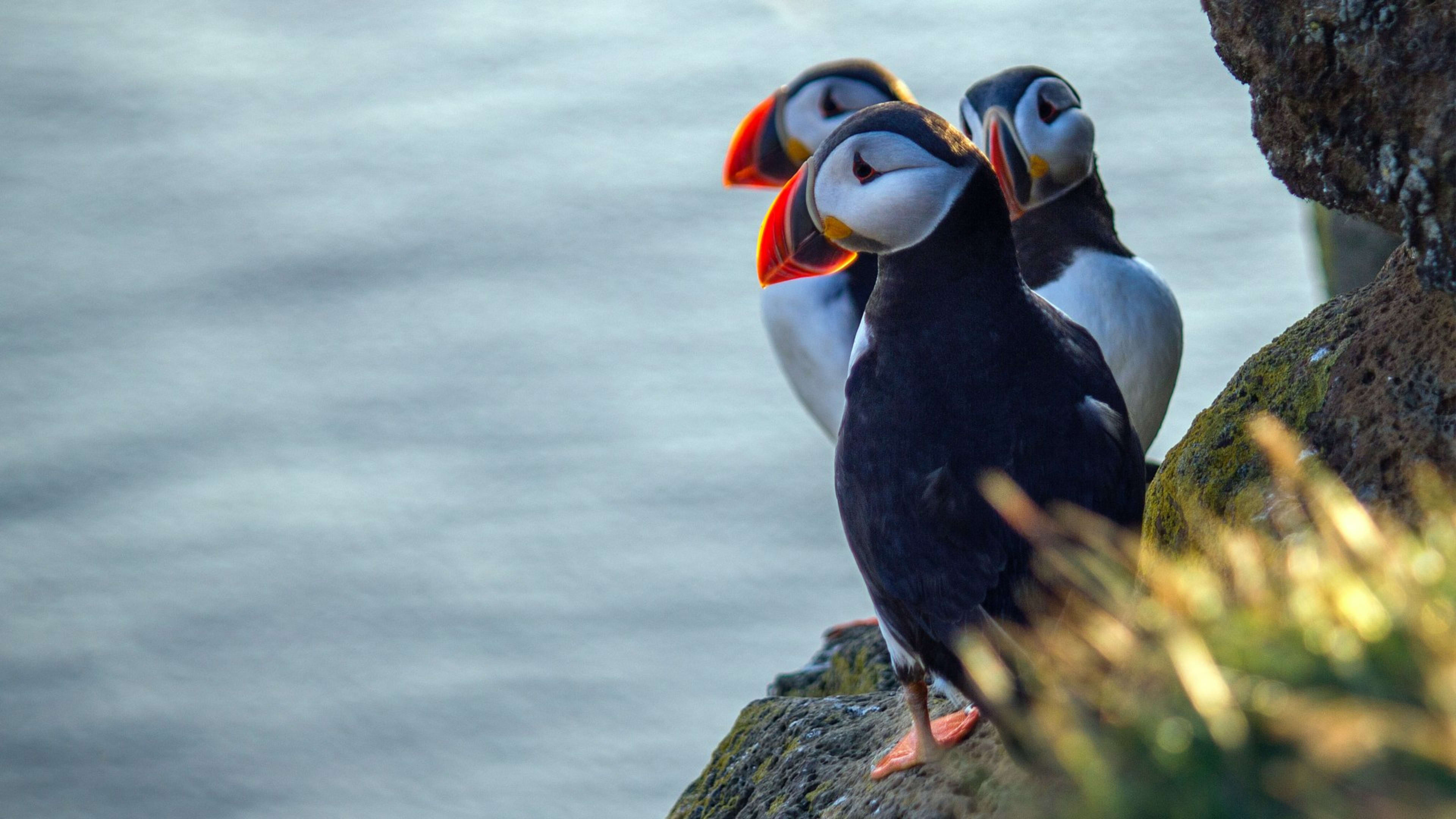
Iceland Ring Road & Westfjords Epic Adventure
Explore every corner of Iceland in 2 weeks.
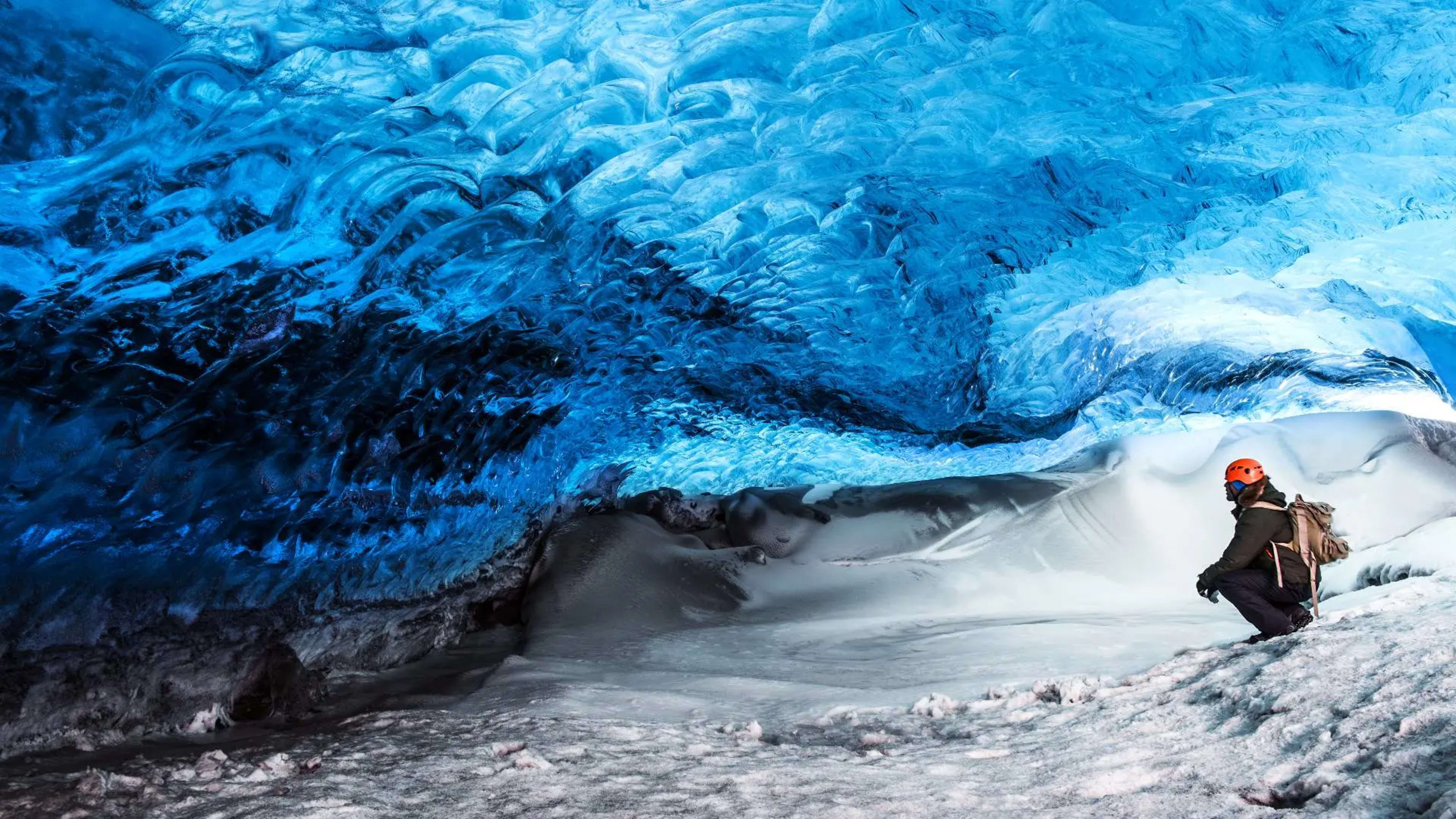
Iceland Active Winter Wellness
Combine thrilling activities with blissful hot spring visits.
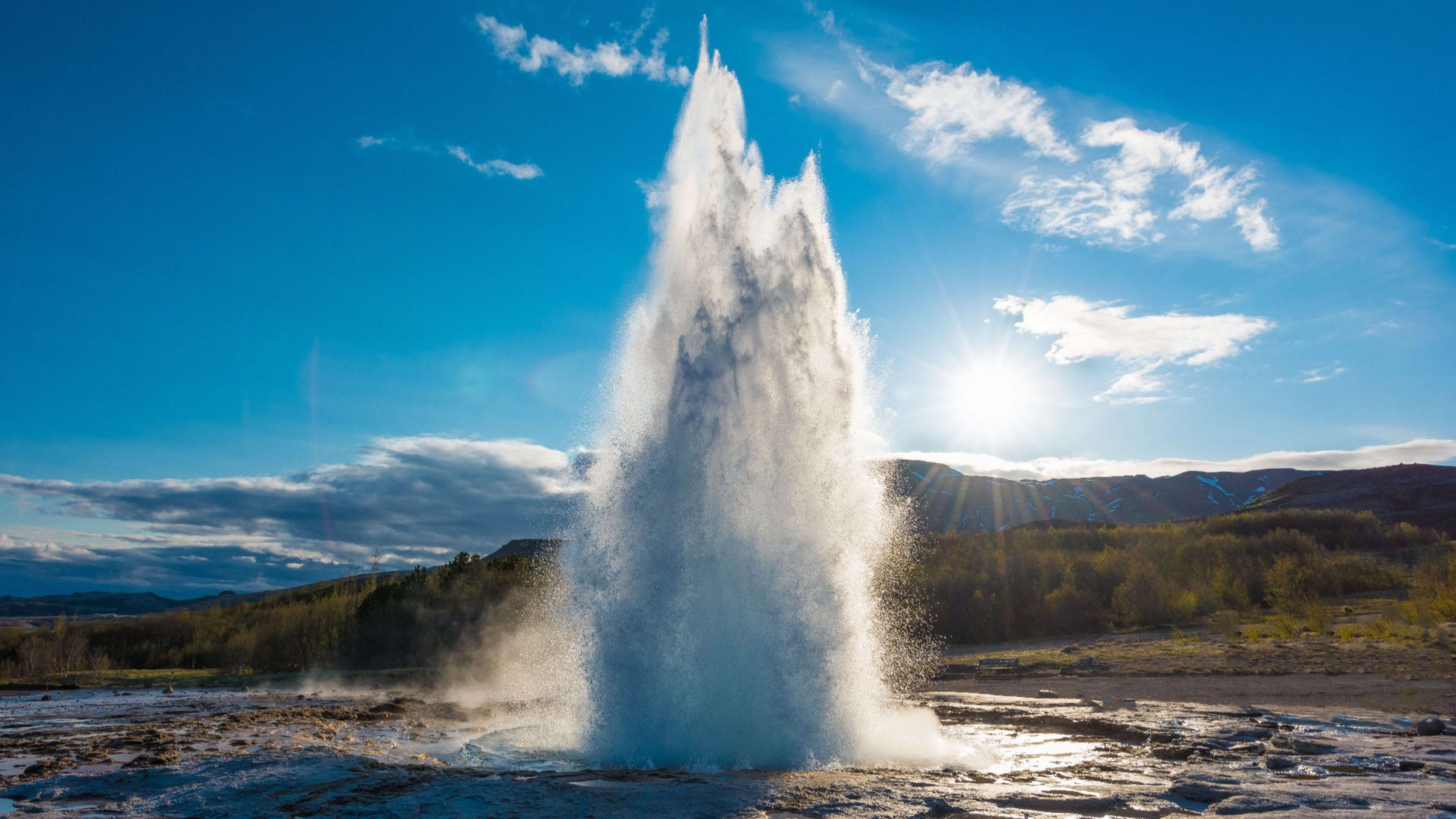
South & West Iceland in a Week
7 days, dozens of unforgettable sights.
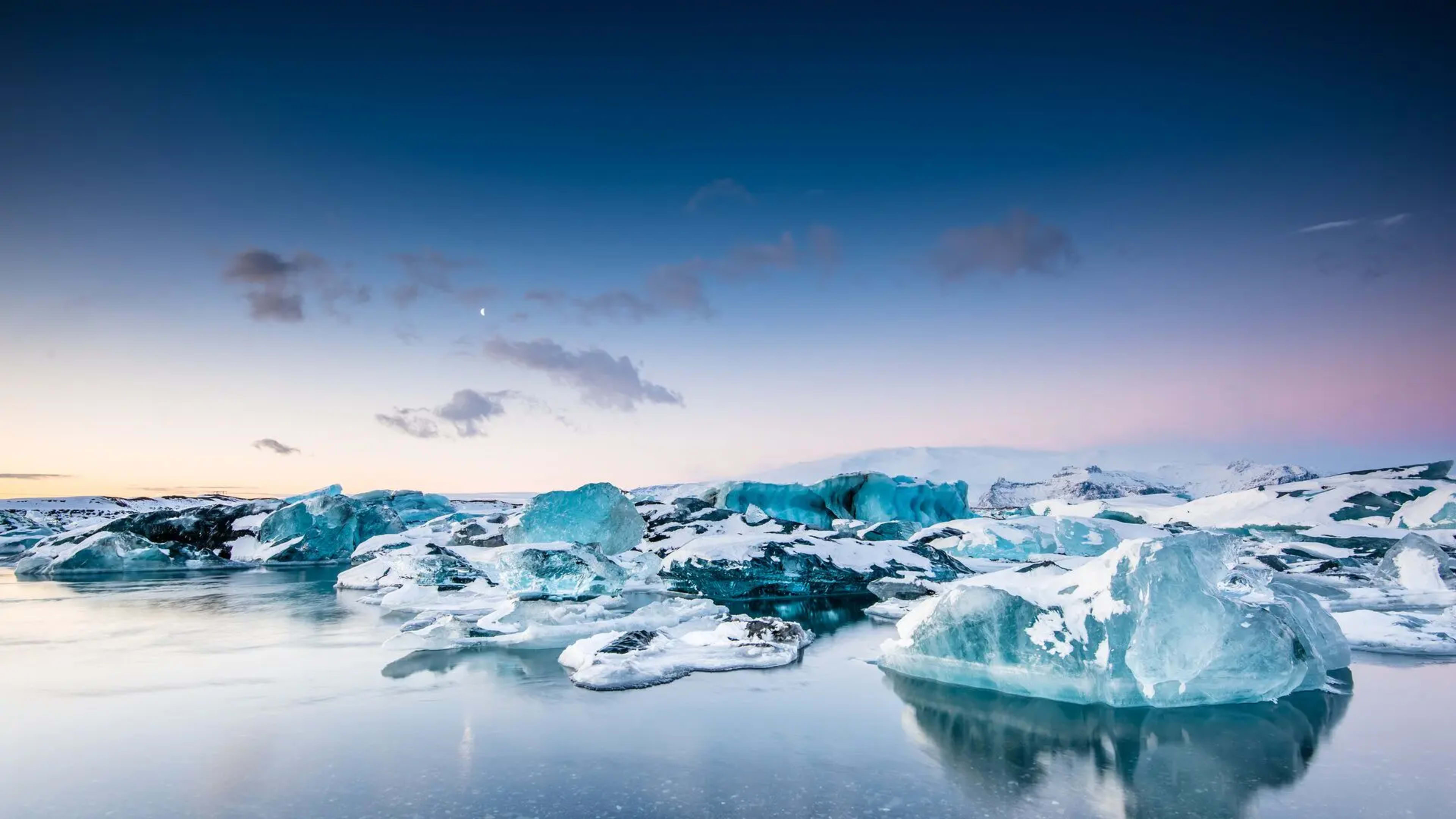
Iceland Waterfall & Glacier Adventure
Witness water in all of its wonderful forms.
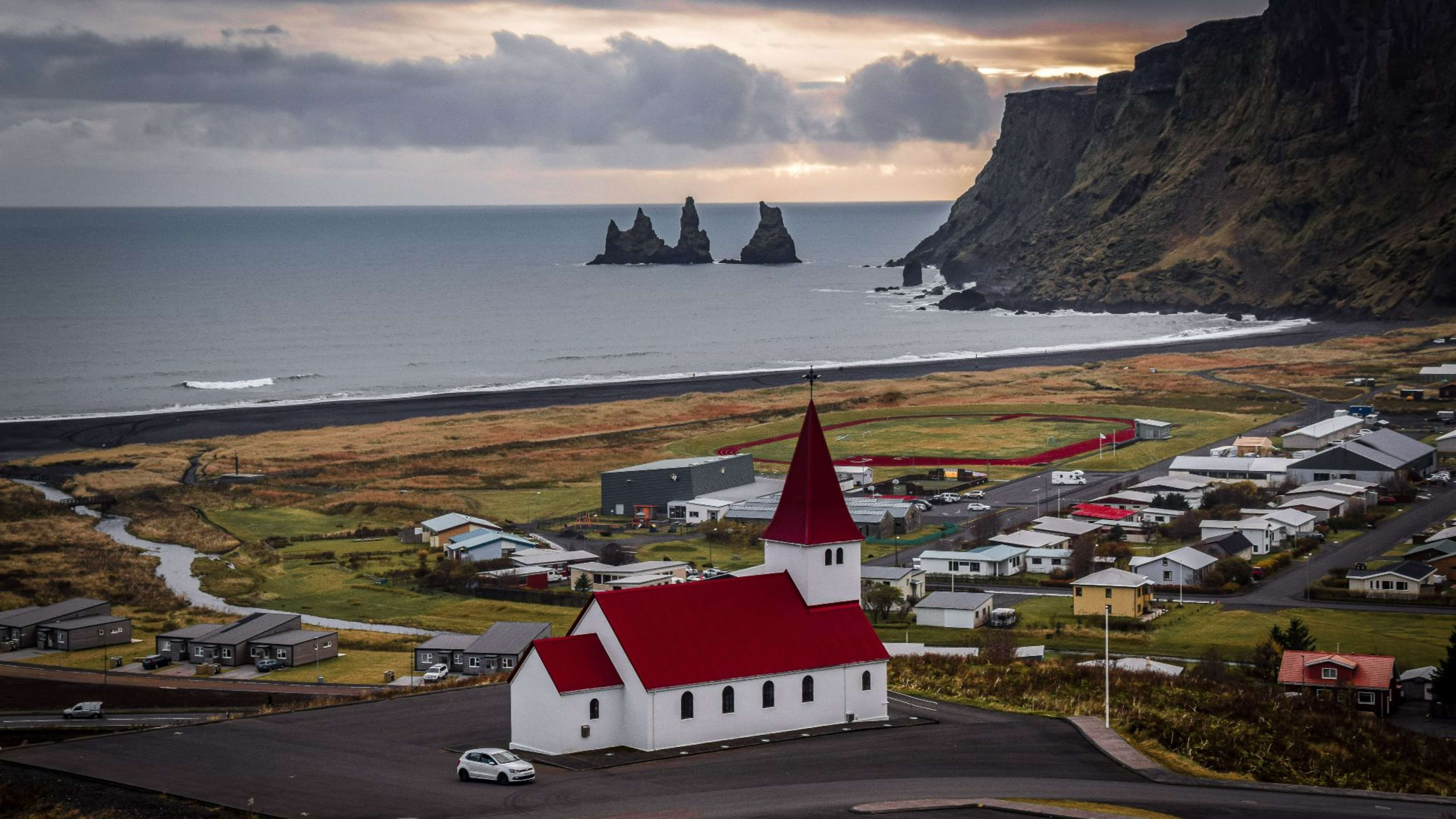
Iceland Ring Road in a Week
One week, one legendary route.
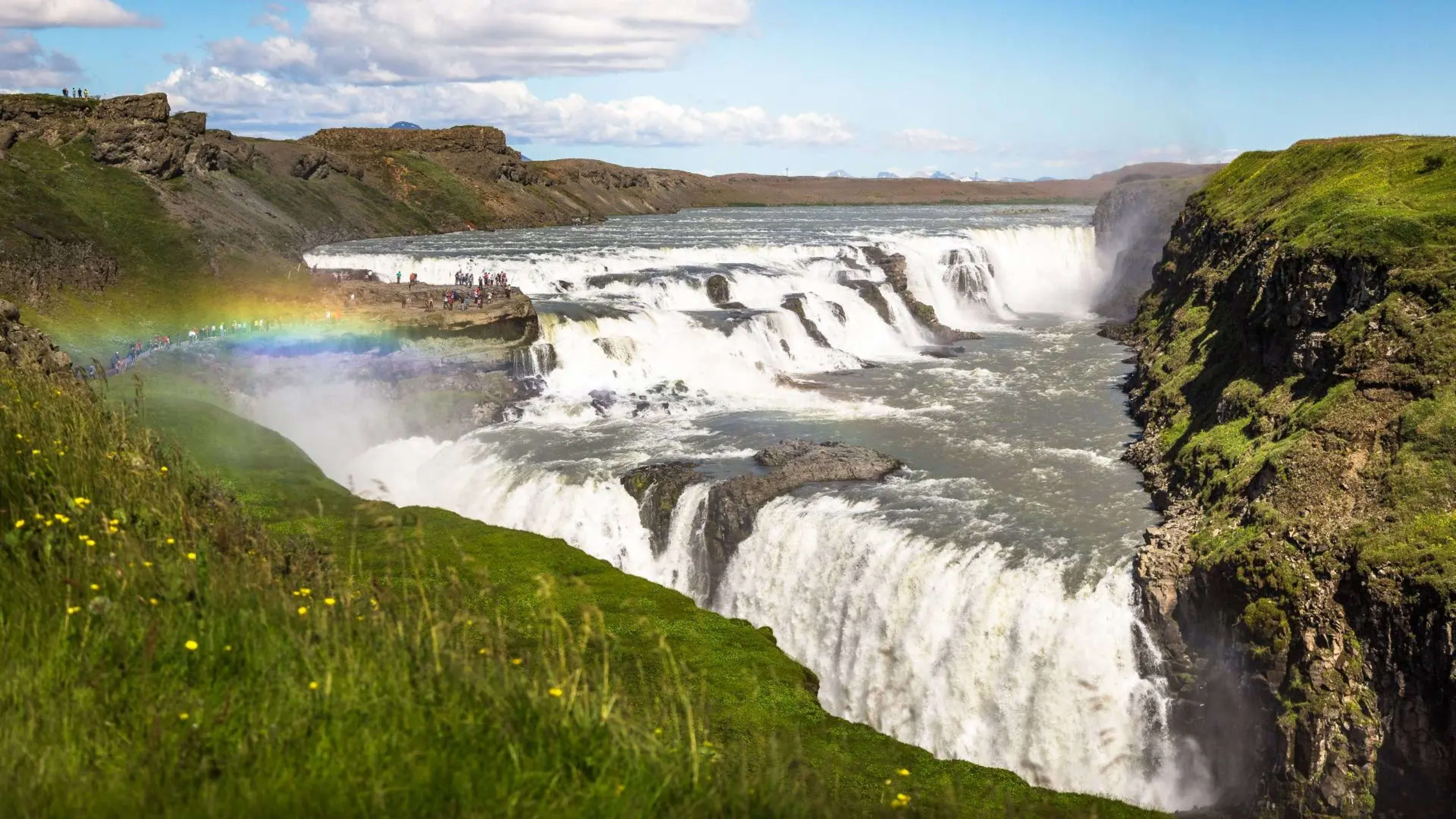
Iceland Complete Circle
Venture around the Ring Road and beyond.
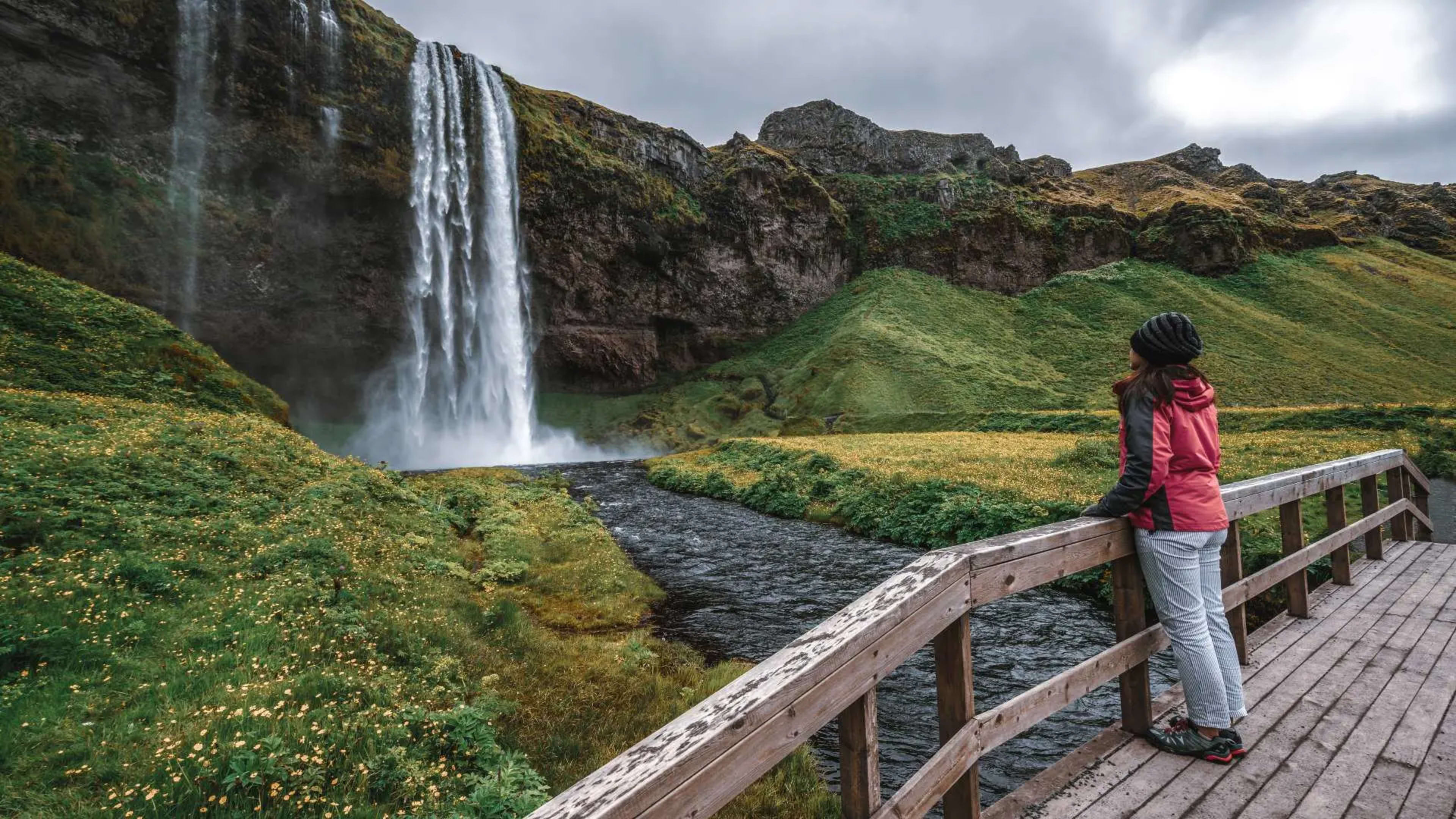
South Iceland Waterfall Adventure
Explore spectacular coastline and the wonderful Westman Islands.
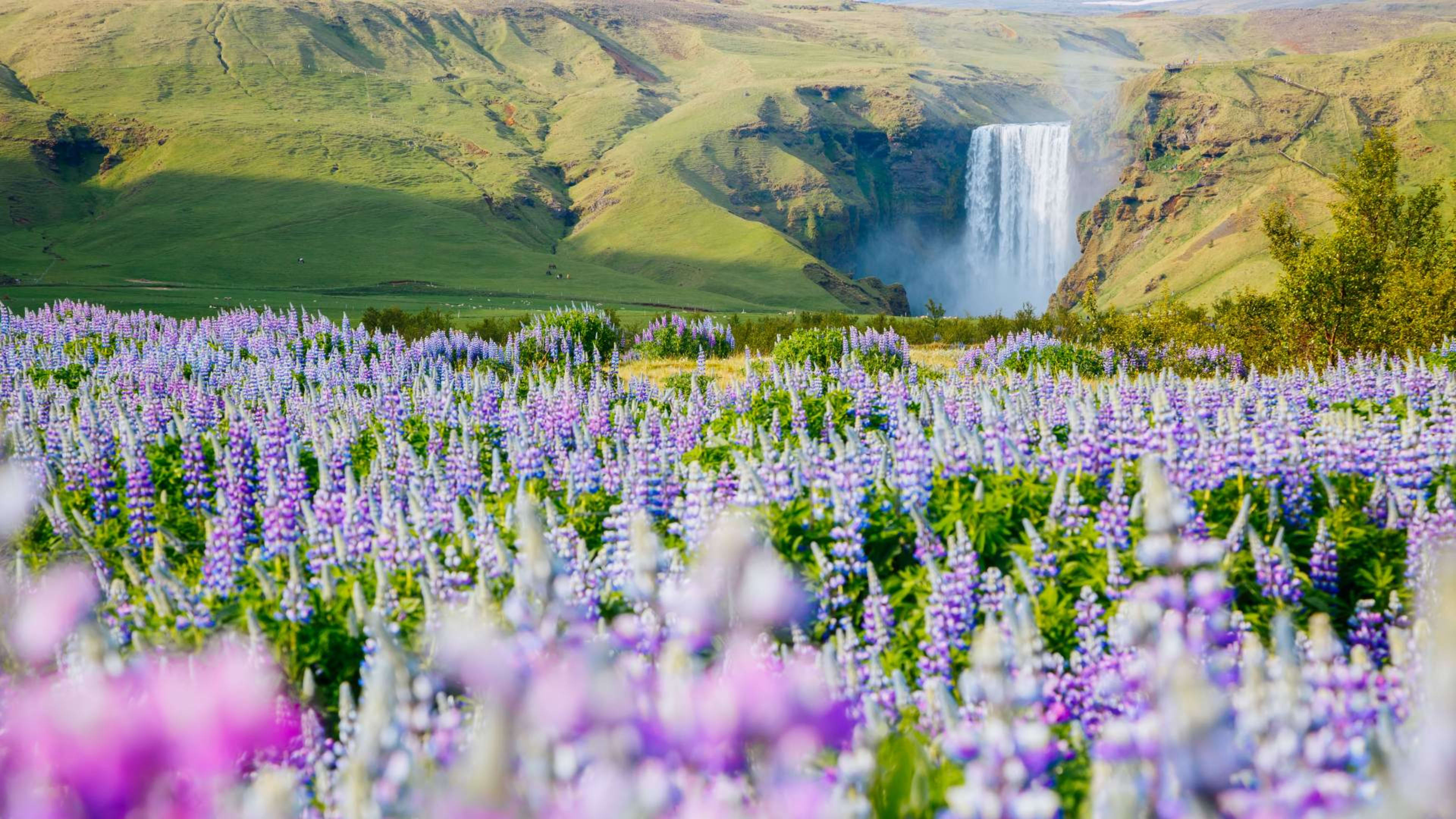
Iceland South Shore Adventure
Soak up the delights of the south coast.
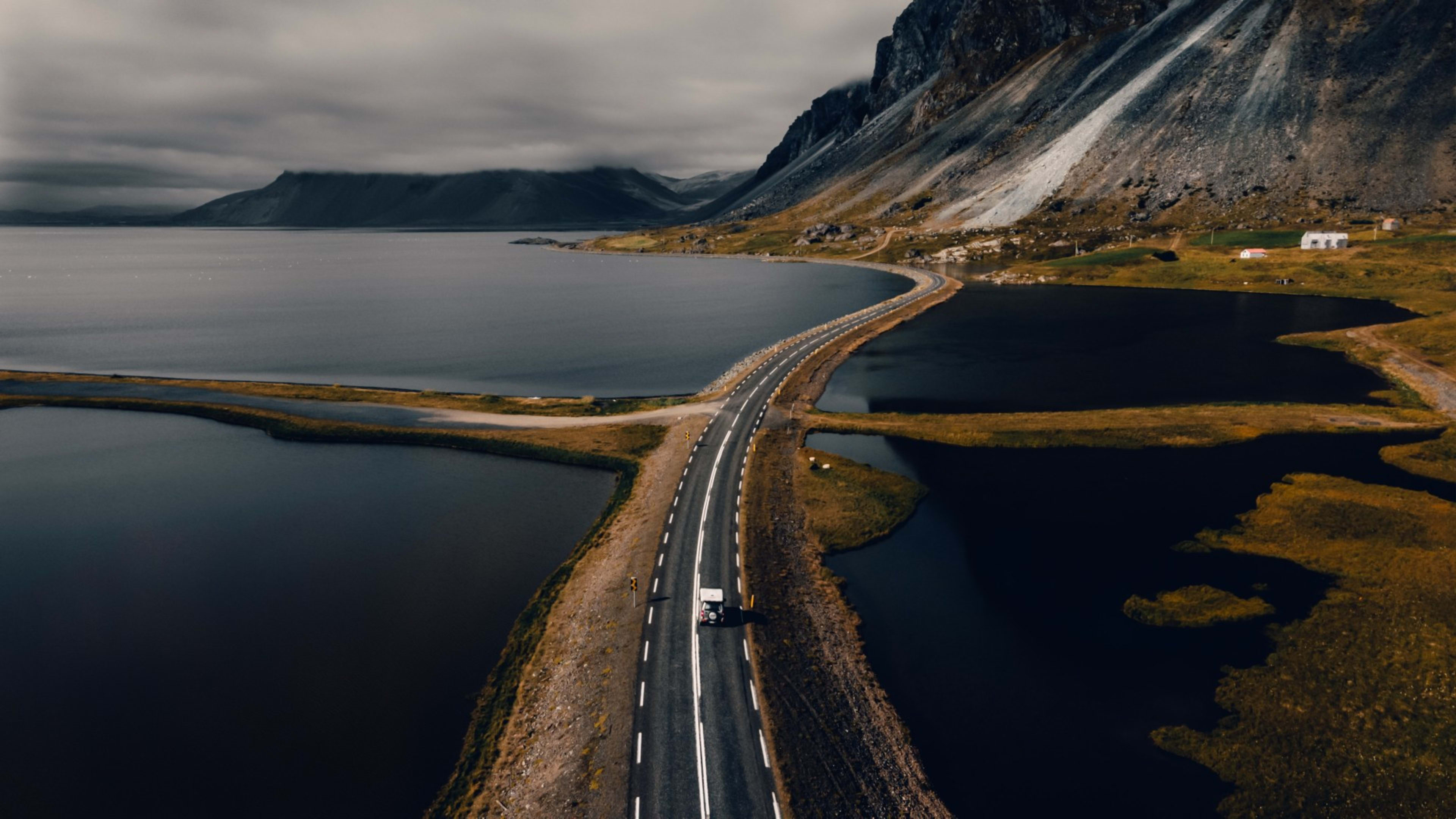
Iceland Ring Road Epic Adventure
Two weeks of road tripping on the famous Route 1.
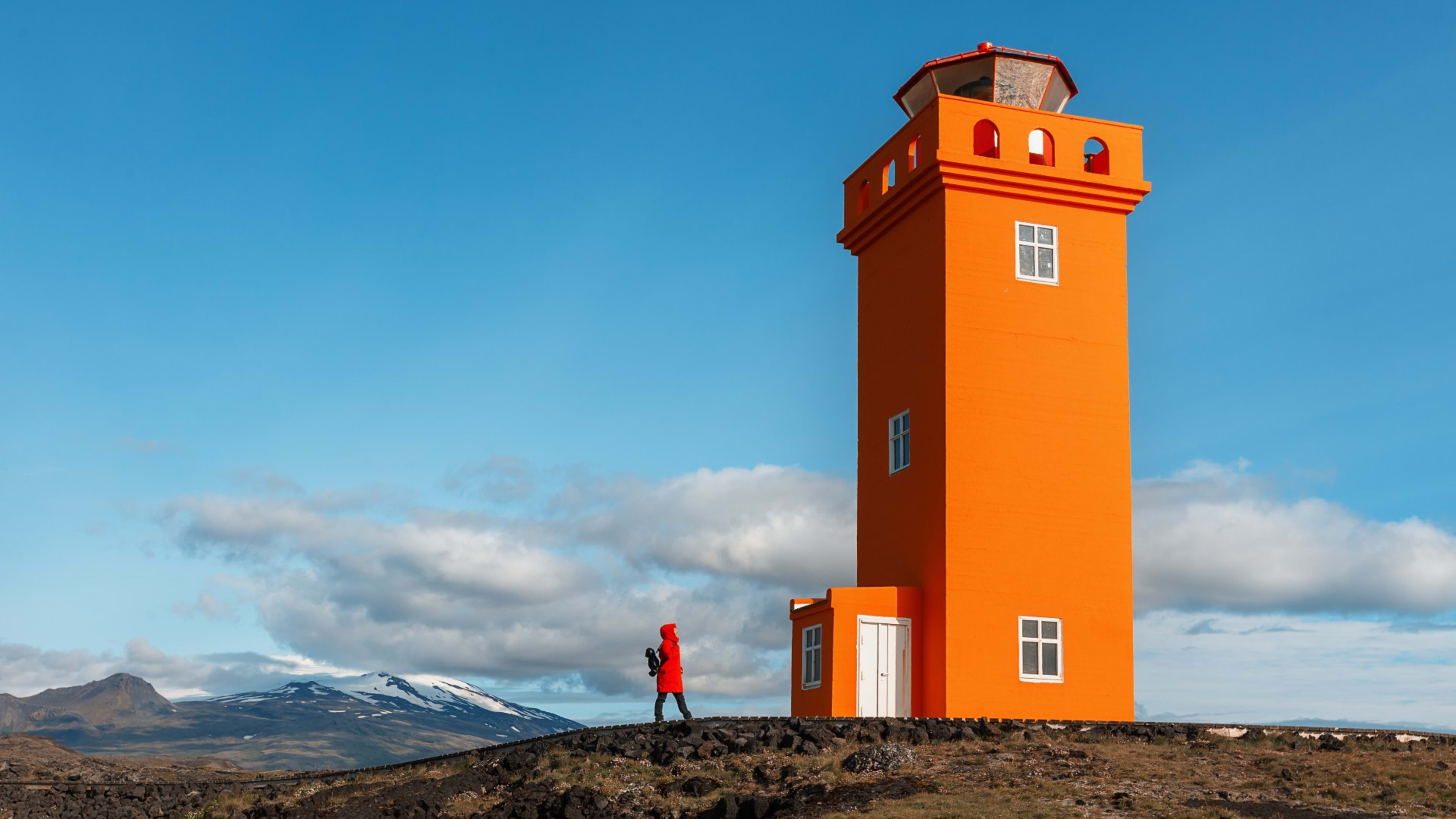
Iceland Ring Road & Snæfellsnes Grand Tour
Explore Iceland, little and large.
Showing 12 of 31 trips
About our self-drive Iceland trips
- Your choice of rental car and accommodation
- Ability to start your trip on any date, winter or summer
- 24/7 helpline for your whole Iceland vacation
- Best Price Guarantee on all self-drive tours
Don’t take our word for it
See what hundreds of fellow travelers have to say about their trips with Iceland Tours.
FAQs about Iceland self-drive packages
What is the best self-drive tour of iceland.
Self-drive tours give you the flexibility to go where you like, when you like. This means there’s a whole world of possibilities and no one tour that’s the best.
The right trip for you will depend on how many days you have to spend in Iceland and what you want to see. You might be thinking about driving the whole Ring Road , or just zooming in on a specific region. The choice is yours.
Here’s an idea of what you could get up to on an Iceland driving tour:
- Watch icebergs pass you by at Jökulsárlón glacier lagoon
- Chase the Northern Lights in the darkness of winter
- Explore the Snæfellsnes peninsula or 'Iceland in Miniature'
- Go on an ice caving excursion under a glacier
- Spend an afternoon unwinding in the Blue Lagoon
- Check out the unusual landscapes of North Iceland
- Sample local cuisine at towns and villages around the country
- Follow the winding coastline of the Westfjords region
- Hop aboard a boat to join a whale watching tour
- Spot magnificent waterfalls on a tour of Iceland’s south coast
Start by browsing the self-drive packages above. Play around with the filters to narrow down your search until you find the one for you.
Is it safe to drive in Iceland in winter?
You can definitely safely enjoy a road trip in Iceland in wintertime. Although the weather might sometimes present a few challenges, most of the time major roads are clear and accessible.
Snowplows regularly clear the roads in winter, especially in towns and near popular attractions. That said, heavy snowstorms may sometimes mean you have to take a slightly different route than planned.
One of the benefits of booking with Iceland Tours is that we can quickly update your itinerary should the weather get in the way. All you need to do is call our in-country 24/7 helpline, and we’ll take care of the rest. This means it’ll take more than snow and wind to slow you down!
If you’re not confident about driving in wintry conditions, fear not. We’ve got multi-day tours from Reykjavík , group tours , and privately guided tours . On all of these trip types, you’ll let someone else do the driving.
How many days does it take to drive around Iceland?
If you want to drive the Ring Road, you can technically do it in as little as 2 days. But you probably wouldn’t get much sleep or have much time to enjoy the scenery!
We recommend at least 7 days for a Ring Road trip . This will give you long enough to see all the main attractions. If you want to spend more time in each location though, 10–14 days road-tripping in Iceland would be best.
On a longer trip, you can add in regions off the Ring Road like the Westfjords or Snæfellsnes peninsula . We offer itineraries up to 19 days long if you want to see the whole country.
With any length trip, you have the option to add extra days when booking online.
What is the best time of year for an Iceland self-drive trip?
Summer is the most popular time of year for a self-drive trip in Iceland. The months of June , July , and August offer the best weather and plenty of sunlight, meaning you can pack more into each day.
Winter self-drive trips are also an option, and great for hunting down the Northern Lights. If that’s your thing, then a trip in October , November , or December would be ideal.
The coldest months in Iceland are January and February . In the depths of winter, we’d recommend a shorter self-drive itinerary in a specific region.
Springtime offers better weather and it’s generally a quieter time of year. If you want to beat the crowds, a trip in March , April , or May is perfect. Check out this article about Iceland in spring to find out more.
What’s included with your self-drive trips?
All of our self-drive tour packages include the following as standard:
- Rental car of your choice, with unlimited mileage
- Basic liability insurance coverage
- Collision damage waiver
- Authorization for second driver
- Unlimited in-car Wi-Fi
- Accommodation level of your choice
- Breakfast every day
- Detailed itinerary crafted by local travel experts
- 24/7 helpline in Iceland, just in case you need it
When you book your vacation on our website, you’ll be able to choose your preferred rental car and accommodation level.
You can see what vehicles are available on this car rental page .

How do you drive in Iceland?
The rules of the road in Iceland are similar to most other countries, although there are some local quirks that you might not be familiar with.
Iceland drives on the right and steering wheels are on the left side of the car. Distances and speed limits are given in kilometers only.
Roundabouts are very common in Iceland, especially in towns. If you’re not familiar with these, make sure you understand how to give way (yield) to other traffic.
In the countryside, you might encounter sheep on the road, or even reindeer in East Iceland. You may also come across gravel roads, single-lane bridges, and blind summits.
For all the info on how to handle these, see this guide to driving in Iceland .
Do I need a permit to drive in Iceland?
Most people won’t need a permit to drive in Iceland. You just need to have held your driver’s license for at least 1 year at the time of rental. Also, you need to be at least 20 years old, or 23 years old to hire a jeep or van.
If your license is in a non-Latin script, such as Chinese or Arabic, you will need to apply for an international driving permit in your home country.
What kind of accommodation is included?
On a self-drive package with Iceland Tours, you can choose from 3 levels of accommodation:
- Budget – Guesthouses and country hotels, with shared bathrooms
- Comfort – Hotels or guesthouses of around 3 stars, with private bathrooms
- Quality – Hotels or guesthouses of around 4 stars, with private bathrooms
No matter which accommodation level you pick, breakfast is included. Read more about the differences between the levels on this accommodation page .
Feel like getting closer to nature? Check out these self-drive camping tours .
Are flights included with my package?
Flights aren’t included with our vacation packages. We believe this gives you the most flexibility and access to the lowest prices. Once you have an idea of when you want to travel, you can look for flights online.
You can fly directly to Iceland from major cities in Europe and North America. If you’re traveling from somewhere else, you might need to get a connecting flight.
There are multiple daily flights from hubs like London Heathrow and Amsterdam Schiphol, so you should be able to find a connection that makes sense for you.
How can I book with Iceland Tours?
First, take a look at the Iceland self-drive packages on this page. Try using the filters to narrow down your search by season, budget, and attractions.
Tip: You can use the heart icon on any package to favorite it. That way, you can compare similar packages or just save the ones you like for later.
Once you’ve found the self-drive trip for you, follow the steps on the package page to complete your booking. On our website you can:
- Select your dates and add extra days in Reykjavík
- Pick your preferred rental car and accommodation level
- Add extra activities and day trips
- Secure your booking with just a 5% deposit
If you need a bit of help along the way, use the live chat in the bottom-right corner of any page.
Can I choose my own travel dates?
Yes, you can choose any start date you like for a self-drive tour! As you set the pace on a road trip, you don’t have to work to a fixed departure schedule.
Can I customize my Iceland driving tour?
Definitely! When you book a self-drive tour on our website, you can pick your rental car and accommodation level of choice.
What’s more, you have the option to add extra days in Reykjavík at the start or end of your trip. You can fill these days with activities and excursions by bus, or simply spend the time enjoying the city.
If you want to customize your trip even more, get in touch and we’d be happy to help. Just so you know, there’s an additional fee for this service. See our terms and conditions for all the details.
When should I book my trip?
It’s best to book your trip at least a few weeks before you travel. This gives us enough time to organize your preferred accommodation and itinerary. For this reason, we’re unable to accept bookings with less than 1 week’s notice.
In the summer, which is the most popular time of year, booking a few months ahead is a good idea. In certain parts of the countryside, accommodation options are more limited and can be booked up well ahead of your trip.
What do I need to pack for a self-drive trip?
In Iceland, you can expect all weathers no matter what time of year you visit. With that in mind, it’s good to make sure you’ve got everything you need to stay cozy, warm, and dry.
Here’s a packing list to help you get ready for your trip:
- Tough, waterproof walking boots
- Thermal underlayers
- Sweaters or fleeces
- Waterproof raincoat
- Warm winter jacket
- Scarf, hat, and gloves
- Swimwear (for pools and hot springs)
- Lip salve and moisturizer
For more tips on what to bring for a winter trip, see this Iceland winter packing guide .
Explore ways to travel
Get inspired, midnight sun in iceland – your guide.
Get the lowdown on this natural phenomenon that takes place during summer in Iceland.
Iceland in Summer vs Winter
Which season is best to visit? Get the lowdown.
Sky Lagoon in Iceland – Your Ultimate Guide
Find out what's on offer at Reykjavík's trendiest spa.
13 Best Places to Visit in Iceland
Don’t miss these 13 best spots to go in the Land of Fire and Ice.

ICELAND Hiking Tours
Trust arctic hiking and expeditions to deliver unforgettable experiences with amazing nature and 38+ years of experienced and fully licensed guides., experience the wilderness, iceland hiking & trekking tours, fully certified guides, 38+ years of experience, exclusives tours, popular hiking tours.
view all popular tours
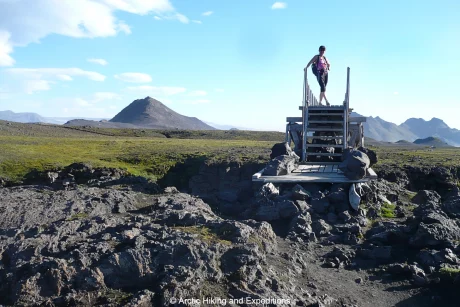
Private trekking tours/hikes

Laugavegur Trail
Arctic hiking and expeditions.
Embark on an unforgettable journey with our thoughtfully crafted multi-day Hiking Tours in Iceland . Immerse yourself in the stunning landscapes of one of the most captivating and lesser-explored islands on Earth. Led by seasoned tour leaders in Arctic exploration, our adventures promise a unique blend of excitement and tranquility.
From June to August, join us for an adventure that transcends the ordinary, offering an experience of a lifetime with Arctic Hiking. Let the magic of Arctic Hiking guide you through this extraordinary Icelandic odyssey.
Iceland Hiking Tours : Explore the Unspoiled Beauty of Iceland
Attention adventurers! If you yearn to discover some of the globe’s most untouched natural wonders, set your sights on Iceland. Situated in the Arctic, Iceland offers an enchanting fusion of rugged mountains, sparkling fjords, towering glaciers , and an abundance of incredible wildlife—a true haven for the intrepid traveler.
Wildlife and Nature in Iceland
Iceland is home to a wealth of spectacular wildlife. From the iconic puffin and resilient arctic fox to the enduring reindeer, the country’s diverse landscapes host a captivating array of fauna. Join us on an exploration of Iceland’s pristine beauty , where each moment promises an extraordinary encounter with nature.
Laugavegur trail, Iceland’s Trekking Jewel
Discover the unparalleled beauty of Iceland in the Laugavegur area . Home to the iconic Laugavegur Trail, this region invites you on a challenging yet rewarding trek through vibrant landscapes, geothermal wonders, and stunning vistas. Embark on an adventure in the heart of Iceland’s highlands , where each step is a journey into untamed beauty.
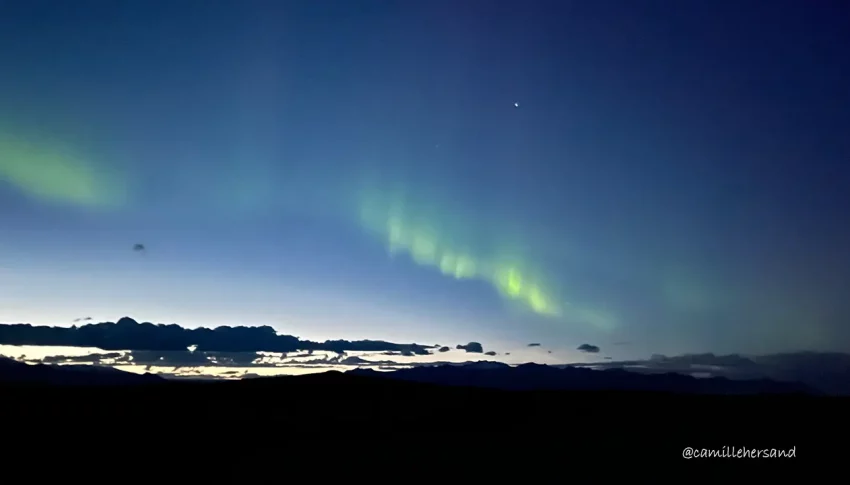
Iceland Northern Lights
The Northern Lights are a natural phenomenon that everyone should witness at least once in their lifetime, and Iceland offers one of the best opportunities to do so. The region is one of the best places to witness the incredible spectacle of the aurora borealis.
Icelandic Adventure tours : Reserve Your Journey Today
An Icelandic adventure promises a lifetime of memories, immersing you in the untouched natural beauty of this extraordinary country. Whether you’re a trekker, hiker, or seeking cross-country exploration , Iceland invites you to experience its diverse landscapes.
The Laugavegur area is just one of the enchanting wonders awaiting you. Marvel at the captivating landscapes of rugged mountains, serene lakes, and geothermal wonders. Encounter the unique wildlife and be captivated by the mesmerizing Northern Lights.
Secure your spot for an Icelandic adventure today and embark on an experience of a lifetime. Iceland, with its stunning natural beauty, rich culture, and captivating history, offers something for every adventurer. Make Iceland a must-visit destination on your bucket list.
travel articles
Read the blog
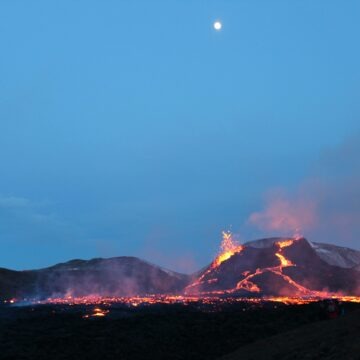
Update on Travel Safety in Iceland in Light of Recent Volcanic Activities
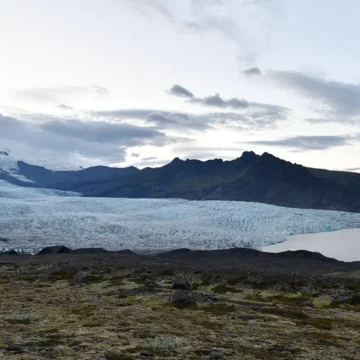
Iceland Trekking

Iceland Hiking tours
Like what you see book your trip today.
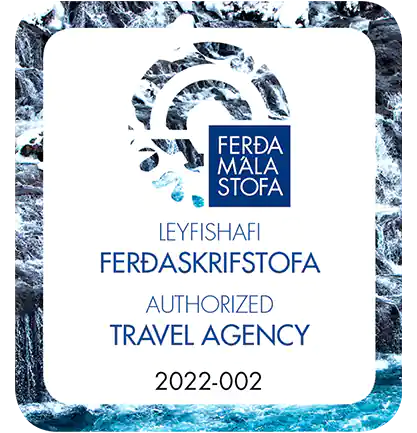
Copyright © 2024 Arctic Hiking and Expeditions
Design & Website by Copetti Marco from Orison-Design
- Einar Torfi Finnsson
- Kristinn Gardarsson
General Information
- Payment terms
Social Media
Iceland is open for travel: check volcano updates here
- Language/Currency EN Language EN English DE German FR French CN Chinese $ USD ISK ISK $ USD € EUR CA$ CAD £ GBP

Self Drive Tours in Iceland
Accommodation & Rental Car Included
- Self-Drive Tours
Meet on location tours
- About Self drive
Escape the crowds and have miles of highway to yourself when you select one of our self drive tour packages. With Arctic Adventures, explore Iceland at your own pace, as fast or as slow as you wish, in the comfort of your very own rental car. Our packages are designed to cover everything, from car rental to accommodation, to the itinerary itself. On the open road, the freedom is yours. Discover Iceland’s hidden gems and venture to the country’s most remote locations. Find our hand-picked excursions prepared by experts, each tailored to provide you with the best experience at the best price.
Self-Drive tours in Iceland

5 Day Self-Drive Tour | Fire & Ice

10 Day Self-Drive Tour | Ring Road Trip

West & South Iceland in 7 Days
A guide to driving around iceland.
A self-drive tour of Iceland is an ideal option for anyone who wants to escape the stress of the world and venture off the beaten path.
There is no doubt that driving is one of the best ways to explore Iceland’s beautiful landscapes. Every corner of the country is blessed with volcanoes, glaciers, waterfalls, and geysers. With so many sites to see, we’d recommend traveling at your own pace to take it all in.

Self-Drive Locations in Iceland
Some of the best destinations for self-drivers include the iconic South Coast and the photogenic Snæfellsnes Peninsula . These locations are most popular with adventure travelers, as they allow you to take in geysers, glacier lagoons, lava fields, mountains, and even a seal colony at Ytri-Tunga beach . Many drivers follow the infamous Ring Road and Golden Circle routes to see these attractions.
Discover our range of Tour Locations today.
Why Choose A Self-Drive Tour?
The biggest reason to choose a self-drive tour is independence. You’ll be free to choose how much time you want to spend exploring one destination or another. It’s the ideal option for people who like to travel at their leisure, whether stopping for a swim in a hot spring, a roadside picture, or a delicious Icelandic hotdog .
Our tours are also a great option for families who would rather enjoy each other’s company than be with a tour group.
Whether you’re driving alone or as part of a group, you can still share the magic of Iceland with other visitors. With a self-drive adventure, you can take part in lots of thrilling outdoor activities and guided tours in your chosen itinerary.
Self-Drive Tour Packages
We always like to go one step further at Arctic Adventures. We’ve created a series of tour packages so that you can take the wheel all year round, enabling you to see the country’s sites across all four seasons.

Our packages allow you to experience the best of both worlds. They combine the flexibility of a self-drive tour with the handiness of a guided tour. Here are just some of the reasons why you should tour with Arctic Adventures:
- We’re experts - Our family consists of very interesting and adventurous people from across the globe. We all share a need to be professional, each of us in our own field, and are knowledgeable in everything in Iceland.
- We’re sustainable - We’ve achieved official recognition as a sustainable tour company and strive to work in harmony with nature, local communities and the people living in them.
- We’re qualified - Our safety standards and quality of service are very hard to match. All of our guides hold certificates in wilderness first aid and possess the relevant leadership and rescue qualifications .
What’s Included?
All of our tours of Iceland include a detailed map, an itinerary of your desired route, and pre-booked accommodation. We also organize your car hire at the airport or Reykjavik City office in downtown Reykjavík . It is our goal to remove any unwanted stress from your shoulders, allowing you to immerse yourself in all that Iceland has to offer.
Thanks to our wealth of local knowledge, our itineraries include all of the popular attractions , as well as an abundance of hidden gems . Escape the busy crowds and discover something new every day on your tour!
At Arctic Adventures, we also give customers the option to meet on location for a tour. This means you can enjoy the independence of a self-drive tour while still joining a planned activity or two. This way you get the full guided tour experience without sacrificing your freedom.
Iceland Guided Tours
For tourists who are nervous about driving in Iceland or simply want to hand the reins over to someone else, a guided tour is the best option for you.

Driving in Iceland, especially during the winter, can be challenging, and even more so for people who’ve never driven in snow or ice. The harsh Icelandic winters make it surprisingly easy to get stuck or break down while driving if you aren’t careful, so caution is advised.
Our guided tours allow you to explore the country with the help of an expert guide, without the need for driving. Meet like-minded adventurers from all over the world and discover the natural wonders of Iceland, whilst taking advantage of the local knowledge from our experts. View our selection of Guided Tours today.
About Driving in Iceland
When driving in Iceland, it is important to understand the rules of the road, as they can differ greatly from other countries. To ensure your safety, we’d advise informing yourself on the laws and regulations, road conditions and road system of Iceland, so that you know exactly what to expect. Take a look at our guide to driving in Iceland for more information.
Should you have any questions about our selection of self-drive tours, please get in touch with our team. We can help advise you on which tour would be best for you and can provide additional information on what you can expect during your experience. We also have exclusive discounts on a variety of our tours, so take a look at what’s on offer!
You can check your bookings on My Bookings .
Share our passion for Iceland, get top travel stories & special offers to your inbox
Luxury Private Tours
Amazing tours
We specialise in tailor made tours in Iceland and privately operated jeep tours. Prepare to be amazed by Icelandic glaciers, blazing Northern Lights and natural ice caves.
Multi Day Tours
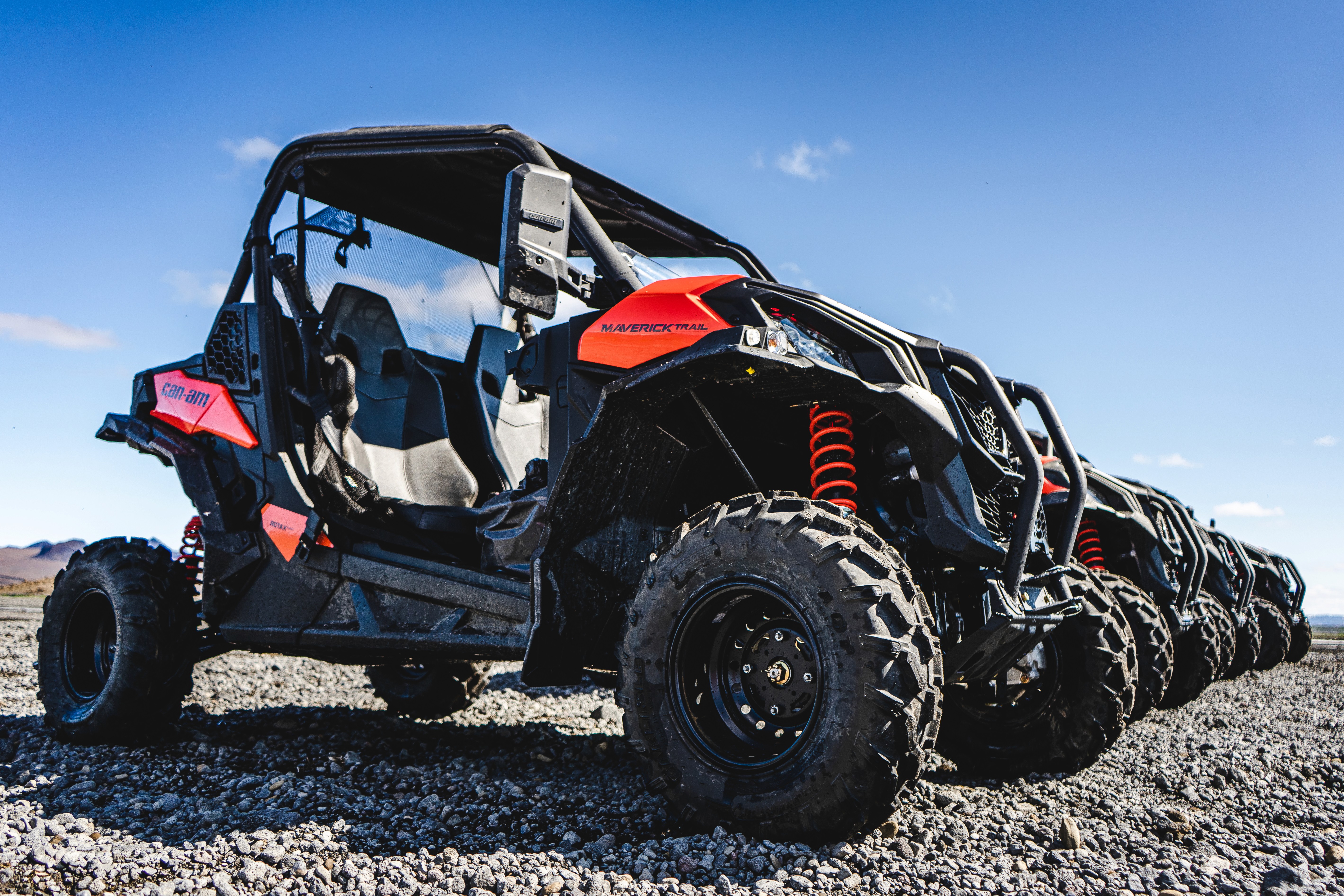
Buggy Adventure in the Geysir Area
from 32.450 ISK

Golden Circle and Snowmobile Adventure from Reykjavik
from 49.500 ISK
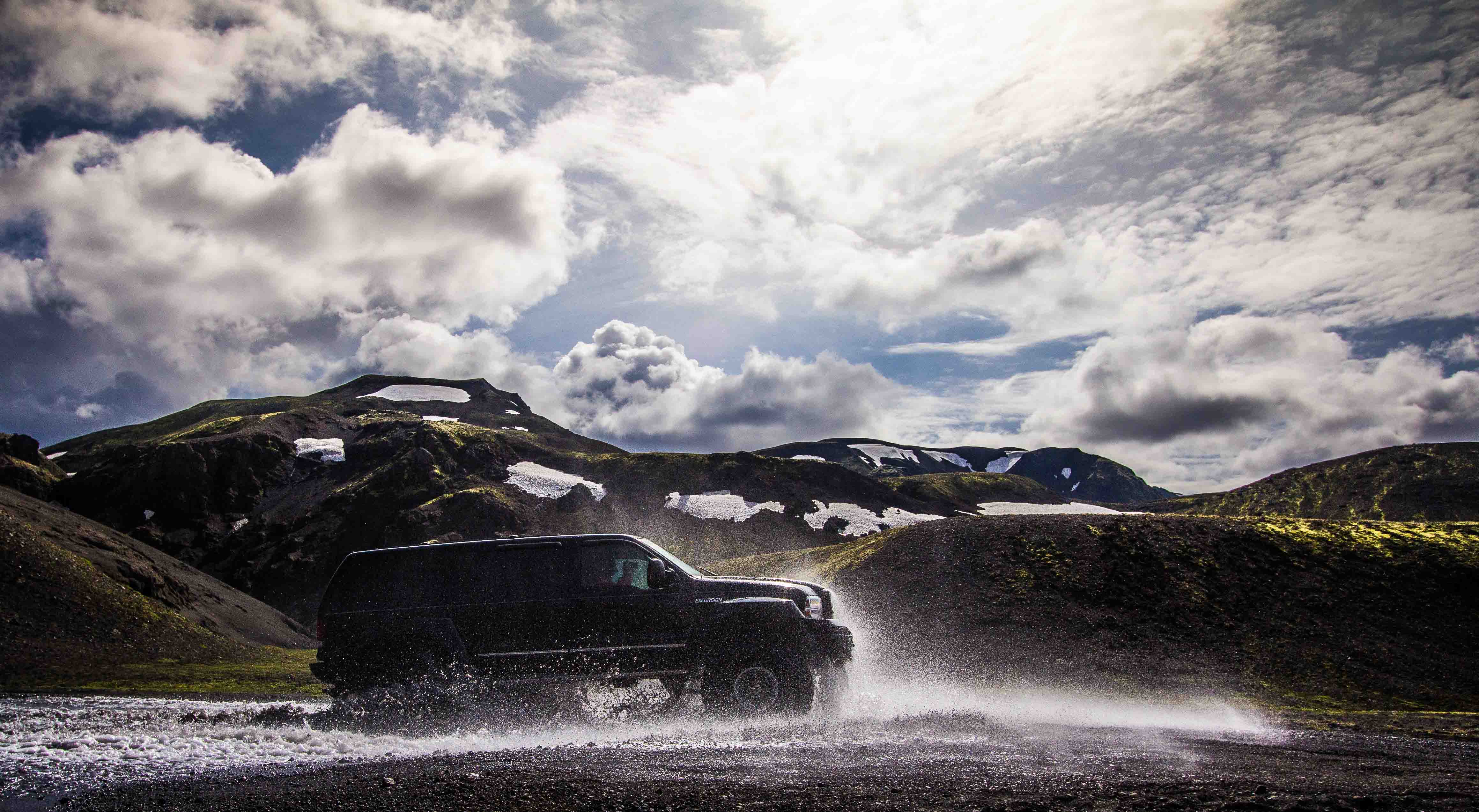
Southcoast Super Jeep Adventure
from 885.000 ISK

Private Tour
4 nights / 5 days

Ultimate Southcoast and Golden Circle Adventure with Reykjanes Peninsula
from 675.000 ISK
3 nights / 4 days

The Silver Circle and Ultimate Southcoast Adventure
from 650.000 ISK
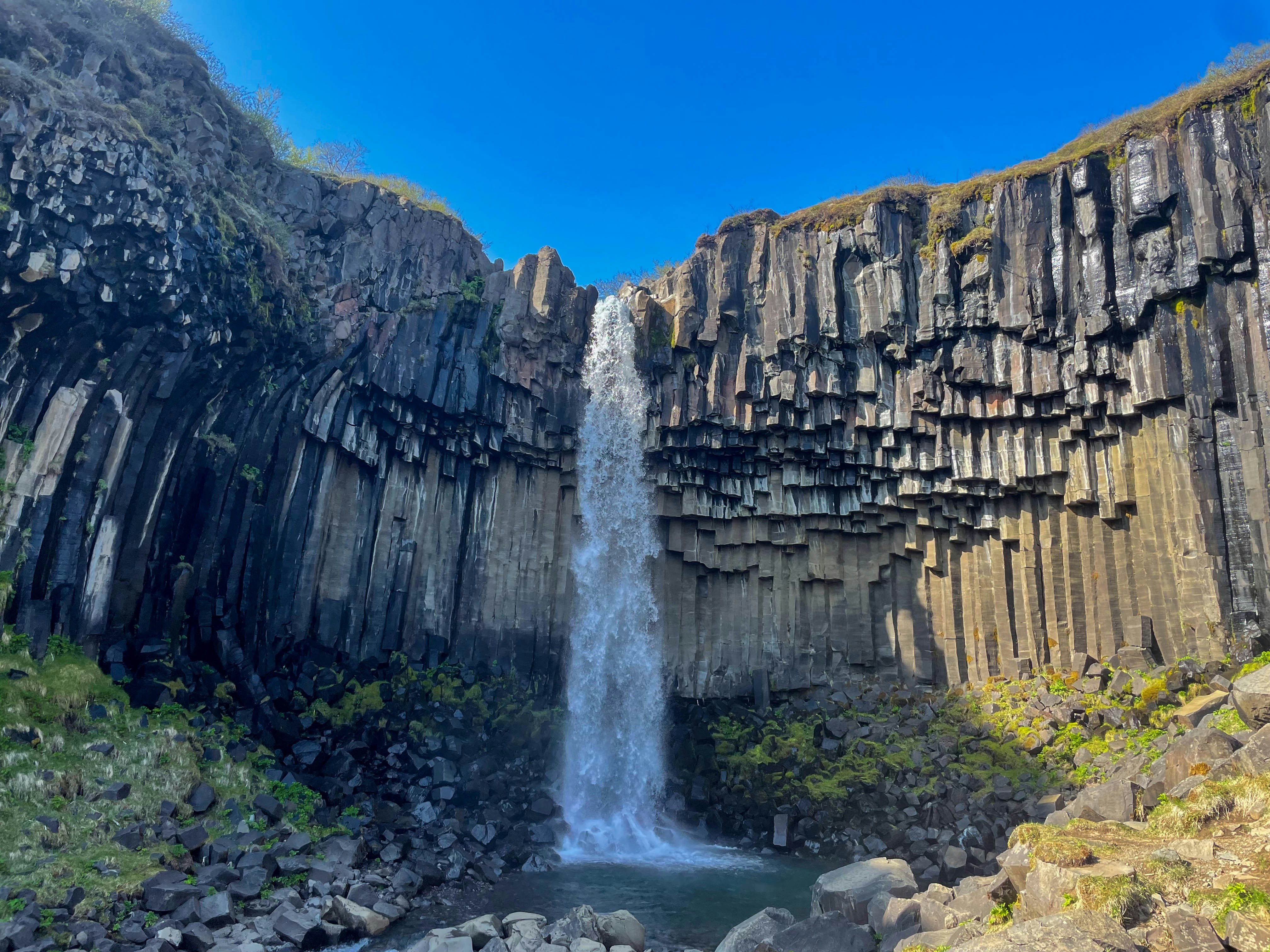
Highlights around Iceland
from 1.270.000 ISK
6 nights / 7 days
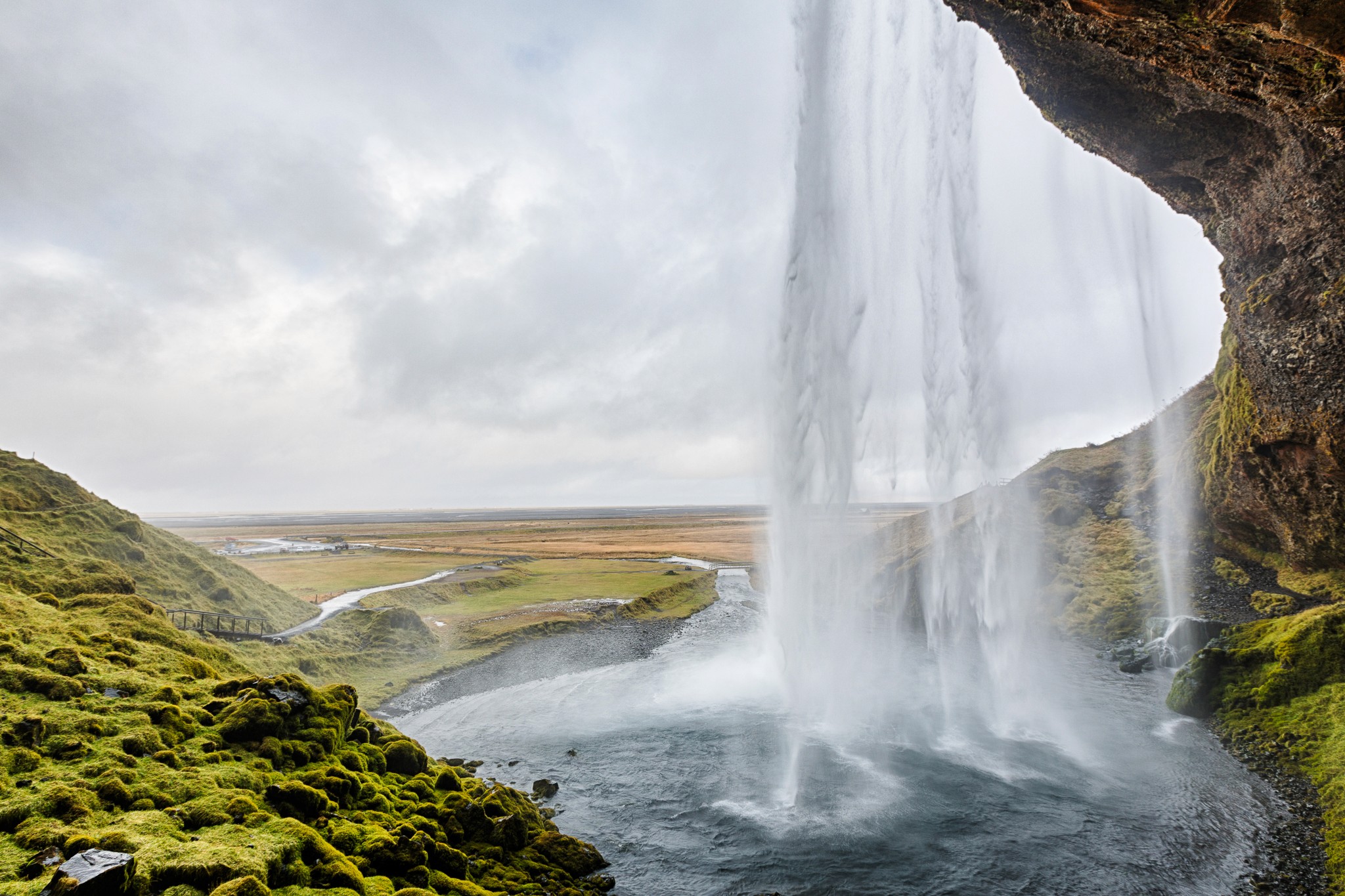
The Golden Circle and Southcoast Adventure
from 445.000 ISK
2 nights / 3 days
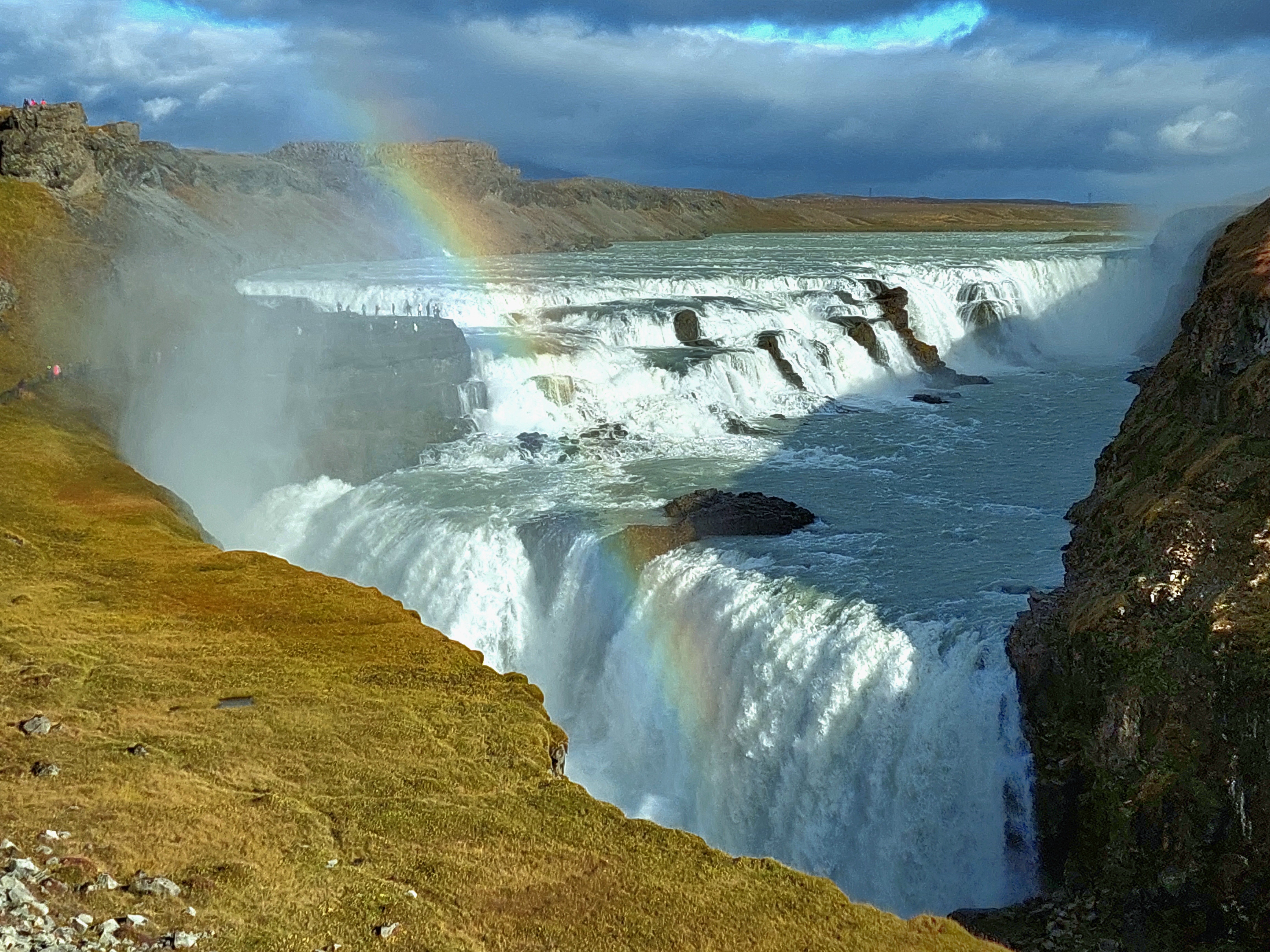
The Golden Circle with Glacier Adventure
from 232.960 ISK

Highland Adventure Tour in the Heart of Iceland
from 510.000 ISK
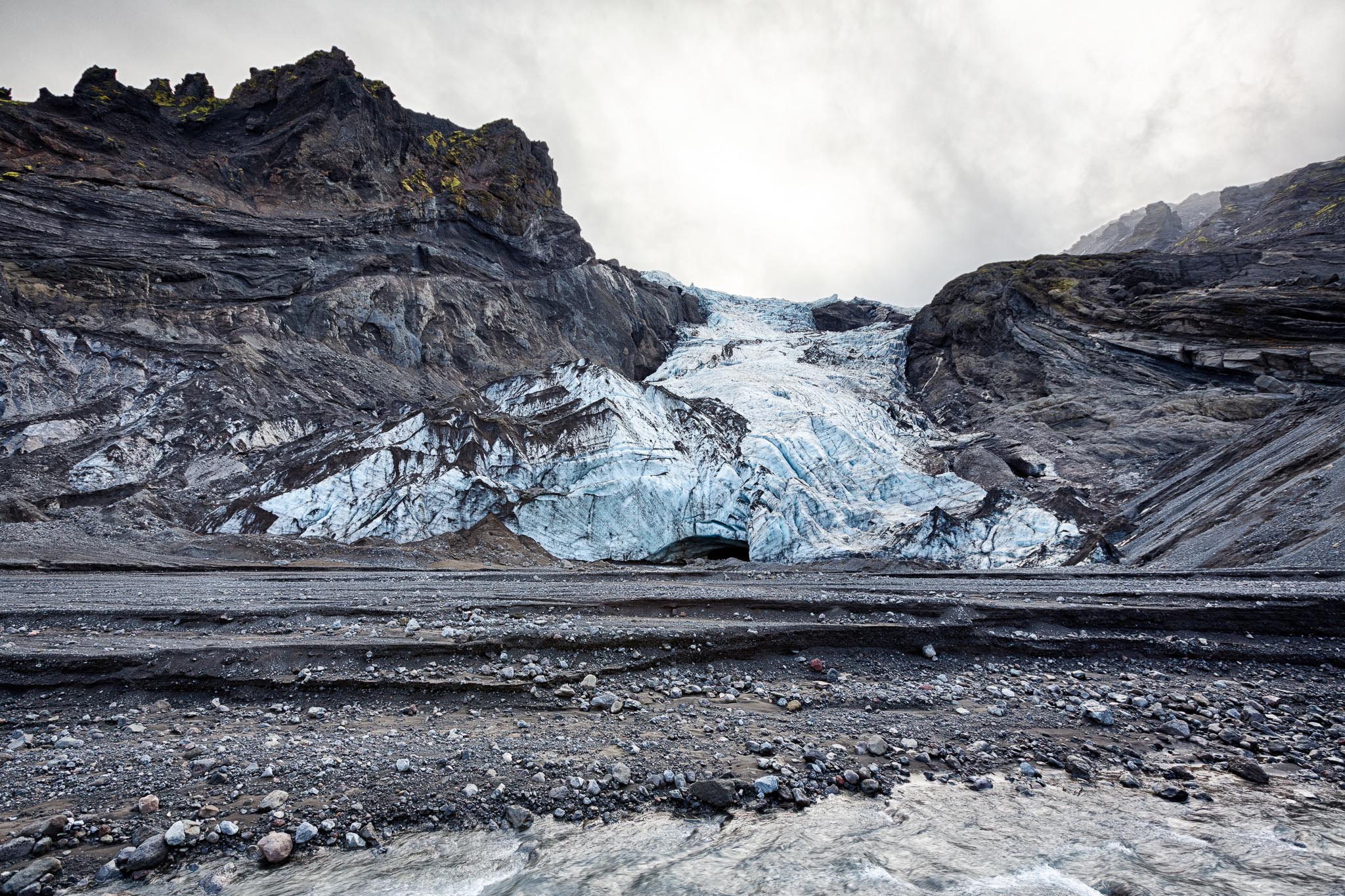
Eyjafjallajokull Glacier and Thorsmork Highland tour
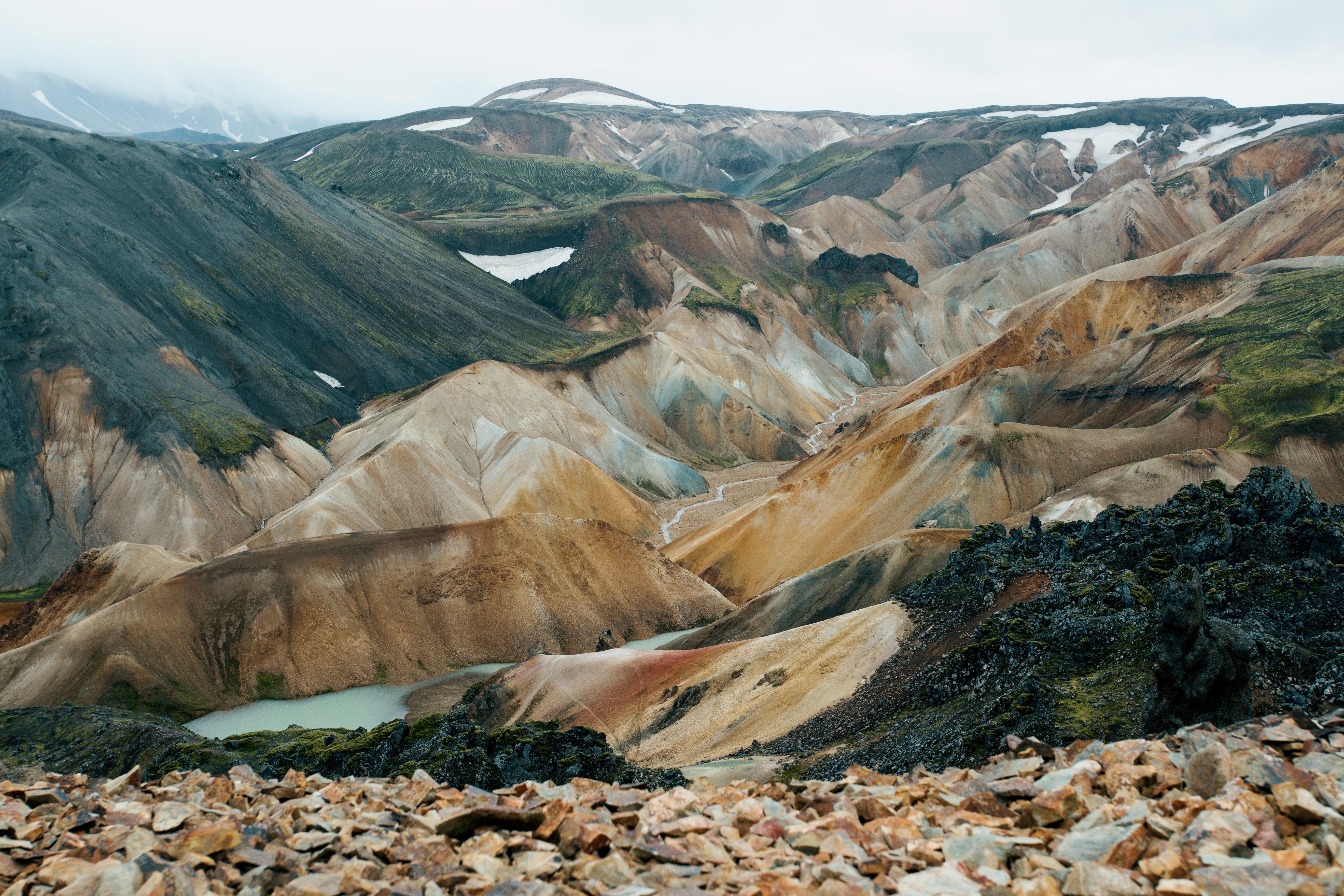
Landmannalaugar Highland Adventure
from 273.900 ISK
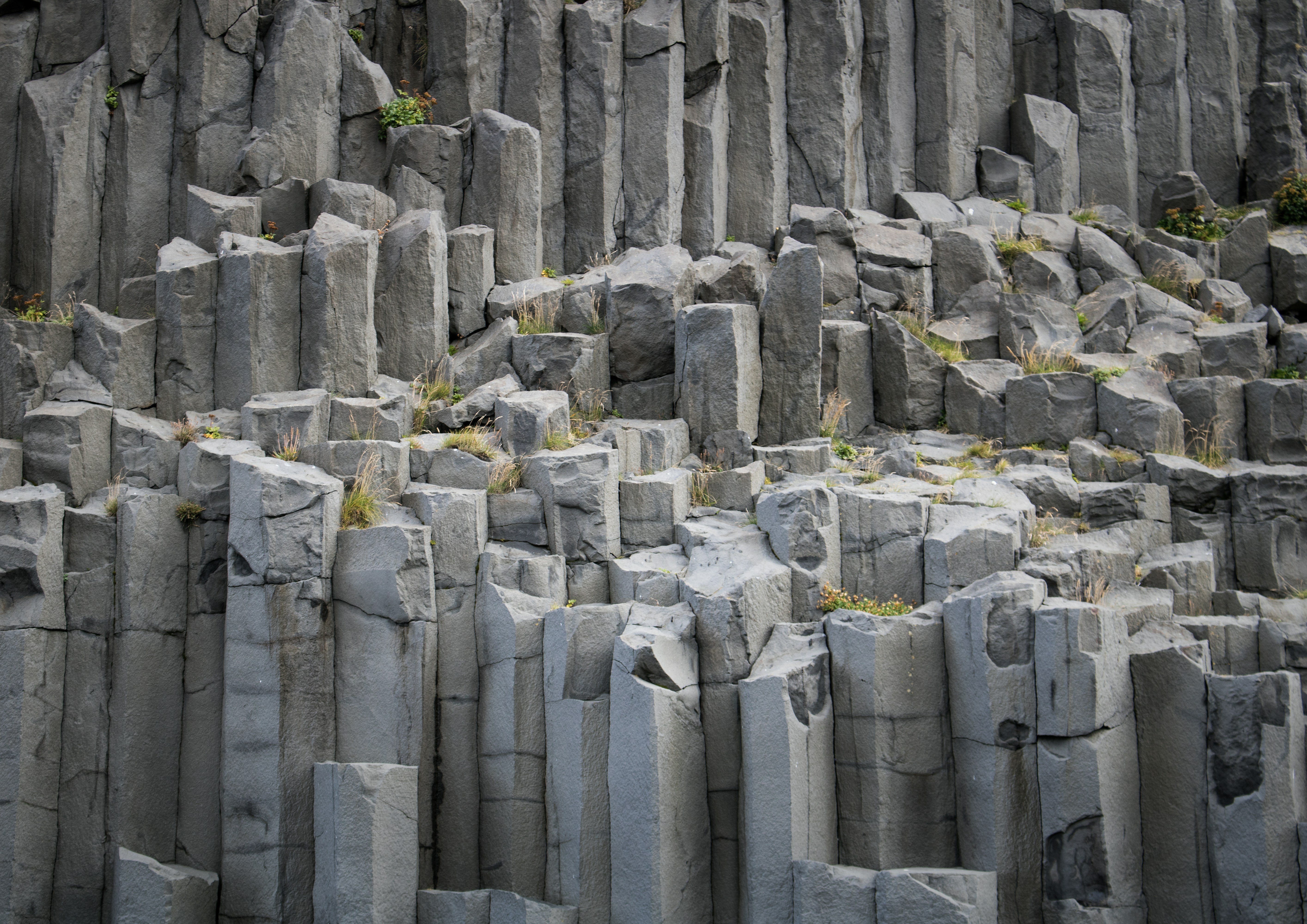
Ultimate Iceland Southcoast Adventure

The Silver Circle with Highland Adventure tour
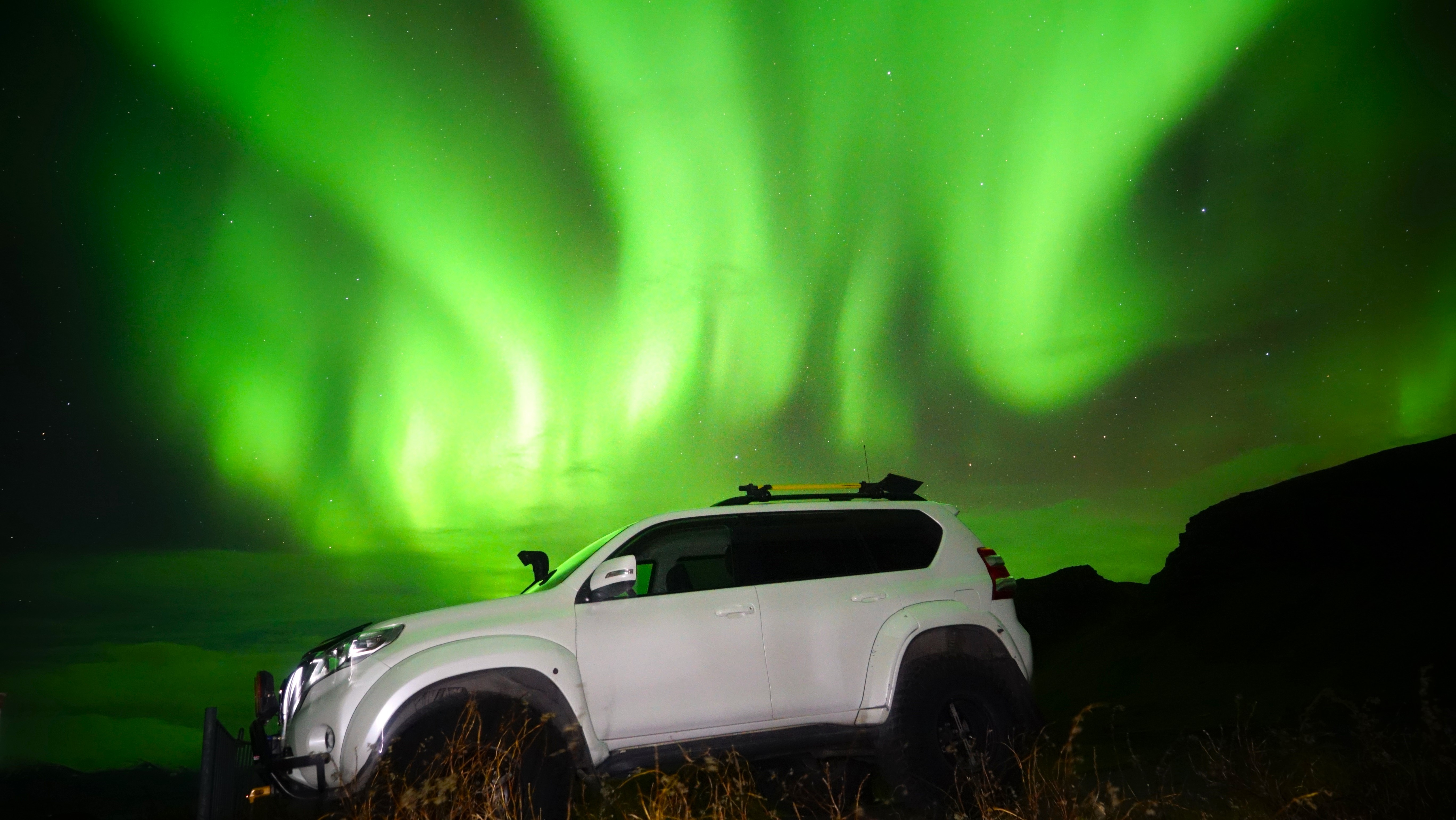
Magical Northern lights
from 174.720 ISK

We're here to help. Whether you're spending a full day, multiple days, or just a few hours exploring Iceland, our service is specifically tailored to enhance and maximize your experience.
Get in touch

Tailor Made
Inspiration

Eldshöfði 12, 110 Reykjavík


+354 517 4455
Copyright 2024, Amazing tours - All rights reserved

A first-timer’s guide to Reykjavík

Jun 14, 2024 • 9 min read

The iconic mountain of Esja across the bay from the pocket-sized capital of Reykjavík © darekm101 / Getty Images
You may have seen pictures of Reykjavík’s brightly colored houses tiered along the shore, the vibrant cafes and bars in Reykjavik 101 (the centre of the city) or drone footage of fireworks over the ziggurat of Hallgrímskirkja , slicing the skyline. Iceland’s capital promises all of this and more.
Reykjavík is full of life year-round. Around 60% of the country’s population lives in the capital region, making the most of their long winters with superb arts and crafts, an excellent live-music scene and world-class restaurants, paired with humble hot dog stands . And let’s not forget the toasty hot springs, perfect for soaking and taking the chill out of your bones after a long walk .
Combine your city break with a day trip , or more, to explore the volcanoes, waterfalls and glaciers that radiate out across this splendid, welcoming island.
When should I go to Reykjavík?
The streets of Reykjavík fill right up from June to August when visitors flock to Iceland for its warm(ish) summer season, long days, and the access the season brings to the countryside. Some of the most extreme mountain roads (called F roads in Iceland) only open from mid- to late-June and close by the end of August when the ice and snow starts to accumulate again. The downside? Prices are at their highest and you need to have booked at least six months in advance for good accommodation, and the best deals on car hire and the most coveted tours.
Spring and autumn are a chance to visit when the crowds are fewer so these big open spaces seem more your own and you share the streets of the capital more with Reykjavikers. The weather is variable – but really, it can be all year round – so pack accordingly, but prices are softer and availability more kind. Also, you can still access much of the country.
Winter is the province of darkness and austere adventure. Full daylight hours are miniscule – just 3 or 4 hours – but the atmospheric sunrises and sunsets make for great viewing, and it’s the chance to see the Northern Lights, too. Many country hotels and restaurants close or reduce services (especially over the December holidays), but Reykjavík itself remains open for all comers. Prices are at their most affordable.
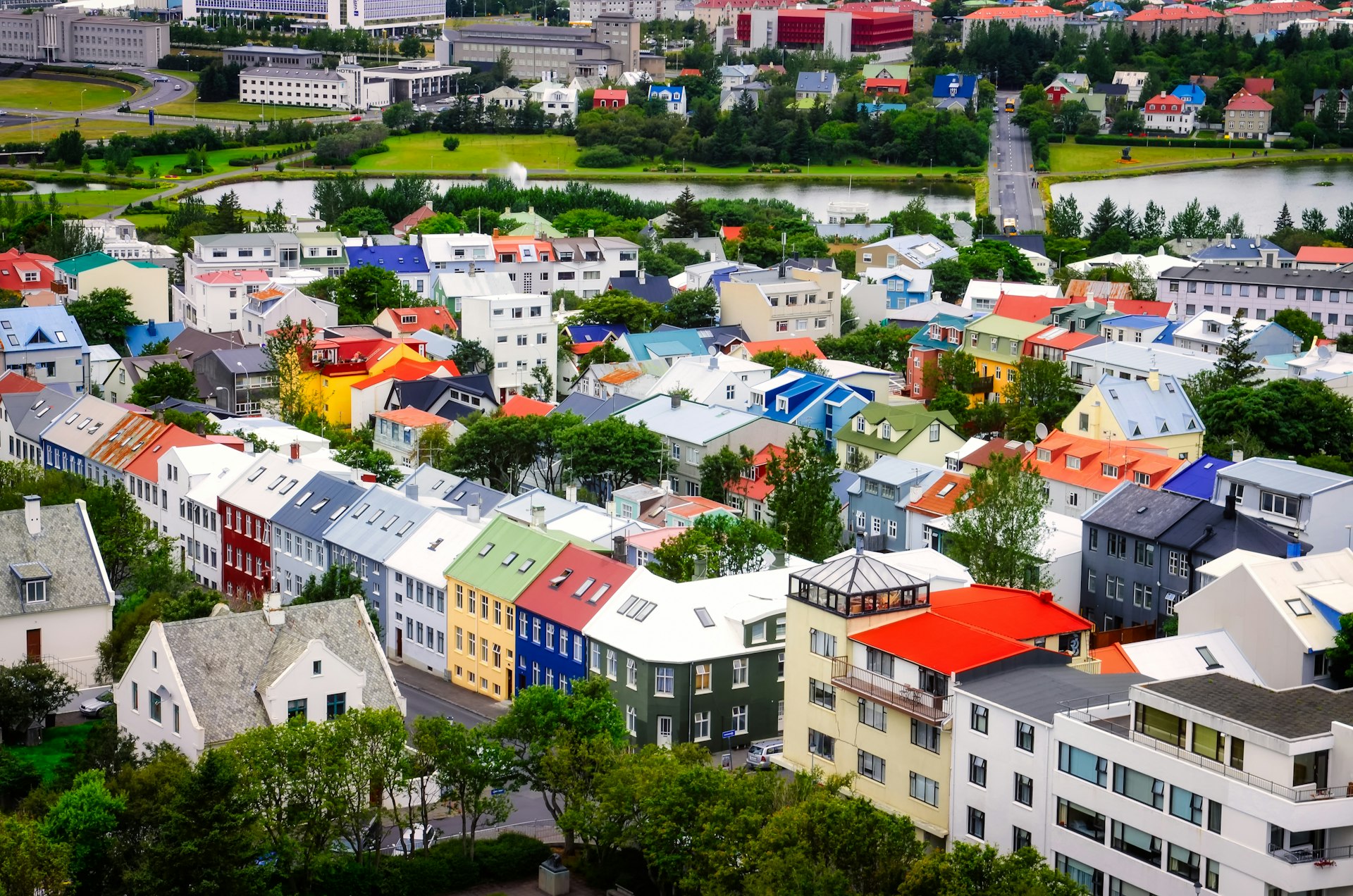
How much time should I spend in Reykjavík?
Well, I’d say forever. But if you have to limit your trip, you could soak up a lot of the Reykjavík vibe and hit its top sights in a matter of two or three days. You’d get to have leisurely coffees and kleinur (bow-shaped donuts) or ástarpungar ("love ball" donut spheres with raisins), shop design boutiques , visit art museums and galleries , plus get all the selfies – from churchside to the Sun Voyager statue and Old Harbour.
Then I’d surely suggest another two days, minimum, to get out into the countryside or go on a whale watching trip and other excursions. The activities are gobsmacking – from ice climbing, glacier walking and snowmobiling, to hiking or puffin viewing in the back of a farm tractor, or simply strolling behind the shimmering sheet of a coursing waterfall.
Winter has its Northern Lights chasing (get help at with the aurora forecast ) and ice caves firm up at glacier edges (they are unstable the rest of the year). With a very short drive you’ll reach iconic places like the original parliament site in the rift valley of Þingvellir National Park , or the active fissure volcanoes around the Reykjanes Peninsula (when they’re safe to observe) and the lagoons, hot springs and pools. You could easily spend weeks in the countryside. But that’s another article , two or three .
Is it easy to get to and around Reykjavík?
Reykjavík is the primary international gateway to Iceland, so its Keflavík International Airport (KEF), about 49km southwest of Reykjavík, always seems to be expanding. There are also a few flights from Greenland and the Faroe Islands which arrive at Reykjavík Domestic Airport. Icelandic transport is generally efficient and accessible. Unless you are jumping in a hire car to tour outside of Reykjavík immediately, then Flybus and Airport Direct run regularly to the city centre (and are cheaper than taxis), or take public bus 55 for 2300kr.
The centre is enjoyably walkable, with tidy straight streets and lots to look at, all in a compact area surrounding Lake Tjörnin. The bus network ( Strætó , with its handy app Klappið) works very well for the further reaches of the city. A car is really unnecessary if you are staying in the capital unless you have mobility issues.
For getting out into the countryside and road tripping , you can either hire a car or camper or join one of the many, many tours and excursions that include pickup in Reykjavík. Public bus routes beyond the capital are targeted to Icelandic villages and towns, and services in some areas are reduced or cut altogether in winter.
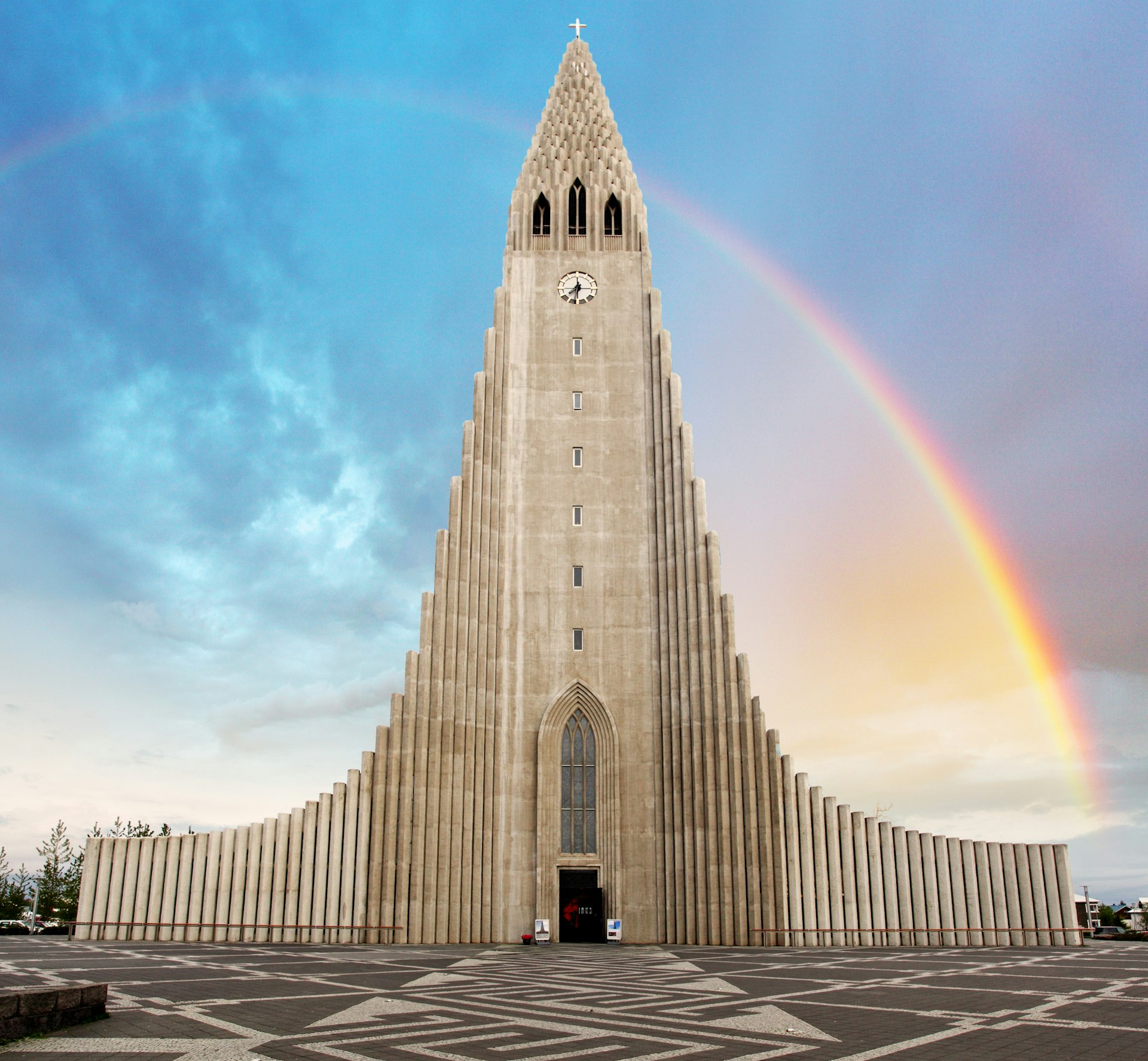
Top things to do in Reykjavík
Part of the real fun of Reykjavík is to walk around and explore. Since it’s got such a compact city centre, grabbing a coffee (Icelanders love their coffee) and baked goodie (try Sandholt or Brauð & Co ) and window-shopping on pedestrianized Laugavegur and Skólavörðustígur easily lead to a visit to Hallgrímskirkja or the several branches of the Reykjavík Art Museum and the nearby Photography Museum .
You can also stroll through the Old Reykjavik district , for a history hit, checking out the earliest buildings, including a Viking longhouse at Aðalstræti Settlement Exhibition . Then continue south along lake Tjörnin to the National Museum .
I also love a walk around the Old Harbour with Harpa concert hall glittering in the distance – definitely stopping for a meal at one of the many great seafood spots, from high-end delish Matur og Drykkur to casual comfort food in the Grandi Mathöll (food hall) and craft beer at the Bryggjan Brugghús or Lady Brewery . In fact, the area around Grandi is also a loaded with entertainments – from whale- and puffin-spotting boat excursions to many kid-friendly places like the Saga Museum , Whales of Iceland and the Omnom chocolate factory .
Oh, and don’t miss hearing live local music while you’re in town. Reykjavikers know how to put on a good show. You can warm up at Kaffibarinn or with a visit to a few of the excellent brew pubs in the centre – like Kaldi , Micro Bar and Skúli .

My favorite thing to do in Reykjavík
No matter the time of year, I love, love, love soaking in Icelandic waters. Every town in Iceland has a pool and geothermal hot spring (or several), and in the capital I love the cool vintage pool with multiple hot pots, cold plunge, sauna and steam room at central Sundhöllin (little fact: it was designed in the 1930s by the same architect who did Hallgrímskirkja).
You can also head out to the windswept Seltjarnarnes neighbourhood for a walk around the lighthouse then a soak at its pool . To the east of the centre, the awesome Laugardalur pool complex has twisting water slides and abuts the botanic garden , more art and a sculpture museum and is near the jumping off point to remote-feeling Viðey Island .
Etiquette tip: shower before getting into a pool or hot spring
It is an absolute all over Iceland that if you are going to swim or soak you must shower using soap (without your swimsuit on) and wash your hair in the provided changing/shower room. It’s basic Icelandic hygiene and allows the pools to have minimal or no chlorine or chemicals added.
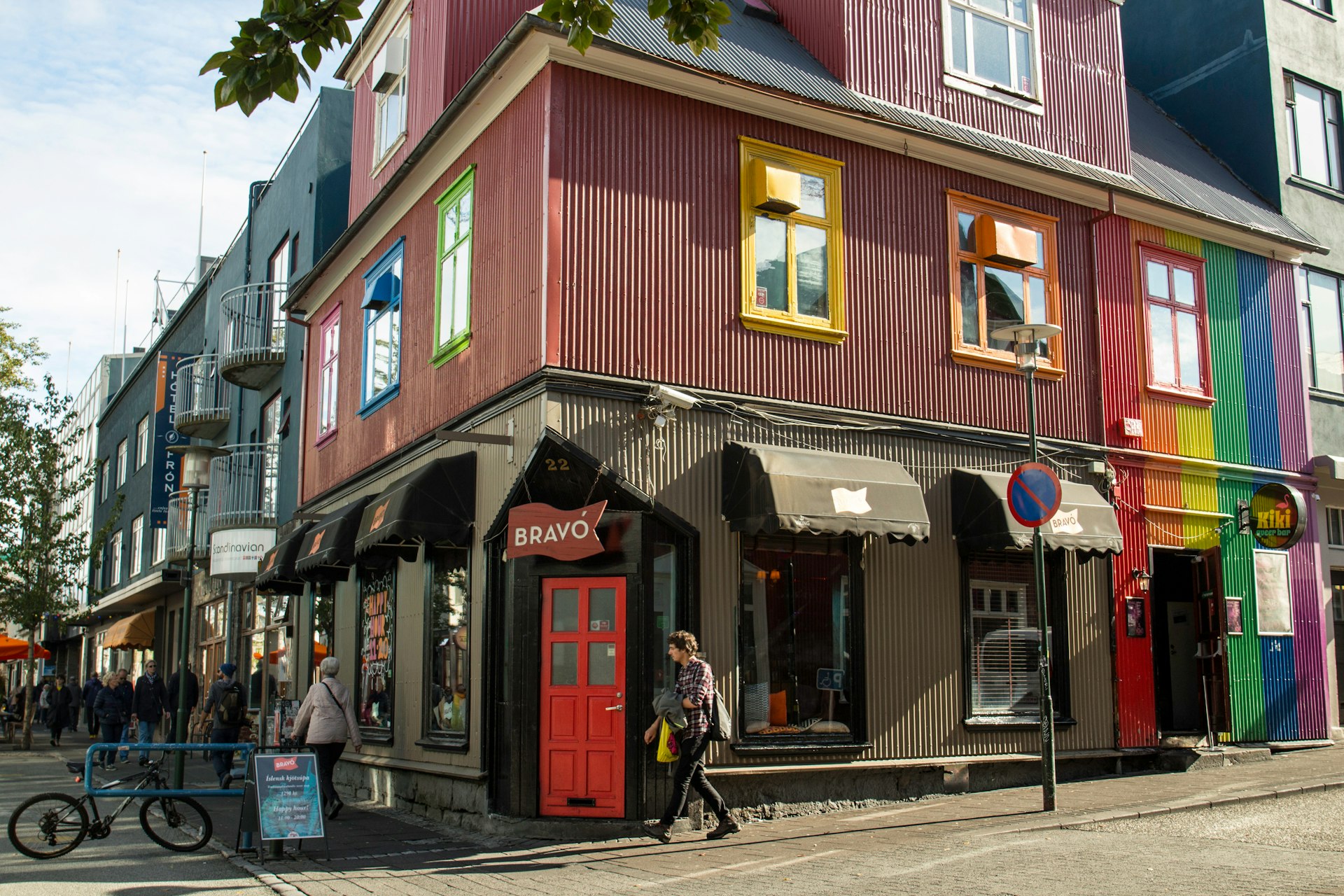
How much money do I need for Reykjavík?
Iceland ain’t cheap. And Reykjavík is among the most expensive places in the country, especially for lodging (boutique double room 36,000–51,500kr). You can help yourself out by booking well ahead to get the best deals (guesthouse double room with shared bathroom 22,000–29,000kr). Or visit outside of high season summer.
Bars (beer 1050-1700kr) and restaurants are pricey as well – with a warm soup and homemade bread (1700–2500kr) costing what a full meal might cost in southern European countries. I usually combine some eating out (whether a hot dog 300-600kr, cafe meal 2500–5500kr, or a main dish in a top restaurant 4500–7000kr) with a fair dose of self-catering (I often rent a small studio apartment). While groceries are not cheap they at least make it easier to save a few krona . Another budgeting trick? Buy alcohol in the airport arrivals hall’s duty-free shop as you come into the country for big savings.
The fact is, the cost is well worth it. Iceland is such a special country that no matter how many days you can afford, a visit will pay you back in lifetime memory dividends. Plus, quality is generally high. Your splurge of a trip should get you clean, well-run accommodations and delicious homemade food. You can also economize by staying in a hostel (dorm bed 5000–7000kr), camping (1500–2500kr) or, if you’re heading to the countryside, hiring a camper van where you can stay in the marked campgrounds most towns offer.

Bring lots of layers, no matter the season
What you can predict about weather in Reykjavík is that it is unpredictable. A sunny, warm (60°F/16°C) day can easily turn to storm and cloud, what with the island’s location in the middle of the Atlantic. Always pack layers and always bring them with you when you head out on a hike. Ideally, you’ll have a thick/warm wool (or synthetic that dries well) underlayer and a waterproof outerlayer.
Do I need to know Icelandic?
Most Icelanders speak impeccable English, making travel for anyone who can make do in English rather easy. Some of the older generations do not, however, and in general learning a few expressions like takk fyrir (thank you) is simply polite and more fun .
How can I be a responsible traveller in and around Reykjavík?
Iceland’s online resources are superb and they have a network of sites and apps to help plan for safe travel if you leave the capital at all. Some top sites to check out are Visit Iceland and Visit Reykjavík for inspiration and information. Sjalfsbjorg.is provides short-term mobility equipment rental and curated lists of accessible hotels, restaurants and transport options.
Reykjavík Grapevine is a great English-language newspaper and website with current cultural listings. Entertaining and informative Iceland podcasts to get you in the mood include All Things Iceland and Stories of Iceland .
Despite the summer festival vibe in the capital, always be respectful of its residents’ needs – though it can get busy, it’s still people’s home, and overtourism and jacked up apartment prices are a real concern. When a few Icelanders ate whale, shark or puffin it could be sustainable, but when 1 million tourists do, not so much.
If you leave the capital stay on marked roads and protect the truly unspoilt nature (you don’t want to be the one to spoil it). Only use designated areas for camping and actual toilets for your pit stops. Check weather and road conditions before heading out. If you're going hiking, register at Safe Travel and learn about staying safe. They’ve all got apps, too.
Explore related stories

Tips & Advice
Jun 12, 2024 • 12 min read
There is simply no way to tour Europe and not be awestruck by its natural beauty, epic history and dazzling artistic and culinary diversity.
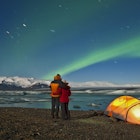
Feb 6, 2024 • 7 min read
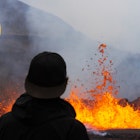
Dec 19, 2023 • 6 min read
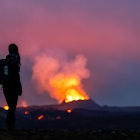
Nov 13, 2023 • 5 min read
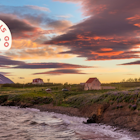
Nov 3, 2023 • 4 min read
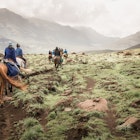
Dec 26, 2022 • 14 min read

Dec 10, 2022 • 7 min read

Sep 15, 2022 • 8 min read
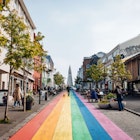
Jun 8, 2022 • 5 min read
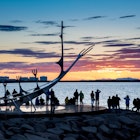
Jun 4, 2022 • 6 min read
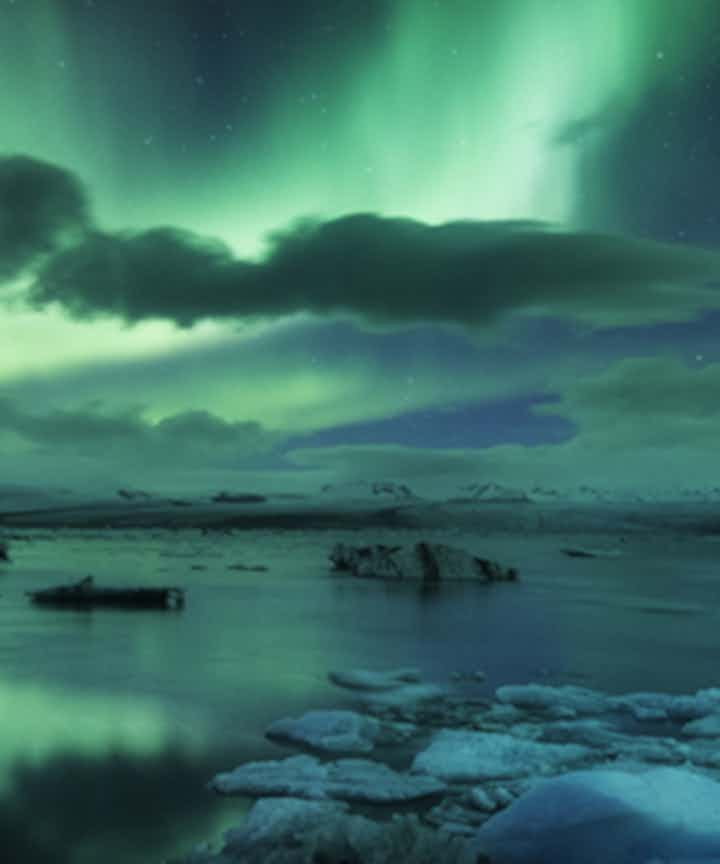
Best Northern Lights Tours in Iceland
Select starting location
Select dates
Add travelers
Northern Lights Tours & Holidays
Refine the results by using the filters
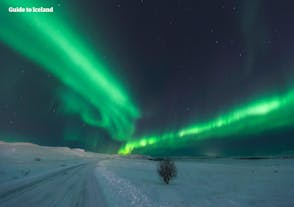
8-Day Northern Lights Winter Self-Drive Tour of West and South Iceland with Ice Caving
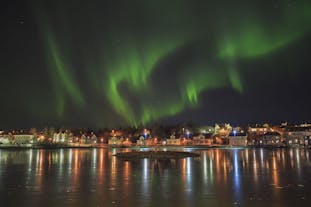
Affordable 3 Hour Northern Lights Bus Tour with Transfer from Reykjavík

Northern Lights Super Jeep Tour with a Photographer Guide & Transfer from Reykjavik

Amazing 2 Hour Northern Lights Cruise with Transfer from Reykjavik Harbor
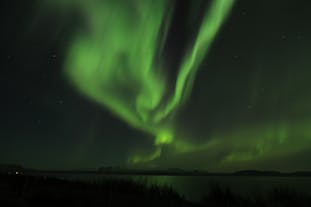
Northern Lights Bus Tour with Transfer from Reykjavik
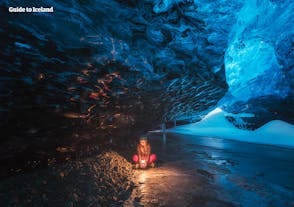
Amazing 5-Day Northern Lights Winter Vacation Package in Iceland with Ice Caving & the Blue Lagoon

Magical 2 Hour Northern Lights Boat Cruise with Transfer from Reykjavik
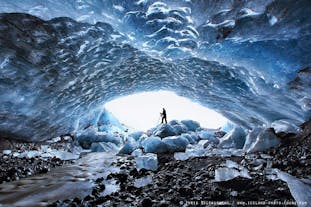
3-Day Northern Lights Tour of Iceland’s Golden Circle & South Coast with Ice Caving & Glacier Hiking
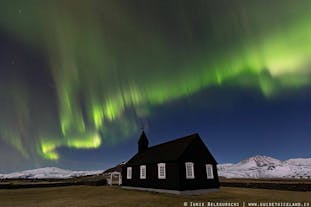
Best 7-Day Northern Lights Self Drive Tour Through South Iceland to Jokulsarlon Ice Cave
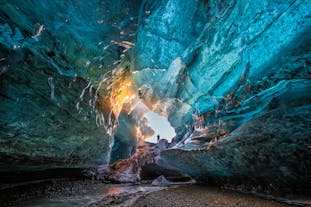
2 Day Ice Cave Tour with South Coast Waterfalls & Jokulsarlon Glacier Lagoon
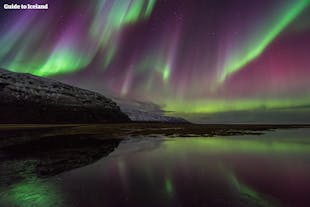
Breathtaking 6-Day Northern Lights Hunting Package of Iceland with Ice Caving
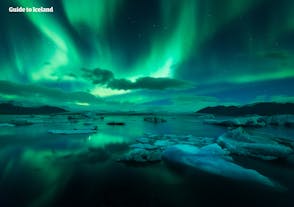
8-Day Guided Northern Lights Winter Tour of the Complete Ring Road of Iceland
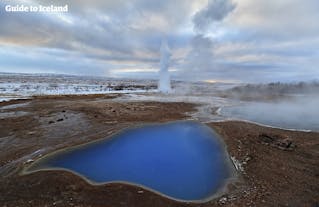
Northern Lights & Golden Circle Tour with Audio Guide & Transfer from Reykjavik
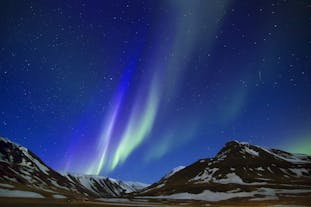
Magical 3 Hour Northern Lights Tour with an Audio Guide in 10 Languages & Transfer from Reykjavik
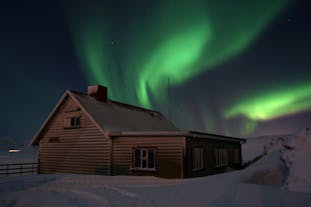
Northern Lights Mystery
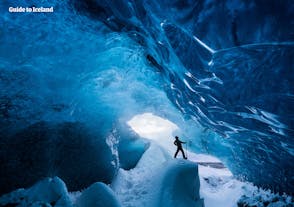
Small Group 6-Day Northern Lights Winter Tour of the Complete Ring Road of Iceland
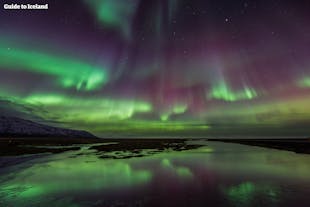
7-Day Northern Lights Winter Vacation Package with Ice Caving

Northern Lights Tour With Photographer
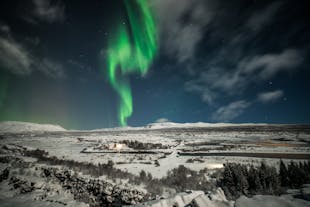
Magical 4-Hour Aurora Museum and Northern Lights Minibus Tour from Reykjavik
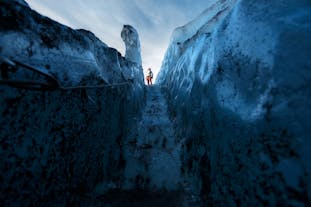
2 Day Northern Lights & Ice Cave Tour with Glacier Hiking & Jokulsarlon Glacier Lagoon
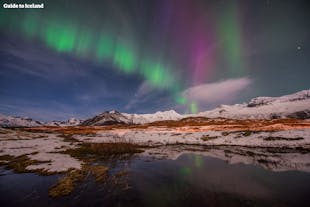
Small Group 4-Day Northern Lights Winter Vacation Package with Golden Circle & South Coast
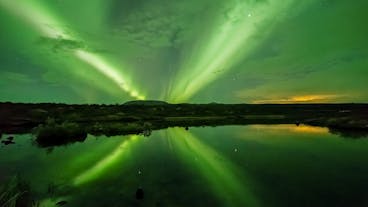
Serene 2-3 Hour Northern Lights Boat Tour from Reykjavik

2 in 1 Bundle Discount Tours | All National Parks & Ice Caving
2-Day West Coast & Snaefellsnes Peninsula with Lava Caving & Northern Lights Tour
Explore an unequalled wealth of tours and packages
Vacation Packages in Iceland
Self drive tours in iceland, tour calendar, nature tours in iceland, adventure tours in iceland, cheap bus tours in iceland, top tour destinations in iceland, verified customer reviews.
Read first-hand reviews by customers from across the world

Wonderful Aurora Hunting Tour Experience! Although the aurora was not very visible, it still made for a fantastic memory. The tour was initially set for three hours, but due to poor visibility that evening, the team didn't give up. They continued to search for the northern lights and managed to capture some faint camera lights after 2 AM. Despite running overtime and it being very late, they provided ample opportunity for those still energized to get off the bus and try their luck at spotting and photographing the lights. It was the last day of the aurora season, and on the way back, the guide explained that this time didn’t count as a successful sighting and offered a chance to join another tour within the next two years. I’m truly grateful for the team's dedication and effort. Thank you for making it a memorable experience!

Pyeseghl Aurelio
Great Golden Circle tour with a knowledgeable tour guide. The Northern Lights tour guide was very enthusiastic about the phenomenon and you could tell from the way he talked about it. Unfortunately, we only saw a small trail during our time there, which lasted roughly 4 hours. The lead guide was trying to see if we could chase another sighting on the way back to Reykjavik but we ended up heading straight back. The effort that the guides took into to ensure possible sightings was admirable and definitely a stark change from another tour that we went on the previous night. Whilst the offer of rebooking the tour was there, unfortunately we were leaving the next day so were unable to try again during the trip. However, the enthusiasm the guides experienced and the fact that they did try to go to another site to ensure a sighting is why next time I shall book with the same company (Grey Line Iceland) .

Phoebe Cheuk
The guide Romeo was friendly. He prepared hot chocolate and fire in cold weather. The places he chosen for seeing the northern lights are perfect. It is important to wear warm clothes and gloves because your feet and hands will be freezing outdoors at cold night !

Morgan W Hizer
Where to begin! This was absolutely the best trip of my life. I’ve been planning this trip since September of 2023. Guide to Iceland had so much helpful information about the country that assisted in knowing what to expect. If I had any questions they were quick in responding. I did encounter a couple hiccups which I feel was partially out of their control, however they were quick in fixing the situation. I unfortunately didn’t get to see the Northern Lights, nor was I able to do one thing on my journey the way they planned it and it being closed on the day they planned it on the itinerary. Just gives me a reason to come back, so I made peace with it. I’d recommend this and using them to assist in making your dream a reality.
What are the Northern Lights?
The northern lights, otherwise known as the Aurora Borealis, are phenomena that occur at high latitudes when solar particles ionise as they enter the earth's atmosphere, appearing in the night sky in the form of waving ribbons of colour. These ‘ribbons’ have captivated their viewers for centuries, bringing about defying awe and unspeakable mystery.
The northern lights are, in fact, occurring throughout the year, yet it is only during the dark winter nights that they become visible to the human eye. This is, naturally, what makes northern light hunting one of the most popular winter activities in Iceland. You can partake in numerous tours that take you to the best northern lights spotting locations, such as an affordable Northern Lights Bus Tour that takes you far away from the city's light-pollution, or a Northern Lights Boat Cruise that allows you to witness the auroras out on the open sea. Outside of Scandinavia, it is only possible to go northern light hunting in such places as Alaska, northern Canada and Siberia.
Modern scientific understanding of the northern lights did not mature until the 1880's when researchers discovered their connection to solar activity. Further study, seventy years later, would deepen this revelation, with new breakthroughs made in the knowledge that electrons and protons travel to earth on a ‘solar wind’. Today, research is ongoing into the northern lights as we further our understanding of deep space and our connection to it.
The northern lights have long been known to the Scandinavian people, inspiring some of the greatest and longstanding tales to have ever come out of Norse Mythology.
One of the most prominent of these relates to Ragnarök, a great future battle that, as foretold, will see the world submerged in water, and a significant number of the Gods dead, including the likes of Odin, Thor and Loki. After the events of Ragnarök, it is said that the world will be born anew, strengthening the ancient themes of birth, death and rebirth.
To prepare for this battle, Odin, the Chieftain of Asgard, would summon his most prized warriors, the Valkyries, female battle-maidens who rode on horseback carrying spears and shields. Ancient stories would surmise that the northern lights were a reflection of this Valkyrian armour.
Another widely spoken about interpretation is that the aurora was the ‘Bifrost Bridge’, a rainbow walkway that led deceased warriors into the glorious, glowing halls of Valhalla.
To the Icelandic Vikings, the aurora was a phenomenon to be celebrated, a popular trend that has continued to this day with countless Northern Lights tours taking place across the land of Ice and Fire. Neighbouring Scandinavians, however, were less than trustful.
Many Norse people, such as the indigenous Finno-Ugric people, the Sámi, felt that the lights were to be feared. Believing these dancing green, red and yellow light waves to be the souls of the dead, the Sámi were careful to never show any sign of disrespect towards the lights, be that whistling beneath them, singing, talking or even waving them to them.
It is said, that those who fail to heed these warnings will be pulled up into the sky, forever trapped among these nocturnal spirits. Due to this slumbering myth, it is thought that some Sámi people, even today, will not go outside when the northern lights dance above.
It is perhaps the Finnish who have the most beautiful allegory for the auroras, believing them to be created by the arctic fox, an animal that just so happens to be Iceland’s only native mammal. The Finnish name for the aurora translates to “Fire Fox”, a direct reference to the ethereal fox that would dash so quickly across the night sky that his tail would brush against the mountains, thus causing a vast and colourful outburst of sparks.
Still, another interpretation of the Arctic fox story differs somewhat, and provides some justification on the part of an ancient people as to why the lights only appeared in winter; instead of sparks, the fox’ tail was thought to have kicked up snowflakes into the air which then caught the light of the moon.
When it comes down to the folklore of Iceland particularly, it was believed that the northern lights helped to soothe the pain of childbirth, though women who had yet to give birth were warned not to look at them directly, in fear that the child would be born cross-eyed.
During your visit in Iceland, you have the option of seeing the northern lights on your own. But should you want to view them from the best spots, far away from the light-pollution of human settlements, you would be well advised to take a northern lights tour, in which a knowledgeable guide tells you all there is to know about this fantastic phenomenon.
Frequently asked questions
When is the best time to see the northern lights in iceland, why are the northern lights so common in iceland, can i see the northern lights in the summer in iceland, are northern lights tours in iceland worth it, is a sighting of the northern lights in iceland guaranteed on the tours, what region in iceland is best for spotting the northern lights, what's the best northern lights tour in iceland, what's the cheapest northern lights tour in iceland, how much is a tour to see the northern lights in iceland, what happens if a northern lights tour in iceland is canceled, how long does a northern lights tour in iceland last, is the northern lights tour going to be on a big bus or a minibus in iceland, do you offer a northern lights tour from reykjavik, iceland, do you offer northern lights photography tours in iceland, what colors are the northern lights in iceland, what kind of camera do i need to capture the northern lights, what are the best dslr camera settings for capturing the northern lights in iceland, what causes the northern lights in iceland, what should i wear on a northern lights tour in iceland, what are the ideal conditions to see the northern lights in iceland, do the northern lights happen every night in iceland, can you see the northern lights in reykjavik, iceland, what time of day is best to see the northern lights in iceland, can you see the northern lights from the blue lagoon, how long do the northern lights in iceland last, how long do northern lights tours in iceland last, can i see the northern lights on my own in iceland.

Download Iceland’s biggest travel marketplace to your phone to manage your entire trip in one place
Scan this QR code with your phone camera and press the link that appears to add Iceland’s biggest travel marketplace into your pocket. Enter your phone number or email address to receive an SMS or email with the download link.
Top things to do in Iceland
Book your complete trip with the best companies only

Visit a Live Volcano

Visit the Blue Lagoon

Go on a Road Trip

Do the Golden Circle

See the Glacier Lagoon

South Coast Tours

Find the Northern Lights

Explore an Ice Cave
Travel | A Guide to Bird Watching Near Reykjavík

A Guide to Bird Watching Near Reykjavík
- Erik Pomrenke
- June 14, 2024
Share article
Whether you’re an experienced or hobbyist bird watcher, many of Iceland’s most beautiful and iconic birds can be seen near the capital area. While heading off to the isolated breeding grounds of Þjósárver might be a grand adventure (or even “just” a puffin tour in the Westman islands ), you don’t need to head off to the wilderness to appreciate the diverse and fascinating bird life that Iceland has to offer.

Before you go
If you’re serious about birding, then you’ve likely already brought your binoculars and camera, if you’re into bird photography. While you can certainly have a fine time observing birds with nothing more than your naked eye, here’s a quick list of some gear you may want to pick up.
- A good bird guide: One of the best guides available for Iceland is the aptly named Icelandic Bird Guide. It’s available in most bookstores, and many gift shops carry it as well. At the time of writing, it retails for around ISK 6,800 [$49, €45]. It’s slightly pricey for a book, but all of the information will make your time bird-watching in Iceland all the more rewarding.
- A bird map of Iceland: If you’re looking for something lighter weight, a birding map is also great to bring along. This popular map is likewise available in most bookstores, outdoor stores, gift shops, and other places. It can be found in many other languages as well, including English, German, French, and Chinese. It retails for around 2,500 ISK [$18, €17] and is a great addition to your bird-watching trip!
- Good clothing: While you likely won’t be heading off into the wilderness, it’s still good to have the proper outdoor clothes when bird-watching. The weather in Iceland is notoriously fickle, and you may want to get muddy to get a better look at that loon across the lake. It will of course depend on the season and your own common sense, but we recommend a good pair of boots, a wind- and waterproof shell, warm socks, some sort of insulating layer, a cap, and some sort of backpack for your guide book and some snacks. You may also want to read more about dressing for the shoulder seasons in Iceland.
- Other resources: If you’re an avid bird-watcher, then you likely already know about eBird , a website for bird identification developed by Cornell University, and Merlin , an app for bird identification that is likewise developed by Cornell. These are invaluable resources for bird-watcher anywhere in the world, and Iceland is no exception. If you’re looking for more specific information about bird habitats and the most common species in Iceland, then you may want to refer to the Icelandic Institute of Natural History.

Grótta Lighthouse in Reykjavík
Grótta, a small island and lighthouse, is located in Seltjarnarnes (the small community west of Reykjavík), so you can visit this little natural gem without even leaving town. It is connected to the mainland by a narrow isthmus and provides beautiful views ideal for an afternoon walk or bird watching. The area is particularly rich in bird life, with approximately 106 bird species in this small area.
However, this rich diversity in bird life also means that Grótta is an important breeding ground. Access to Grótta is restricted during the breeding season from May 1 to July 15. In summer, the area is also home to around 140 species of plants, which is about 1/3 of all plant species that occur in Iceland!
This area is especially good for the urban bird watcher, as you don’t need a car. The area is served by bus route 11.

Laugarnes Peninsula
Another good option for the urban bird watcher, Laugarnes peninsula is situated in East Reykjavík and is close to the popular city pool Laugardalslaug. Laugarnes can also be accessed if you walk from the coastal path by Harpa concert hall and continue east. The walk will take about 45 minutes, but it’s a lovely way to see the shoreline of Reykjavík city.
Some of the most common species on the Laugarnes peninsula include Northern Fulmar, Arctic Tern, various gulls, Kittiwakes, Eider ducks, and even the Atlantic Puffin! The meadows near the shore here also tend to be filled with various songbirds and nesting waders. There are also several picnic benches nearby, so Laugarnes is a great place to take a walk on a sunny, have a little lunch, and just enjoy being in nature.
While visiting the Laugarnes peninsula, you may also want to visit the unique Sigurjón Ólafsson museum. This area is best accessed via bus routes 12 and 16.

Þingvallavatn Lake
The Þingvellir area is of course notable for being a part of the popular Golden Circle day tour, but this national park also has a lot to offer bird watchers. Lake Þingvellir (Þingvallavatn in Icelandic) also happens to be Iceland’s largest lake. Bird-watching here is a great way to experience more of the area than you might on a normal day tour, as many tours of the Golden Circle may only stop briefly at Þingvellir. This area is fascinating from a cultural, historical, and natural perspective, so spending a day bird watching by Þingvallavatn is a good way to slow down and really see this popular attraction.
Of course, you may be frustrated in you bird-watching if you try it from the most popular areas, as the coming and going of travellers may scare off many birds. There are, however, several popular fishing, camping, and picnicking sites on the north side of the lake that are great spots to bird-watch from.
In terms of what kind of bird life you can expect, it’s really a microcosm of all of Iceland. Many gulls and shorebirds make their way to Þingvallavatn, in addition to waders, ducks, loons, geese, and smaller songbirds. Expect to see species such as glaucous gulls, white wagtails, barnacle geese, harlequin ducks, murres, phalaropes, brants, whooper swans, and gadwalls.

When exploring Lake Þingvellir, do be sure to respect any closed areas. The area is a national park, and during the summer, it is also an important breeding ground for many of these bird species. The arctic tern is particularly known for aggressively defending its nesting grounds, so this advice is as much for your sake as the birds’!
Úlfljótsvatn Lake
Úlfljótsvatn is a 2.45 km² lake located just south of Þingvallavatn. Summer cottages have been built by the Scout Movement, which purchased land around the reservoir in 1940, and the Icelandic National Scout Jamboree has been held there. Scouts have cabins, boat rentals, and playground equipment in the area, alongside residential dwellings. The area is also of interest to birders, given its location near Þingvellir.

The area is less crowded and calmer, so it may be a better place if you’re looking for peace and quiet. It’s also a nice area to drive to. About an hour from the capital, you can simply drive as if going to Þingvellir, and then take a right onto Route 360. Alternately, there’s a nice drive through the Hengill area mountains by taking Route 435 from Reykjavík.
In terms of the species you can expect, it’s much the same as Þingvallavatn, though keep an eye out for merganser, the Greater Scaup, starlings, and Barrow’s Goldeneye as well!
Elliðavatn Lake
Elliðavatn is a reservoir on the border of Reykjavik and the suburb of Kópavogur. Originally, Elliðavatn consisted of two separate lakes: Vatnsendavatn in Kópavogur and Vatnsvatn in Reykjavik, butbetween 1924 and 1928, the surface area of the lake doubled due to the construction of a dam. Elliðavatn now covers about 2 km² but is shallow, with an average depth of around 1 meter and a maximum depth of 2.3 meters.
About a 20-minute drive from downtown Reykjavík, these days, the lake is a popular outdoor area. There is a trail around the lake area, in addition to the nearby forest of Heiðmörk, which is also a popular hiking and walking area for many Reykjavík residents.

Some of the most common species at Elliðavatn include whooper swans, tufted ducks, less black-backed gulls, red-necked phalaropes, mergansers, and Eurasian wigeons.
Flói Nature Reserve
For travellers in the capital region looking for a day tip, northwest of the town of Eyrarbakki lies a wetland area teeming with birdlife. About an hour from Reykjavík, the Flói Bird Reserve, features walking paths and a bird hide, making it an ideal spot for bird watching. The reserve is distinguished by its flood meadows and numerous small ponds, with approximately 70 bird species recorded.
During spring and autumn migrations, visitors can see Greylag Geese, White-fronted Geese, Wigeon, Tufted Duck, and various waders such as Snipe. In winter, the estuary of the river Ölfusá attracts birds, primarily gulls, along with occasional sightings of Long-tailed Duck and Common Eider. Open waters also draw all sorts of geese, shorebirds, ducks, and more.
Nature on your doorstep
Bird watching is a great way to get outdoors and spend time in nature. Though the many waterfalls and sights in Icelandic nature are doubtless beautiful, it sometimes feels like a drive-through approach to tourism to park your car, see the sight, and move on. Bird watching in Iceland allows you to engage more with your surroundings and really have an experience of the landscape around you, no matter your level of experience. Whether you’re a pro, kitted out with all of the expensive gear, or just looking to take a walk and enjoy a nice day, bird watching is a great way to do it. And with this guide, you don’t need to be go off on a highland expedition either – there is so much wonderful nature just on our doorstep!
If you enjoy bird-watching, you may also be interested in learning about the unique features of the Icelandic Oystercatcher population.
Related Posts

Road to Dettifoss Temporarily Closed
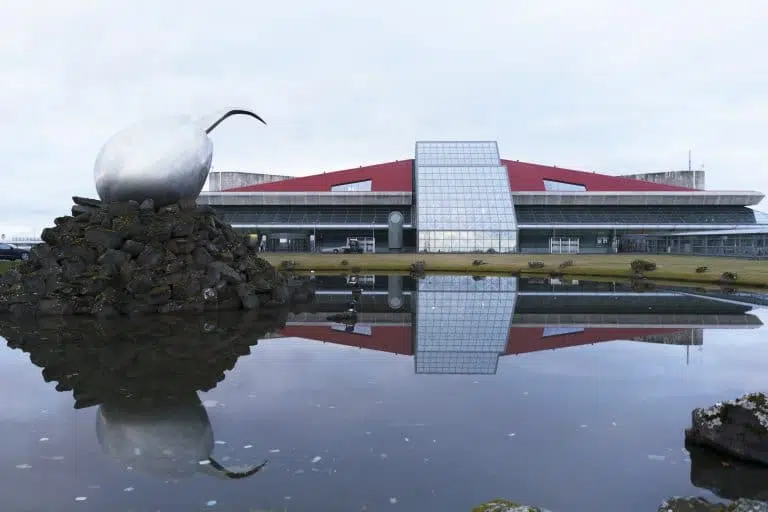
Traveller Walks 2.5 Hours to Keflavík International

VIDEO: Winter Returns to Iceland – Snowstorm in June
To provide the best experiences, we and our partners use technologies like cookies to store and/or access device information. Consenting to these technologies will allow us and our partners to process personal data such as browsing behavior or unique IDs on this site and show (non-) personalized ads. Not consenting or withdrawing consent, may adversely affect certain features and functions.
Click below to consent to the above or make granular choices. Your choices will be applied to this site only. You can change your settings at any time, including withdrawing your consent, by using the toggles on the Cookie Policy, or by clicking on the manage consent button at the bottom of the screen.

COMMENTS
15 days is more than ample time for you to visit Iceland's most popular attractions, with our itinerary covering such amazing locations as the Jökulsárlón glacier lagoon, Skaftafell nature reserve, the basalt columns of Reynisfjara, the Snæfellsjökull glacier, Hallormsstaðaskógur national forest, the Gullfoss waterfall, and many more.
Explore these self-drive Iceland camping vacations and lock in your next adventure. Search trips. Get a rental car and camping gear included. Relax worry-free in a safe outdoor environment. Meet locals and fellow travelers at campsites. Stay in Reykjavík for 1 night or more.
The ultimate Iceland camping adventure. Get truly close to nature on this 10-day camping tour around Iceland. With a rental car and camping gear included, you'll have everything you need to make the most of Iceland's outdoors. This itinerary will take you around most of the country, including the jaw-dropping south coast and unforgettable ...
Travel the full circle road around Iceland in 6 days and visit the best highlights the island has to offer, with an experienced…. Free cancellation. Recommended by 96% of travelers. from. $2,707. per adult. 14. Fagradalsfjall Volcano Hike Private Tour with a local guide. 180.
Get the facts on camping in Iceland. Find the camping sites throughout the country and all the information you will need for your Icelandic camping trip. Book your tours. ... Amazing 6-Day Northern Lights Winter Self-Drive Tour on Iceland's South Coast with Ice Caving; 5-Day Northern Lights Winter Self-Drive Tour with the Golden Circle ...
The Camping Card costs about USD 195, and campgrounds in Iceland tend to charge about 1000-2000 ISK (USD 8 -16) per person/night. So, as long as two adults are camping for 5-10 days, (for families it's even fewer days), the card is cheaper than booking individually at each campground.
Another cheap camping equipment rental is the lightweight waterproof pants rental for hiking and camping tours in Iceland. This camping equipment costs approximately 11 USD to hire. Alternatively, this affordable crampon rental for Icelandic adventures is perfect for all weather conditions. This unique camping equipment costs about 15 USD to rent.
Take a classic Iceland road trip, sleeping in the open air. Camp your way around Iceland's famous Ring Road on this 8-day summer tour. We provide the gear and a set of wheels, so you can focus on getting close to the country's spectacular nature. Get ready to pitch your tent and sleep under the midnight sun!
Discover hidden gems in the Westfjords, North Iceland, and Snæfellsnes peninsula. And of course, you'll also check out the top spots on Iceland's much-loved Ring Road. Get ready for an unforgettable road trip with jaw-dropping views at every turn. Travel style Camping. Trip length 14 days / 13 nights. Vibe Adventure.
In August, one of the most popular months for camping, the average temperature is 11°C (52°F). This can drop to around 7-9°C (45-48°F) at nighttime. In our Travel Guide, you can learn more about Iceland's weather and climate. The amount of shelter you have will make a big difference to how cold you feel.
Iceland's Laugavegur Trail. Location: Iceland Hiking Trips. Area: Iceland Hut to Hut Hiking Tours. Trip type: Hut to Hut Trekking Tour. Difficulty: Highlights: Most Iconic Iceland Hike, Stunning Landscapes, Hot Springs & Geysers …. 9 Days. from $4500.
The comfort temperature rating should be between -5 to 5ºC (23-41ºF) for those who plan to sleep in a tent. Those who decide to sleep in a campervan or motorhome should have a sleeping bag rated 5 to 10ºC (41-50ºF). Gear and clothing for camping trip in Iceland. A gas stove and cooking equipment.
About our Iceland vacations. See the Land of Fire and Ice your way with Iceland Tours. Dive into a wide range of vacations to Iceland with fun-packed itineraries, flexible booking terms, and just a 5% deposit! Choose from self-drive adventures, group trips, camping packages, multi-day tours from Reykjavík, and more.
Explore Iceland's biggest selection of tours and travel packages. Book your vacation in Iceland now with a best-price guarantee. Discover the best activities, excursion. ... Camping Tours & Equipment20 tours. Combo Deals84 tours. Cruises & Shore Excursions36 tours. Culture Tours182 tours. Day Tours in Iceland964 tours.
About Us. Arctic Adventures is the biggest adventure tour operator in Iceland. Our primary goal is to utilize our passions and strengths to bring you an incredible experience and a long-lasting impression of our beloved country. We operate many of our tours from the headquarters in Reykjavik but also have operation locations in Skaftafell ...
Iceland Express. Wendy · Traveled May 2024. Iceland was just beautiful. Plan to arrive a few days early or stay after in Reykjavik to explore the city and enjoy a swim in a lagoon. The 4 day trip was a relaxing way to see all of the stops, including waterfalls, lava fields, glaciers, and icebergs. Our guide Kolla was amazing.
Epic 13-Day Self-Drive Tour of Iceland's Complete Ring Road with Snaefellsnes Peninsula & Westfjords. Tour starts. Keflavík Airport. Starting time. Flexible. Duration. 13 days. ... Camping Tours & Equipment20 tours. Combo Deals84 tours. Cruises & Shore Excursions36 tours. Culture Tours181 tours. Day Tours in Iceland961 tours.
Happy Camper Van TOUR | Inside the Happy3. Watch on. Hey, Team Iceland. We just got back from one amazing week in the Happy Camper van exploring all around the Ring Road. We had amazing weather. The camper van was awesome. It took us to some of the most beautiful places in Iceland. So I thought it would be fun to give you a tour around the van ...
Glamping in Iceland provides a safe and convenient way to experience the country's natural wonders, especially for those who may not be accustomed to traditional camping. This makes it an ideal choice for families, couples, and solo travelers alike. In conclusion, glamping in Iceland offers a unique and unforgettable way to experience the ...
About our self-drive Iceland trips. Take the wheel on an Iceland self-drive adventure. Pass through lava fields, spot volcanoes and glaciers, and marvel at the spectacular coastline. Stop off at bubbling hot springs, thundering waterfalls, and cute fishing villages. Iceland is set up perfectly for a driving tour.
Icelandic Adventure tours : Reserve Your Journey Today. An Icelandic adventure promises a lifetime of memories, immersing you in the untouched natural beauty of this extraordinary country. Whether you're a trekker, hiker, or seeking cross-country exploration, Iceland invites you to experience its diverse landscapes.. The Laugavegur area is just one of the enchanting wonders awaiting you.
Escape the crowds and have miles of highway to yourself when you select one of our self drive tour packages. With Arctic Adventures, explore Iceland at your own pace, as fast or as slow as you wish, in the comfort of your very own rental car. Our packages are designed to cover everything, from car rental to accommodation, to the itinerary itself.
Ultimate Iceland Southcoast and Glacier Walk - Private Super-Jeep Departure 232.960 kr. AMAZINGTOURS was founded in 2004 and boasts of decades of experience and passion for travel in Iceland.
Iceland's capital offers stunning natural beauty, arty culture, geothermal wonders and the chance to see the Northern Lights. ... and the best deals on car hire and the most coveted tours. ... camping (1500-2500kr) or, if you're heading to the countryside, hiring a camper van where you can stay in the marked campgrounds most towns offer.
Camping Tours & Equipment20 tours. Combo Deals84 tours. Cruises & Shore Excursions36 tours. Culture Tours180 tours. Day Tours in Iceland960 tours. ... It depends on which northern lights tour in Iceland you choose. The most popular northern lights tours have departures from Reykjavik and only take a few hours. However, the longer tours can last ...
Bird-watching here is a great way to experience more of the area than you might on a normal day tour, as many tours of the Golden Circle may only stop briefly at Þingvellir. This area is fascinating from a cultural, historical, and natural perspective, so spending a day bird watching by Þingvallavatn is a good way to slow down and really see ...